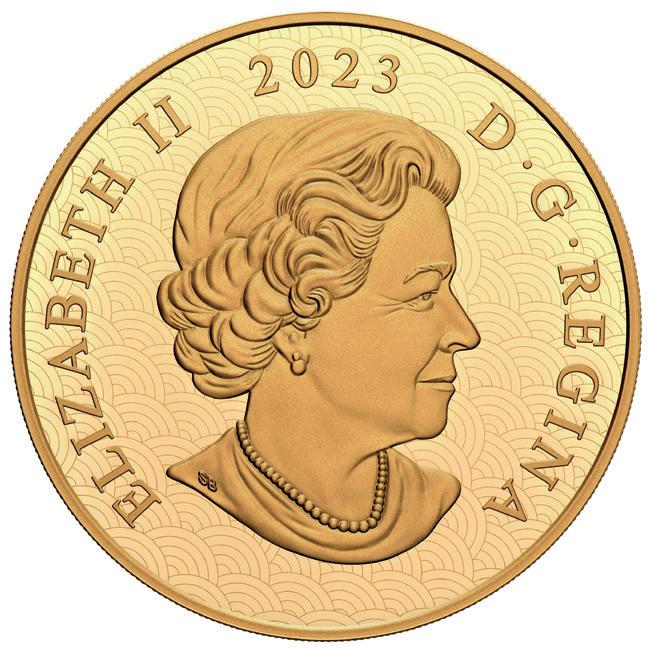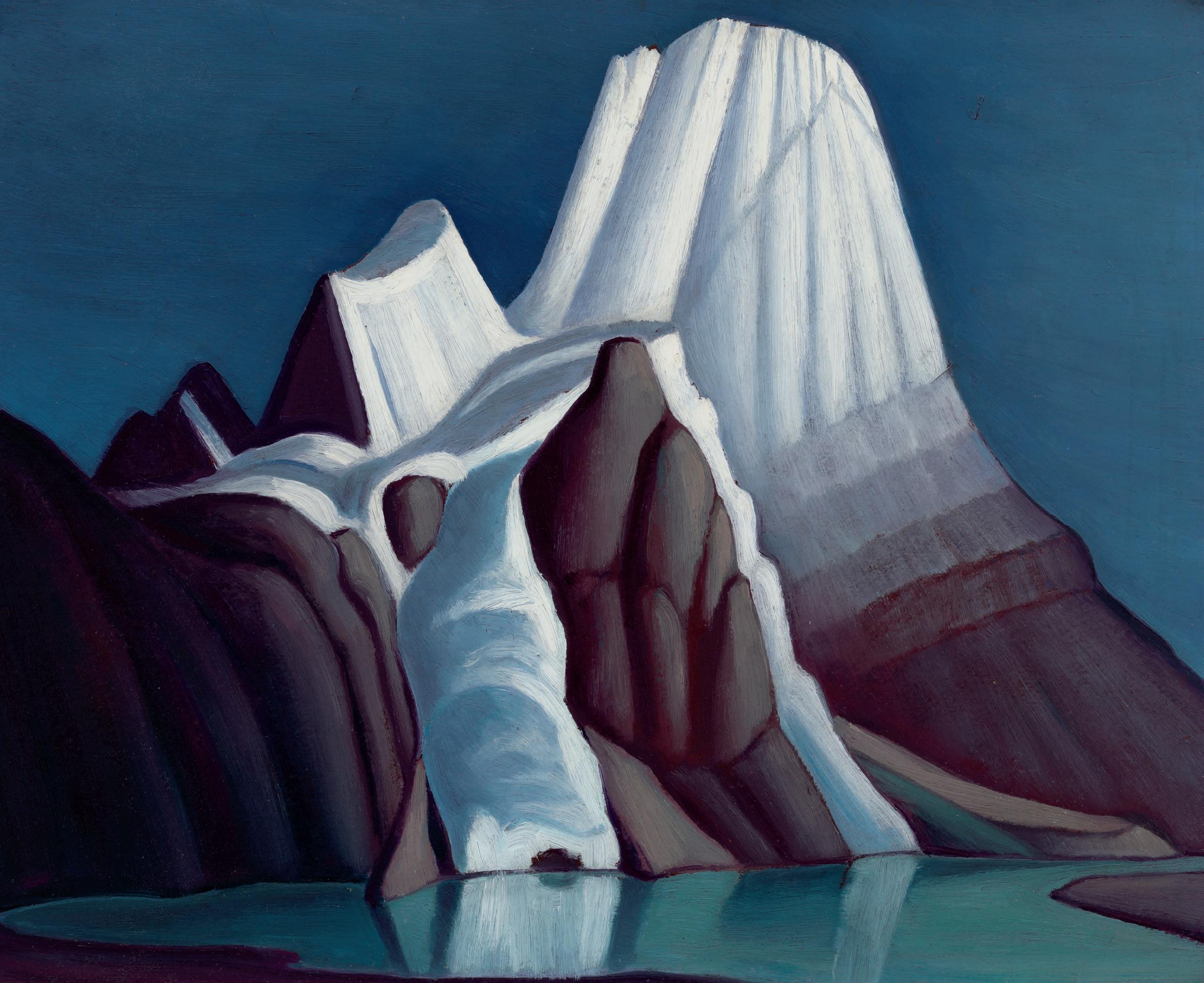












Thursday, November 24, 2022 Park Hyatt Hotel, Park Hyatt Ballroom
4 Avenue Road, Toronto Together with Heffel’s Digital Saleroom

Video Presentation
1:30 PM PT
4:30 PM ET Post-War & Contemporary Art
PM PT
PM ET
Canadian, Impressionist & Modern Art
PM PT
PM ET
Heffel Gallery, Vancouver
2247 Granville Street
Saturday, October 15 through Monday, October 24, 11 am to 6 pm PT
Galerie Heffel, Montreal
1840 rue Sherbrooke Ouest
Thursday, November 3 through Wednesday, November 9, 11 am to 6 pm ET
Heffel Gallery, Toronto
13 Hazelton Avenue
Together with our Yorkville exhibition galleries
Wednesday, November 16 through Wednesday, November 23, 11 am to 6 pm ET
Additionally herein referred to as “Heffel” or “Auction House”
Toll Free 1-888-818-6505 mail@heffel.com, www.heffel.com Please send all mail to our Vancouver address t oronto
Main Yorkville Reception
13 Hazelton Avenue, Toronto, ON M 5 R 2 E 1 Telephone 416-961-6505, Fax 416-961-4245
15 Hazelton Avenue, Unit 200, Toronto, ON M 5 R 2 E 1
135 Yorkville Avenue, Unit 401, Toronto, ON M 5 R 3 W 5
155 Yorkville Avenue, 2nd Floor, Toronto, ON M 5 R 1 C 4 o ttawa
451 Daly Avenue, Ottawa, ON K 1 N 6 H 6
Telephone 613-230-6505, Fax 613-230-6505
m ontreal
1840 rue Sherbrooke Ouest, Montreal, QC H 3 H 1 E 4 Telephone 514-939-6505, Fax 514-939-1100
v an C ouver
2247 Granville Street, Vancouver, BC V 6 H 3 G 1 Telephone 604-732-6505, Fax 604-732-4245
north v an C ouver
2455 Dollarton Highway, Unit 108 North Vancouver, BC V 7 H 0 A 2 Telephone 604-732-6505 ext. 150, Fax 604-732-4245 Calgary
Main Calgary Reception 888 4th Avenue SW, Unit 609, Calgary, AB T 2 P 0 V 2 Telephone 403-238-6505, Fax 403-265-4225
220 Manning Road NE , Unit 1080, Calgary, AB T 2 E 8 K 4
Corporate b ank
Royal Bank of Canada, 2735 Granville Street Vancouver, BC V 6 H 3 J 1 Telephone 604-665-5700
Incoming wires are required to be sent in Canadian funds and must include: Heffel Gallery Limited, 2247 Granville Street, Vancouver, British Columbia V 6 H 3 G 1 as beneficiary.
b oard of d ire C tors
Chairman In Memoriam—Kenneth Grant Heffel President—David Kenneth John Heffel Auctioneer License T 83-3364318 and #22-106727
Vice-President—Robert Campbell Scott Heffel Auctioneer License T 83-3365303 and #22-106726
Printed in Canada by Friesens
ISBN : 978-1-927031-56-8
Heffel com Departments
C onsignments consignments@heffel.com
a ppraisals appraisals@heffel.com
a bsentee, t elephone & online b idding bids@heffel.com s hipping shipping@heffel.com
s ubs C riptions subscriptions@heffel.com
Heffel Gallery Limited regularly publishes a variety of materials beneficial to the art collector. An Annual Subscription entitles you to receive our Auction Catalogues. Our Annual Subscription Form can be found on page 107 of this catalogue.
Essay Contributors—Alec Blair, Jim Burant, Daniel Gallay, Michèle Grandbois, Charles C. Hill, Ross King, Joan Murray, Rosalin Te Omra and Ian M. Thom Text Editing, Catalogue Production—Julia Balazs, David Heffel, Robert Heffel, Alec Kerr, Naomi Pauls, Tania Poggione and Rosalin Te Omra
Director of Imaging—Martie Giefert
Digital Imaging—Ward Bastian, Jasmin Daigle and Jared Tiller Catalogue Layout and Production—Kirbi Pitt and Clara Wong Catalogue Design—Peter Cocking
No part of this publication may be reproduced, stored in retrieval systems or transmitted in any form or by any means, digital, photocopy, electronic, mechanical, recorded or otherwise, without the prior written consent of Heffel Gallery Limited.


All photographic representations and other illustrations depicted are solely for guidance and are not to be relied upon in terms of tone or colour.
Park Hyatt Ballroom
4 Avenue Road, Toronto
Together with Heffel’s Digital Saleroom Saleroom Telephone 1-888-212-6505
To attend the auction or bid in person, please contact bids@heffel.com to reserve your seat and register in advance. Complimentary food and beverages will be served in the ballroom.
The Buyer and the Consignor are hereby advised to read fully the Terms and Conditions of Business and Catalogue Terms, which set out and establish the rights and obligations of the Auction House, the Buyer and the Consignor, and the terms by which the Auction House shall conduct the sale and handle other related matters. This information appears on pages 98 through 106 of this publication.
Please visit www.heffel.com for information on which Lots will be present at each preview location, virtual auction previews and to book your in person preview appointment. Preview appointments can also be booked by calling 1-888-818-6505.
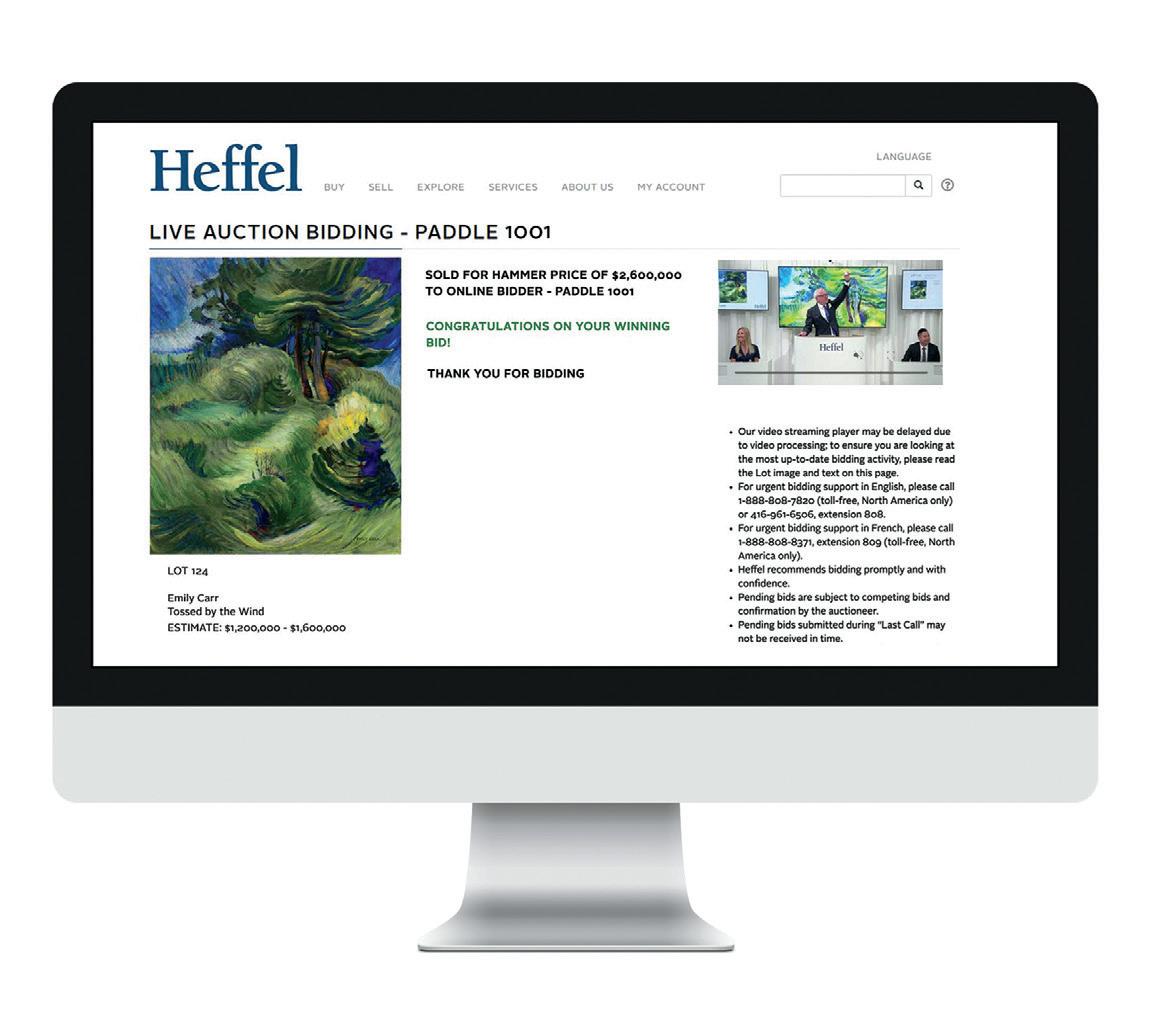
If you are unable to attend our auction in person, Heffel recom mends submitting an Absentee Bid Form to participate. Heffel also accepts telephone bidding, prioritized by the first received Tele phone Bid Form and limited to available Telephone Bid Operators per Lot. Alternatively, Heffel offers online bidding in real time through our Digital Saleroom, subject to advanced registration and approval. All forms of remote bidding participation and reg istration must be received by Heffel at least two (2) business days prior to the commencement of the sale. Information on absentee, telephone and online bidding appears on pages 5, 108, 109 and 110 of this publication.
Please note that we produce a live stream of our sale beginning with a video presentation at 4:30 PM ET and the auction commencing at 5 PM ET. We recommend that you test your video streaming 30 minutes prior to our sale at: www.heffel.com
All Lots and additional images depicting the frame and verso are available at www.heffel.com.
Our Estimates are in Canadian funds. Exchange values are subject to change and are provided for guidance only. Buying 1.00 Canadian dollar will cost approximately 0.72 US dollar, 0.75 euro, 0.66 British pound, 0.70 Swiss franc, 102 Japanese yen or 5.2 Hong Kong dollars as of our publication date.
Heffel offers individuals, collectors, corporations and public entities a full-service firm for the successful de-acquisition of their artworks. Interested parties should contact us to arrange for a private and confidential appointment to discuss their pre ferred method of disposition and to analyse preliminary auction estimates, pre-sale reserves and consignment procedures. This service is offered free of charge.
If you are from out of town or are unable to visit us at our premises, we would be pleased to assess the saleability of your artworks by mail, courier or e-mail. Please provide us with pho tographic or digital reproductions of the artworks front and verso and information pertaining to title, artist, medium, size, date, provenance, etc. Representatives of our firm travel regularly to major Canadian cities to meet with Prospective Sellers.
It is recommended that property for inclusion in our sale arrive at Heffel at least 90 days prior to our auction. This allows time to photograph, research, catalogue and promote works and complete any required work such as re-framing, cleaning or con servation. All property is stored free of charge until the auction; however, insurance is the Consignor’s expense.
Consignors will receive, for completion, a Consignment Agree ment and Consignment Receipt, which set forth the terms and fees for our services. The Seller’s Commission is the amount paid by the Consignor to the Auction House on the sale of a Lot, which is calcu lated on the Hammer Price, at the rates specified in writing by the Consignor and the Auction House on the Consignment Agreement, plus applicable Sales Tax. Consignors are entitled to set a mutu ally agreed Reserve or minimum selling price on their artworks.
All items that are offered and sold by Heffel are subject to our published Terms and Conditions of Business, our Catalogue Terms and any oral announcements made during the course of our sale. Heffel charges a Buyer’s Premium calculated on the Hammer Price as follows: a rate of twenty-five percent (25%) of the Hammer Price of the Lot up to and including $ 25,000; plus twenty percent (20%) on the part of the Hammer Price over $ 25,000 and up to and including $ 5,000,000; plus fifteen percent (15%) on the part of the Hammer Price over $ 5,000,000, plus applicable Sales Tax.
If you are unable to attend our auction in person, you can bid by completing the Absentee Bid Form found on page 108 of this catalogue. Please note that all Absentee Bid Forms should be received by Heffel at least two (2) business days prior to the commencement of the sale. Bidding by telephone, although limited, is available. Please make arrangements for this service well in advance of the sale. Telephone lines are assigned in order of the sequence in which requests are received. We also recom mend that you leave an Absentee Bid amount that we will execute on your behalf in the event we are unable to reach you by tele phone. Digital Saleroom online bidding is available subject to pre-registration approval by the Auction House at least two (2) business days in advance of the auction.
Payment must be made by: a) Bank Wire direct to the Auction House’s account, b) Certified Cheque or Bank Draft, c) a Per sonal or Corporate Cheque, d) Debit Card and Credit Card only by Visa, Mastercard or Union Pay or e) Interac e-Transfer. Bank
Wire payments should be made to the Royal Bank of Canada as per the account transit details provided on your invoice. All Cer tified Cheques, Bank Drafts and Personal or Corporate Cheques must be verified and cleared by the Auction House’s bank prior to all purchases being released. Credit Card payments are subject to our acceptance and approval and to a maximum of $ 5,000 if the Buyer is providing their Credit Card details by fax or to a maximum of $ 25,000 per Lot purchased if paying online or if the Credit Card is presented in person with valid identification. The Buyer is limited to two e-Transfers per Lot and up to a maximum of $ 10,000 per e-Transfer as per the instructions provided on your invoice. In all circumstances, the Auction House prefers payment by Bank Wire.
Bidding typically begins below the low estimate and generally advances in the following bid increments:
$ 50 300 $ 25 increments
$ 300 500 $ 50
$ 500 2,000 $ 100
$ 2,000–5,000 $ 250
$ 5,000–10,000 $ 500
$ 10,000–20,000 $ 1,000
$ 20,000–50,000 $ 2,500
$ 50,000–100,000 $ 5,000
$ 100,000–300,000 $ 10,000
$ 300,000–1,000,000 $ 25,000
$ 1,000,000–2,000,000 $ 50,000
$ 2,000,000–3,000,000 $ 100,000
$ 3,000,000–5,000,000 $ 250,000
$ 5,000,000–10,000,000 $ 500,000
$ 10,000,000+ $ 1,000,000
As a Consignor, it may be advantageous for you to have your art work re-framed and/or cleaned and conserved to enhance its saleability. As a Buyer, your recently acquired artwork may demand a frame complementary to your collection. As a full-service orga nization, we offer guidance and in-house expertise to facilitate these needs. Buyers who acquire items that require local delivery or out-of-town shipping should refer to our Shipping Authorization Form for Property on page 111 and our Terms and Conditions for Shipping on page 112 of this publication. Please feel free to con tact us to assist you in all of your requirements or to answer any of your related questions. Full completion of our shipping form is required prior to purchases being released by Heffel.
Written valuations and appraisals for probate, insurance, family division and other purposes can be carried out in our offices or at your premises. Appraisal fees vary according to circumstances. If, within five years of the appraisal, valued or appraised artwork is consigned and sold through Heffel, the client will be refunded the appraisal fee, less incurred “out of pocket” expenses on a prorated basis.


The Banting Research Foundation
The Family of Norah Lyle
The Collection of Angus and Cathy MacNaughton, California
The Victoria Foundation
A Prestigious Corporate Collection
other Important Private and Corporate Collections
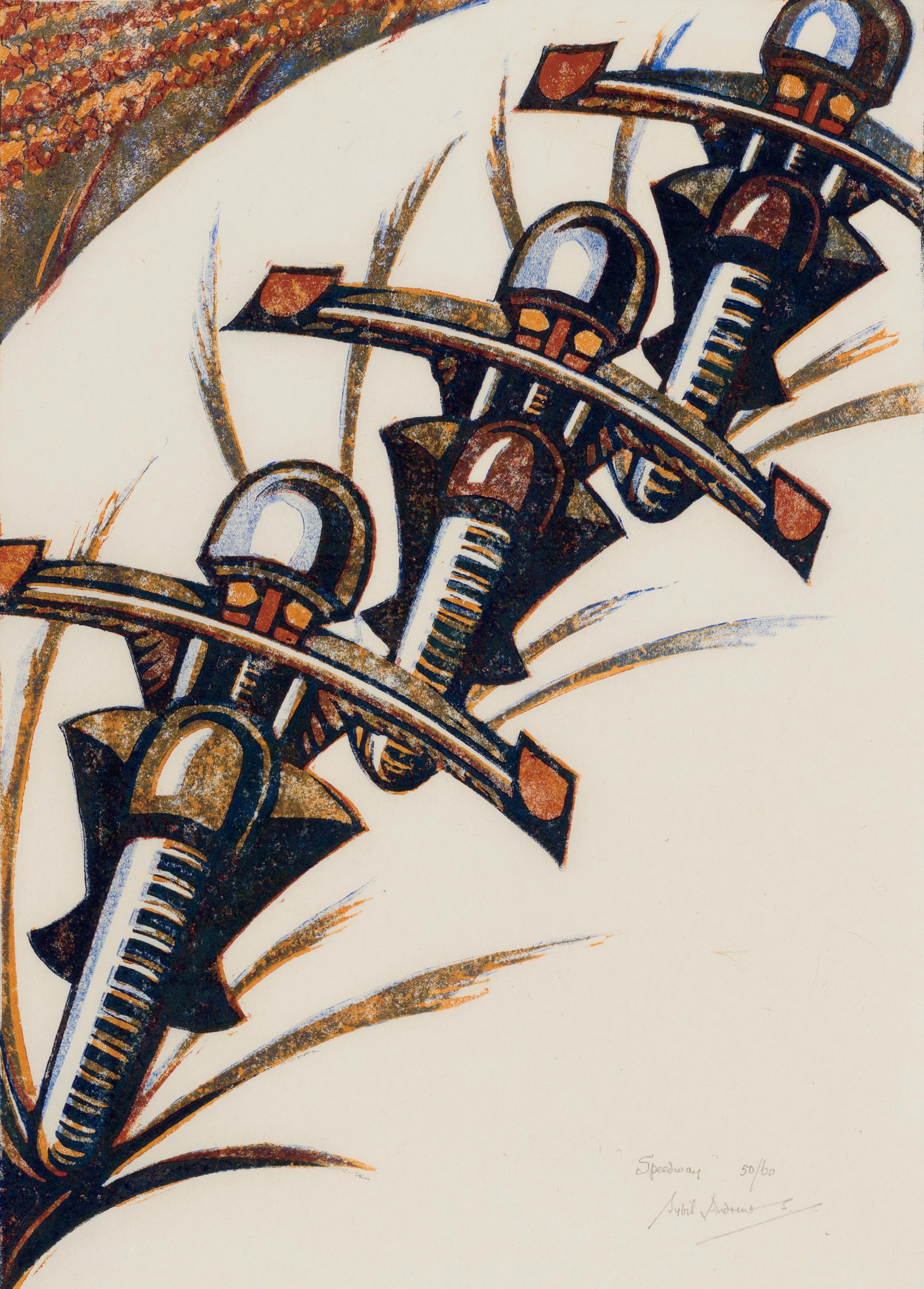
linocut in 4 colours, signed, titled and editioned 50/60, 1934 12 7/8 × 9 1/4 in, 32.7 × 23.5 cm
p rovenan C e Collection of the Artist
Private Collection, Victoria, 1981
Victoria Foundation, Victoria, by donation
l iterature
Susan Mertens, “Sybil’s Great Splash with Art,” Vancouver Sun, January 16, 1982, front page of the Entertainment section, unpaginated
Peter White, Sybil Andrews, Glenbow Museum, 1982, reproduced page 37, full page colour, and page 57
Stephen Coppel, Linocuts of the Machine Age, 1995, page 114, reproduced front cover and page 114
Clifford S. Ackley, editor, Rhythms of Modern Life: British Prints, 1914 – 1939 , Museum of Fine Arts, Boston, 2008, reproduced page 81, a detail image reproduced page 188 and the four linoleum blocks for Speedway reproduced page 193
Hana Leaper, Sybil Andrews Linocuts: A Complete Catalogue, Osborne Samuel Gallery, 2015, reproduced page 76
Janet Nicol, On the Curve: The Life and Art of Sybil Andrews, 2019, reproduced page 48
Glenbow Museum, Calgary, Sybil Andrews, 1982, same image, catalogue #29
Museum of Fine Arts, Boston, Rhythms of Modern Life: British Prints, 1914 – 1939 , January 3 – June 1, 2008, traveling in 2008 to the Metropolitan Museum of Art, New York, same image, catalogue #30, and the four linoleum blocks for Speedway, in the collection of the Glenbow Museum, exhibited catalogue #14-107
Glenbow Museum, Calgary, Sybil Andrews: Art and Life, October 19, 2019 – January 12, 2020, same image
B ORN IN B UR y St. Edmunds, England, Sybil Andrews produced drawings, watercolours, monoprints and oil paintings, but it is her linocuts for which she is most famous, and she attained international acclaim for them. Speedway is considered one of her finest linocuts.
During World War I, Andrews worked making airplane parts in Coventry, and after the war she returned to Bury St. Edmunds, where she met architect Cyril Power. In 1922, at the age of 24, Andrews left Bury St. Edmunds with Power (who was almost 50) to study art at the Heatherley School of Fine Art in London. Three years later, Power and Andrews were appointed by Ian Macnab to staff his newly established Grosvenor School of Modern Art, with Andrews becoming the school secretary.
In 1926, while at the Grosvenor School, Andrews and Power met Claude Flight, who taught them how to cut and print from linoleum blocks (a new art form at the time). Andrews com mented in a 1982 newspaper article: “There was no accepted way of treating the block, so we were all experimenting. We didn’t know what effects would be achieved until we had actually printed them. As you can imagine, many of the blocks ended up in the wastebasket.”
From 1930 to July 1938, Andrews and Power shared a small studio at 2 Brook Green in Hammersmith, London, and devel oped a common aesthetic in their work. This informal working partnership produced an extraordinary body of work—some of the finest prints of the 1930s. It was a period of widespread change, when new materials such as linoleum emerged, a period when art, industrial design, architecture and fashion design were transformed. Andrews’s themes were of the dynamism of the modern machine age and the movement of the human figure at work or sport, usually executed using only four linoleum blocks. In total, Andrews produced an incredibly consistent body of 76 linocuts, of which 43 were made from 1929 to 1939—con sidered her best period—when she shared the studio with Power. Andrews’s linocuts are acclaimed to have surpassed those of her teacher Flight, and in fact many consider Andrews to be the most gifted of the Grosvenor School artists.
Speedway is Andrews’s most important and highly soughtafter linocut. Its importance is reflected in the fact that this work was chosen for the front cover from all the works of the seven Grosvenor School artists profiled in Stephen Coppel’s catalogue raisonné Linocuts of the Machine Age Speedway was created when Andrews was still in London and working in the Brook Green studio. Coppel wrote, “This image of motor-bike trials was origi nally conceived as a poster commission for the London Passenger Transport Board in the 1930s, although no poster was ever made.” This print embodies the dynamism of machine-age speed that fascinated the modern world.
This is a very fine impression on cream fibrous oriental laid paper.
The consignor proceeds for this work will benefit the Victoria Foundation. Established in 1936, the Victoria Foundation is Canada’s second oldest community foundation and the sixth largest of over 200 nationwide. The Victoria Foundation man ages charitable gifts from donors whose generosity allows them to create permanent income-earning funds. The proceeds from these funds are then distributed as grants for charitable or edu cational purposes. To date the Victoria Foundation has invested over $ 287 million in people, projects and non-profit organizations that strengthen communities in BC and throughout Canada.
e stimate: $ 70,000 – 90,000
I N 1921 , fRE d ERICK G . BANTING and Charles H. Best discov ered insulin at the University of Toronto, and forever altered medical history. In addition to his medical research, Dr. Banting was an accomplished artist, whose works, including The Lab (1925), sold by Heffel in November of 2018, are collected globally. In the same year as The Lab was painted, the Banting Research Foundation was established to support health and biomedical research in Canada, and almost 100 years later, it is still com mitted to this goal. Seeking out important emerging research conducted by early career health scientists in Canada, the Banting Research Foundation has supported over 1,350 research ers with funds totaling $ 8.6 million through grants such as the Discovery Award Program, its annual peer-reviewed competition.
Heffel is honoured to partner with the Banting Research Foun dation by offering two exceptional works by Dr. Banting from its collection in support of the foundation’s important fundraising goals. This year marks the centennial of the first successful injec tion of insulin, to 14-year-old Leonard Thompson at Toronto General Hospital, and the Banting Research Foundation looks forward to supporting the next century of world-changing medical advances.

1891 – 1941
Penetang oil on board, signed and on verso signed, titled, dated 1930 and inscribed To Nancy, Sincerely, F.G. Banting 8 1/8 × 10 1/2 in, 20.6 × 26.7 cm

p rovenan C e
A gift from the Artist to Nancy Archer, Toronto and United Kingdom
By descent to Betty Archer, United Kingdom Banting Research Foundation, Toronto, by anonymous gift, 2010
P ENETANGUISHENE , SOMETIMES SHORTENE d to Penetang, is a town in Ontario’s Simcoe County, on the southern shores of Georgian Bay. Frederick Banting may have been introduced to the area as a painting location by his friend and sometimes
sketching partner A.Y. Jackson, a member of the Group of Seven, who frequented the region as early as 1913. This oil sketch shows Banting to be a gifted landscape artist with a sure eye for compo sition and a keen sense of colour, confidently capturing a bucolic autumnal scene with striking authenticity.
Banting’s inscription on verso is also noteworthy. Painstaking research on the part of the Banting Research Foundation revealed that the first owner of this painting, Nancy Archer, was employed as Dr. Banting’s housekeeper at his home at 46 Bedford Road, Toronto, in 1930 and 1931. The gift of this painting to Archer, along with a kind inscription, is very much in keeping with Ban ting’s generous reputation with regard to his artwork. Archer returned to her native England in the early 1930s, and after she passed this work on to her younger sister Betty, Penetang, along with Quebec Village, lot 103 in this sale, was anonymously gifted to the Banting Research Foundation in 2010.
e stimate: $ 15,000 – 25,000

1941
Quebec Village oil on board, on verso inscribed 700/5996
8 1/8 × 10 1/2 in, 20.6 × 26.7 cm p rovenan C e
A gift from the Artist to Nancy Archer, Toronto and United Kingdom
By descent to Betty Archer, United Kingdom
Banting Research Foundation, Toronto, by anonymous gift, 2010
l iteratureA.Y. Jackson, A Painter’s Country: The Autobiography of A.Y. Jackson, 1958, page 62
“Bigger and better snow drifts” is Banting’s slogan. We went for a short-cut through the woods yesterday and that nearly cured him. We did not have our snowshoes, and we sank in the snow up to our waists. No newspapers, no radio and only enough water to wash once a day and yet we are happy.
A .y. JACKSON, letter to Dr. James MacCallum
fRE d ERICK B ANTING ORIGINA lly sought out Group of Seven member A.Y. Jackson because of the work he produced as an offi cial war artist. Banting had also served in World War I and was awarded the Military Cross, one of the British Empire’s highest military honours. Banting was seeking to engage with his fellow serviceman but was also keen to explore his own artistic inclina tions. This led to a warm friendship and sketching trips around Ontario, to the Arctic, and to the rural areas of Quebec’s Charlev oix region, shown here. With a discerning eye, Banting gives voice to the artistic aspects of his nature, carefully capturing the rustic qualities of these simple homes and rolling hills.

104 Alexander Young (A.Y.) Jackson ALC CGP G7 OSA RCA RSA 1882 – 1974
Road to St. Tite des Caps oil on board, signed and on verso titled, circa 1930 8 1/2 × 10 1/2 in, 21.6 × 26.7 cm
Important Canadian Paintings, Drawings, Watercolours, Books and Prints of the 19th and 20th Centuries, Sotheby Parke Bernet Canada Inc., May 14, 1979, lot 15
Private Collection, British Columbia literature
A.Y. Jackson, “There’s Still Snow in Quebec,” The Tangent: An Annual, Ontario College of Art, May 1929, page 46 A.Y. Jackson, A Painter’s Country: The Autobiography of A.Y. Jackson, 1958, pages 63 and 64
T HROUGHOUT THE 1920 S , in the early spring, A.Y. Jackson would set out on the “artist trails” that connected the villages on the north and south shores of the St. Lawrence River. He would paint the small villages hugging the shores of the St. Lawrence, with houses clustered around a church, or with snowbound streets running between the colourful frame houses. Jackson rem inisced, “One of the places we loved to paint was St. Tite des Caps on Cap Tourmente, a high plateau, forty miles below Quebec. It was not one of the old villages, but it lay in a hollow encircled by hills, and we could look down on it from several direc tions.” Jackson’s first visit there was in April of 1928 with artists Randolph Hewton and Albert Robinson, and he returned in 1930, 1934, 1937, 1941 and 1946, such was his regard for the location.
Jackson was attracted to depicting rural architecture in the surrounding landscape, capturing old farmhouses settled into the curves of the hills, and he was particularly fond of the old weather-worn barns with their sagging roofs. He treasured these buildings—as time went on, houses and barns were torn down, which he lamented. As Jackson was there in late winter / early spring, the changing conditions of the snow captured his atten tion—as he recounted, “the sun and the wind continually changed its colour and texture. Towards spring there was slush and pools of water, and finally the furrowed fields appeared through the
slush.” Jackson was so sensitive to the landscape that he painted that he was aware how the direction of the wind affected the atmosphere and colour, stating:
The south wind is pleasant and soft, but it is seldom one gets clean color with it. The east wind is raw, and generally comes with colorless days—hills twenty miles away seem as sharp and hard as objects in the foreground. The south-west wind can be very fine, boisterous and soul-stirring, tossing masses of clouds across the sky, and playing with lights and shadows over the landscape. But the west wind is the good old stand-by. Blue skies and cooler blue shadows on the snow, and everything radiant with color, particularly when there is a little north in it. The pure, undiluted north is sparkling, but with unsympathetic blue and violets, so clear they make the palette look like mud.
Jackson would often trek about on snowshoes, setting off into the cold air with his sketch box to paint his scenes en plein air, risking freezing fingers and solidifying oil paints, as well as the distraction of curious villagers. Jackson boarded with families or stayed in small hotels in the villages, immersing himself in the warm atmosphere. While in Saint-Tite-des-Caps, Jackson stayed in a ramshackle old hotel, and he wrote approvingly of proprietor Madame Tremblay’s homemade meals, in particular praising her pea soup.
Jackson’s depictions of villages such as this are among his most beloved works. He captures their unique charm—in this oil sketch he includes the iconic image of a horse and sleigh hav ing just crossed a small bridge, with another one further up the road. Telephone poles follow the road, the one in the foreground resembling a cross form. On house roofs, patches of snow indi cate the start of melting. The scene has a rolling rhythm, from the curve of the road to the rounded forms of snowbanks and hills. The use of luscious pastel highlights in the snow reflects Jackson’s early exposure to Impressionism during studies in Paris. He lays down mauve, pale blue, yellow and pink tones with a loaded brush. Even the overcast sky has yellow and salmon tones. Jackson had a great affection for this subject, and Road to St. Tite des Caps is an exquisite Group of Seven period work from this renowned part of Jackson’s oeuvre.
e stimate: $ 25,000 – 35,000
watercolour on paper, on verso titled by Patsy Milne and inscribed 273 c by the Duncan Estate, 1914 18 × 17 3/8 in, 45.7 × 44.1 cm
Acquired from the above by a Private Collection, Toronto, 1976 Canadian Art, Joyner Fine Art, December 7, 1999, lot 51 Private Collection, Toronto
David P. Silcox, Painting Place: The Life and Work of David B. Milne, 1996, pages 48, 49 and 60 David Milne Jr. and David P. Silcox, David B. Milne: Catalogue Raisonné of the Paintings, Volume 1: 1882 – 1928 , 1998, reproduced page 126, catalogue #105.99
B ORN IN B RUCE COUNT y, ONTARIO , David Milne ambitiously enrolled at the Art Students League of New York in 1903, at age 21. When he left the school in 1906, he stayed on in the city, working as an illustrator. By 1909 he had committed to being a painter, and he progressed rapidly. Milne lived in New York City until 1916, and it was a tremendously creative time for him.
In the summer of 1914, Milne and his wife Patsy took a sum mer holiday in West Saugerties, north of New York, where this work was executed. Milne’s work at this time was innovative and accomplished. He had absorbed influences from the earlytwentieth-century School of Paris—Impressionism, PostImpressionism and Fauvism. Milne wrote that at Alfred Stieglitz’s 291 gallery in Manhattan, “we met Cezanne, van Gogh, Gaugin, Matisse, Brancusi. For the first time, we saw courage and imag ination bare, not sweetened by sentiment and smothered in technical skill.”
Milne exhibited five paintings in the prestigious Armory Show of 1913 in New York, in the company of works by the international avant-garde of the day, such as Paul Cézanne, Édouard Vuillard and Henri Matisse. The latter’s influence on Milne seems clear— especially his interior portraits of Madame Matisse. David Silcox
related, “In later years Milne said that one might see a painting like Matisse’s The Red Studio for just a second, through a crack in a door, and be influenced for one’s whole life.”
Milne had become a master of watercolour. By 1914, he was showing regularly with the New York Water Color Club, the American Water Color Society and the Pennsylvania Academy of the Fine Arts, among others. His work received critical acclaim— his paintings in the 1914 New York Water Color Club exhibition were praised by critics, including a reviewer in the New York Times. One newspaper wrote: “Mr. Milne does his work as much with white spaces as with spots of color, and his work is so systematic that the word schematic comes into your mind . but . he gov erns his scheme instead of being governed by it, and his work is always brilliant and beautiful.”
In Gay Fabric, the sitter is Milne’s wife Patsy, whom he married in 1912; she appears often in his work around this date. There is a strong contrast between the energetic, riotous colour of the watercolour and the meditative pose of the sitter reading her book. As in Matisse’s work The Red Studio, the objects in the painting hover against the green and black colour-field zones. Milne defines his forms by coloured outlines. For instance, he sketches in the parameters of the couch with a blue outline, loosely defining its substance by circles and marks, which create a diffuse pattern. This effect serves to push forward the dark form of the sitter, with her velvety black dress and cobalt shawl. Milne joins her to the background table by making her skin the same hue of orange brown, and tethers her feet spatially to the floor by strokes of black. In spite of this, the predominant impression is that the sitter is hovering, due to the two-dimensional render ing of the couch. The artist leaves slivers of white paper showing throughout, creating a patterning that pulls the eye to the surface. Along with other pale areas like the book and the top of the couch, these slivers of white bring light into the watercolour. In all of this, Milne shows his highly sophisticated understanding of spatial effects.
In Gay Fabric, Milne’s visual awareness and intelligence is arresting. The artist emancipates his subject from the specificity of a personal portrait into the universality of a modernist painting that is about colour, light and space. e stimate: $ 60,000 – 80,000


Captain Jack’s House watercolour on paper, signed and on verso titled on the gallery label and inscribed variously on the paper sheet, 1929 16 1/2 × 14 1/2 in, 41.9 × 36.8 cm
The Fine Art Galleries, T. Eaton Co. Ltd., Toronto Highly Important Sale by Auction, Waddington’s, May 30, 1985, lot 938
By descent to the present Private Estate, Ontario
l iterature
Doris Shadbolt, Emily Carr, 1990, page 50
I N 1929 , E MI ly CARR traveled to Nootka Sound, on the west coast of Vancouver Island. She took a train to Port Alberni, where she boarded a steamer that took her down Alberni Inlet to the Pacific Ocean and then 95 miles up the west coast to Nootka Island, landing at Yuquot (Friendly Cove). Yuquot, which means “where the winds blow from all directions,” was an important location for the people of Nootka Sound to come together. It was a headquarters, like a parliament, and all the tribes had big houses there, with the highest ranking in the centre and others arrayed along the beach. It was also the site of the first encounters of Spanish explorers and Captain James Cook with Indigenous peoples. Yuquot was an important trading centre, and at its height, it had 1,500 inhabitants.
Captain Jack was a high-ranking hereditary chief of the Mowa chaht Band in the 1920s and 1930s in Yuquot. In 1924, when Lieutenant-Governor Walter Cameron Nicol went to Yuquot to unveil a memorial to Captain Cook, Captain Jack used the oppor tunity to give a speech protesting the potlatch ban. On the first visit to Yuquot in 1929 by Governor General Freeman-Thomas, Earl of Willingdon, a pole carved for Captain Jack was given to Freeman-Thomas, who then intended to ship the pole to Rideau Hall in Ottawa. However, technically, he was then participating in a potlatch (the giving away of goods for free), a ceremonial practice outlawed at that time. If Freeman-Thomas had kept the pole, he would have been guilty of an offence which carried a jail term. However, Captain Jack and the village never expected him to accept the pole outright. It was given in the old potlatch under standing—a gift to be received and returned. Given the dispute and the high cost of transportation, Freeman-Thomas decided in the end to leave the pole in the village.
Captain Jack’s house was recorded as being in the centre of the village, with his pole in front of it, and Carr painted this pole and the interior of the house, with its richly carved inside posts. However, the house that Carr depicts here is at the far end of the village, near a bluff. Research identifies the house as belonging to the Maltsasath, the 13th ranked chiefly family of the Mowachaht, who had the rights to build houses at the north end of the village adjacent to the rock bluff. Nevertheless, this work is titled Captain Jack’s House on the T. Eaton Co. Ltd. gallery label.
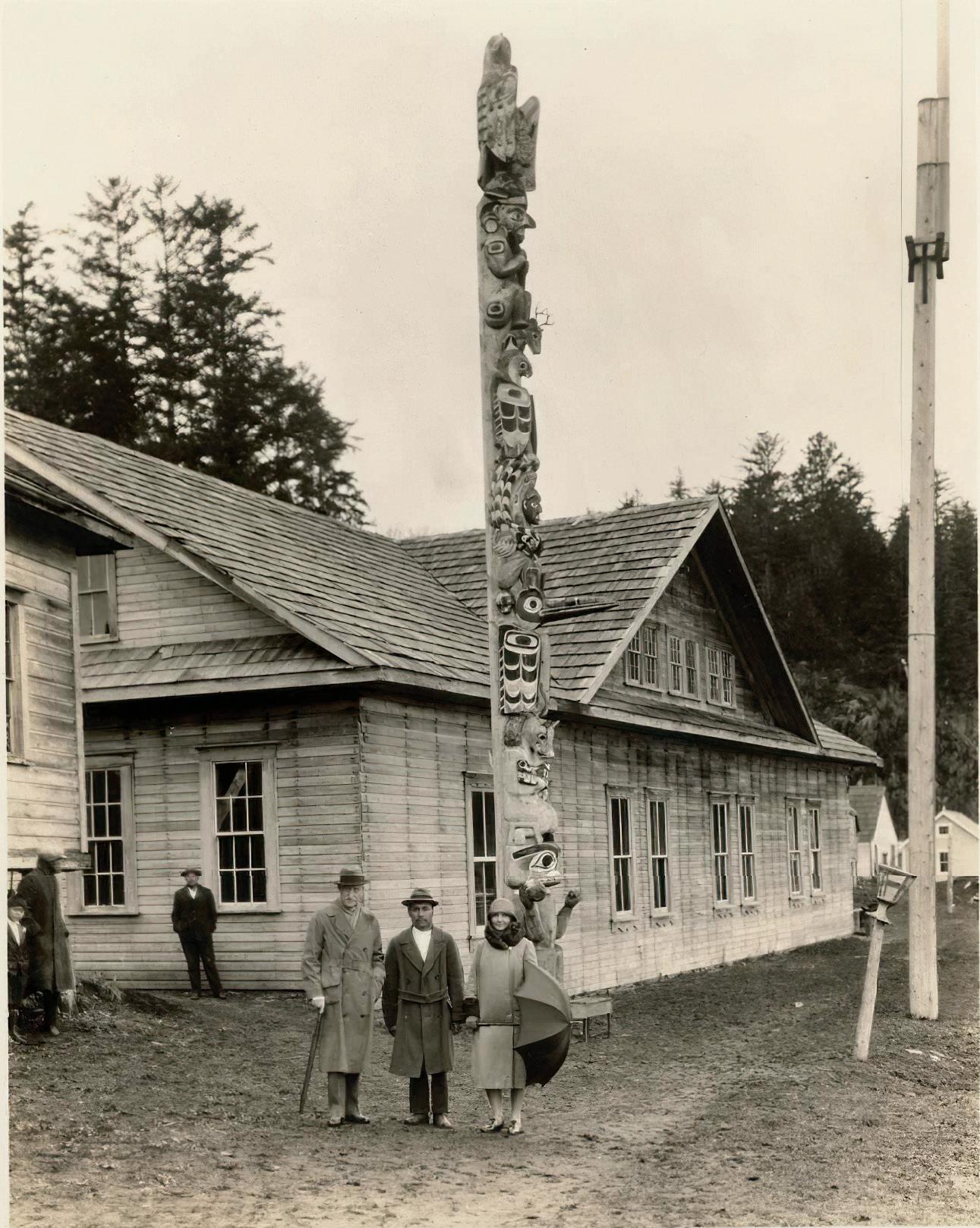
This striking watercolour has a similar approach to that of the important 1929 canvas entitled Church in Yuquot Village (collec tion of the Art Gallery of Ontario, bequest of Charles S. Band), also produced from Carr’s sketching on site. Both buildings are
white and shown as isolated in the woods, although they both face the unseen beach. No people are near, and the white build ings stand in stark contrast to the wall of vegetation behind. Church in Yuquot Village shows the influence of Cubism in its depiction of the forest, and although this style is looser and not so defined in the watercolour, it is there in the upper left, in the geometry of v-shaped slashes.
In 1928, American artist Mark Tobey came to Victoria to give a course in painting in Carr’s studio, and he advised her to “get off the monochrome, even to exaggerate light and shade, to watch rhythmic relations . . . ,” in the words of Doris Shadbolt. You can see the effect of his advice in this watercolour. Rather than the dark, enfolded forests she depicted in the past, Carr’s treatment of the forest is very light and free, with rhythmic squiggles and loose brushwork. The scene glows with illumination—from the light golden foreground and the yellow tones in the bushes either side of the house, which glows white in the centre. Captain Jack’s House is a fascinating record of this significant Indigenous com munity, and of Carr’s respect for and desire to capture the vibrant life of the village. This house stands like a glowing icon in the natural beauty of its setting.
e stimate: $ 125,000 – 175,000
oil on board, signed and dated indistinctly and on verso inscribed indistinctly 27 × 33 3/4 in, 68.6 × 85.7 cm
R EGINA S EI d EN STU d IE d under William Brymner and Maurice Cullen at the Art Association of Montreal, and she continued her studies in Paris, at the Académie Julian, from 1921 to 1922. She was a founding member of Montreal’s Beaver Hall Group and in 1924 exhibited at the influential British Empire Exhibition in Wembley, England. The National Gallery of Canada was an early supporter, acquiring three of her paintings. In 1928, she married
well-known artist Eric Goldberg and, as she became involved with supporting his career, stopped painting. But she taught art at the couple’s Westmount synagogue for 20 years. Seiden’s contri butions to early modernism have been recognized in recent years in the 2016 exhibition 1920s Modernism in Montreal: The Beaver Hall Group, at the Montreal Museum of Fine Arts.
Marketplace is a complex composition that uses interesting juxtapositions of geometric forms—round cartwheels, rectan gles of windows in the buildings and in the table supports, as well as triangular forms in the awnings. The painted surfaces of the buildings and the open square are softly brushed and exqui sitely modulated in a palette of predominantly earth tones, with highlights of red and orange. In this splendid large oil, Seiden deftly captured the peaceful yet vibrant atmosphere of this urban market.
e stimate: $ 20,000 – 30,000

Market in Winter, Berthierville, Quebec oil on board, signed, circa 1924 9 × 12 1/4 in, 22.9 × 31.1 cm
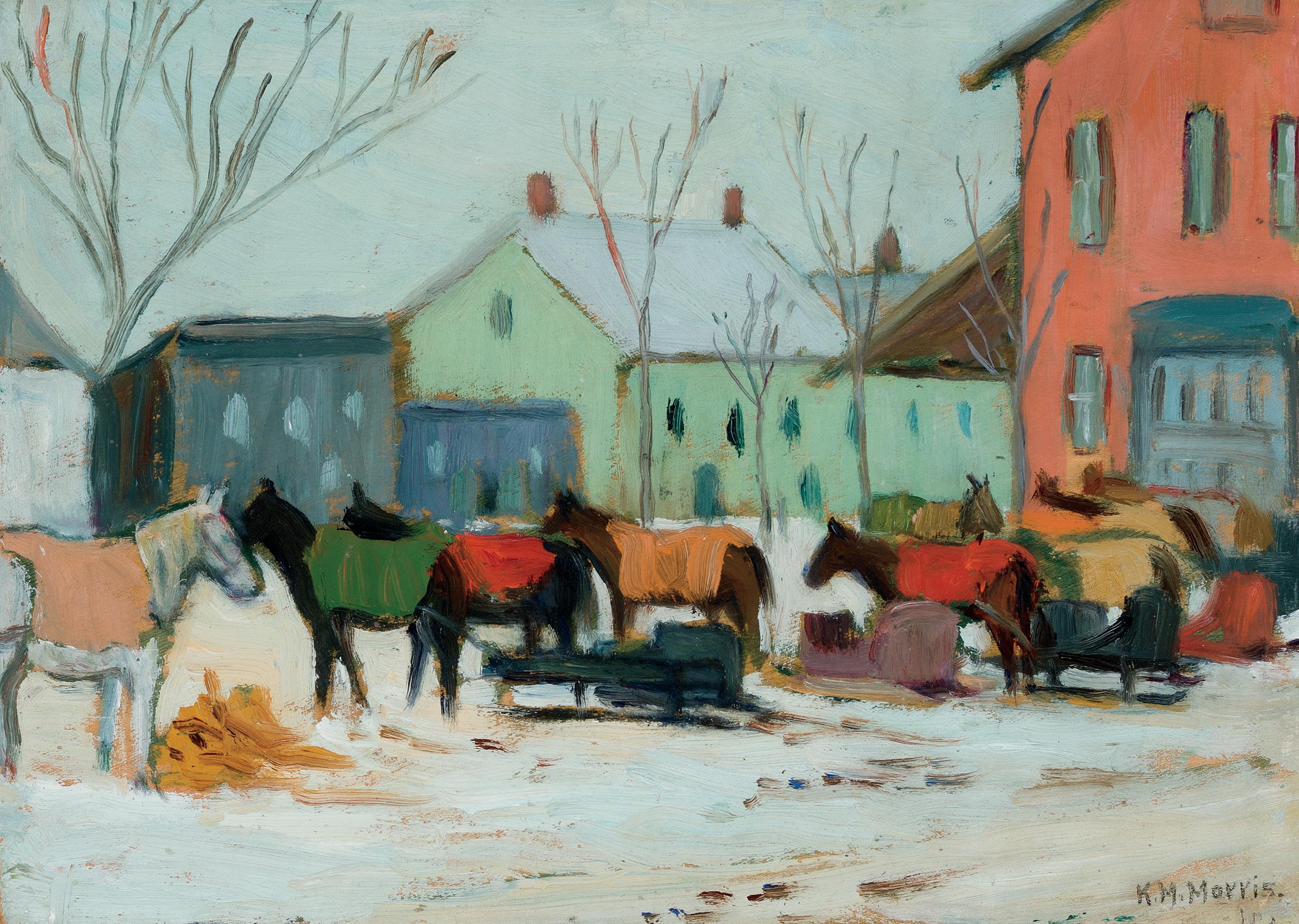
Mr. and Mrs. David Taylor, Montreal
By descent to a Private Estate, British Columbia Fine Canadian Art, Heffel Fine Art Auction House, November 26, 2009, lot 204
Private Collection, Toronto Canadian, Impressionist and Modern Art, Heffel Fine Art Auction House, November 20, 2019, lot 113
Private Collection, Montreal
Galerie Walter Klinkhoff Inc., Montreal, Kathleen Morris, Loan Exhibition, June 1976, catalogue #56
K ATH l EEN M ORRIS WAS a member of the Beaver Hall Group in Montreal, formally in existence from 1920 to 1922. The women
members of the group stayed in contact and continued to exhibit together after 1922. Morris’s streetscapes were painted directly from life in all seasons, in Montreal, Quebec City, Ottawa and outlying towns such as picturesque Berthierville, where she and her mother usually spent six weeks each year. Morris was particularly known for her depiction of colourful market scenes and horse-drawn taxi stands, and this is a fine example of this sought-after subject matter. In winter, Morris would be trans ported by sleigh to her chosen destination, where she painted bundled in furs. Her brushwork here is bold and assured, and her colour palette strong, contrasting the bright colours of the horses’ blankets and pastel house facades with the cool, even light of an overcast winter day. Examples of this subject are in the collections of the National Gallery of Canada and the Montreal Museum of Fine Arts.
This oil sketch was later used by Morris to produce the important large-format canvas of this scene, formerly in the private collection of Kenneth G. Heffel.
$ 30,000 – 50,000
109 Clarence Alphonse Gagnon
RCA 1881 –
Evening Glow, Laurentians (Dernières lueurs) oil on canvas, signed and titled Evening Glow, Laurentians on a plaque and on verso inscribed indistinctly, circa 1908 – 1913 19 3/4 × 25 1/2 in, 50.2 × 64.8 cm
Messrs. P. & D. Colnaghi and Obach, London, 1914
Watson Art Galleries, Montreal, 1926 Harold Braff
Private Collection, Ontario
By descent to the present Private Collection, Ontario
l iterature
A.K. Prakash, Impressionism in Canada: A Journey of Rediscovery, 2015, page 576, Evening Glow, Laurentians reproduced in a photograph of the 1913 Galerie A.M. Reitlinger exhibition (Musée des beaux-art de Montréal archives, Montreal) and page 577, the verso of this photograph, showing a diagram of
the layout of the exhibition, sketched in ink by the artist, this work is titled as Dernières lueurs and indicated as catalogue #84
Galerie A.M. Reitlinger, Paris, Exposition Clarence A. Gagnon. Paysage d’hiver dans les montagnes des Laurentides au Canada, November 27 – December 16, 1913, catalogue #84
fROM THE TIME he moved to Paris in 1904, Clarence Gagnon dreamed of having his own solo exhibition in the “City of Light.” The 23-year-old painter believed this was the only way for an artist to truly connect with the public. It would take less than a decade for that dream to come true. After regular showings at Paris’s annual art fairs, where his prints and paintings attracted the attention of critics and collectors, the Canadian artist was invited to display his work at art dealer Adrien M. Reitlinger’s Montparnasse gallery.
An invitation of this kind from someone so well connected in the Paris art world was an incredible opportunity. Moreover, the exhibition, Clarence A. Gagnon. Paysage d’hiver dans les montagnes

des Laurentides au Canada (1913), was a first in the history of Canadian art in Paris.1 The “Reitlinger event” would also prove to be the painter’s first and only major solo exhibition—one in which he was, as per his wishes, recognized as a painter rather than an engraver.
Evening Glow, Laurentians (Dernières lueurs) is one of 75 paint ings and pochades shown at Reitlinger’s famous exhibition, and is one of the great winter scenes that earned Gagnon enthusi astic reviews in Parisian newspapers. Critics found him to be a sensitive observer and skilled draftsman, noting the harmony of his compositions and colours and the invigorating effect of his works. “A breath of fresh air that clears the mind, fills the lungs, and inspires strength and courage,” wrote one.2 More than a cen tury later, the effect that charmed Parisian critics is still palpable in Evening Glow, Laurentians. Indeed, the intensity of the glow in this magnificent composition has not faded. Blues, pinks and purples marble the dazzling white snow at the end of a winter’s day in Charlevoix. The bright light of day still clings to a few snow-covered shapes, such as the barn roof and gently sloping hills, but the approaching dusk has already cast blue shadows over the land and will soon turn to evening twilight. For all these reasons, Evening Glow, Laurentians stands as a magnificent work of Canadian Impressionism.
It is known that Gagnon did not paint his winter scenes in situ. During his two stays in Baie-Saint-Paul, Quebec, between 1908 and 1913, he made numerous pochades and sketches and took photographs that served as the models for medium- and largescale works completed in his Paris studio. How fascinating that, sitting in the middle of Paris, Gagnon so successfully conveyed the feeling of winter in his distant homeland, right down to the fresh air. A spontaneity in the application of colour is evident in his quick, sharp brush-strokes. He also leaves part of the ground layer visible, revealing its whiteness and texture in the foreground of the composition on the right.
To our knowledge, the exhibition history of Evening Glow, Laurentians starts and ends with this single showing at A.M. Reitlinger’s gallery. Its resurgence on the art market, a century after its first and only public appearance, is an event in itself. The absence of a date or any indications on the back of the painting added some mystery to the provenance before it was identified in a photograph from the period (figures 1 and 2). Following the exhibition, the work went to London dealers Colnaghi and Obach in 1914, before being sent to Watson Art Galleries in Montreal, where it was sold to a certain Harold Braff sometime after 1926. The pochade believed to have served as a model for this composi tion has yet to be found.
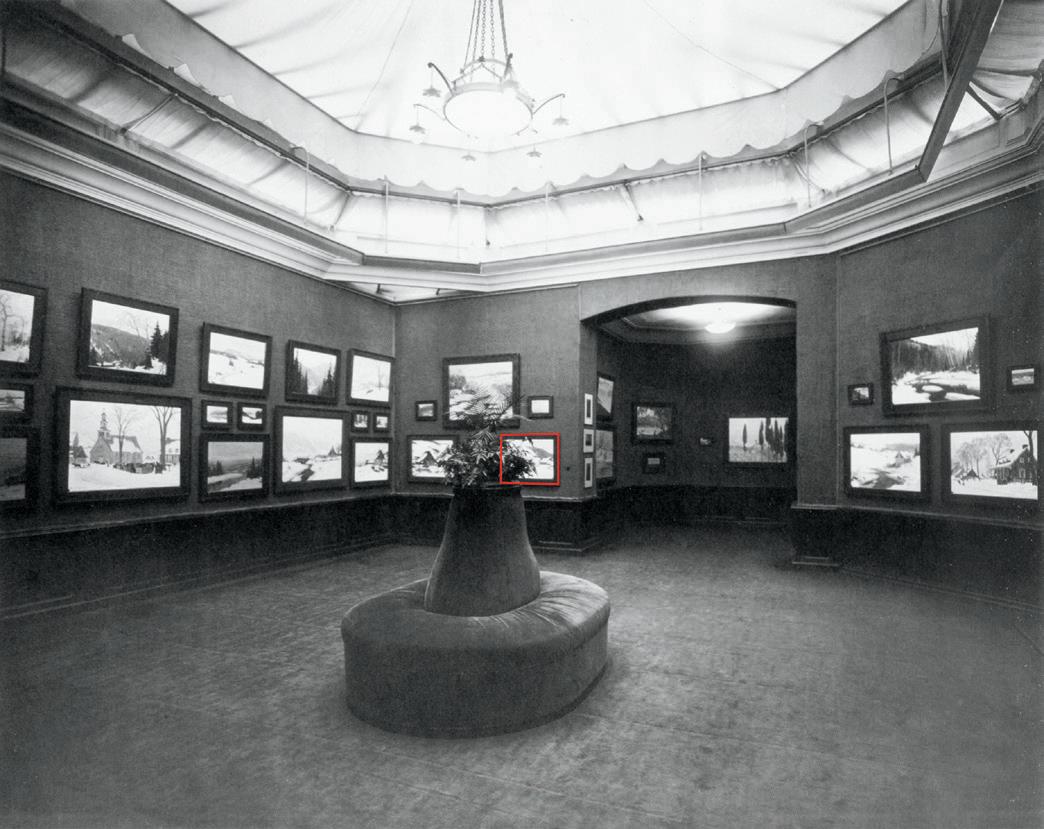
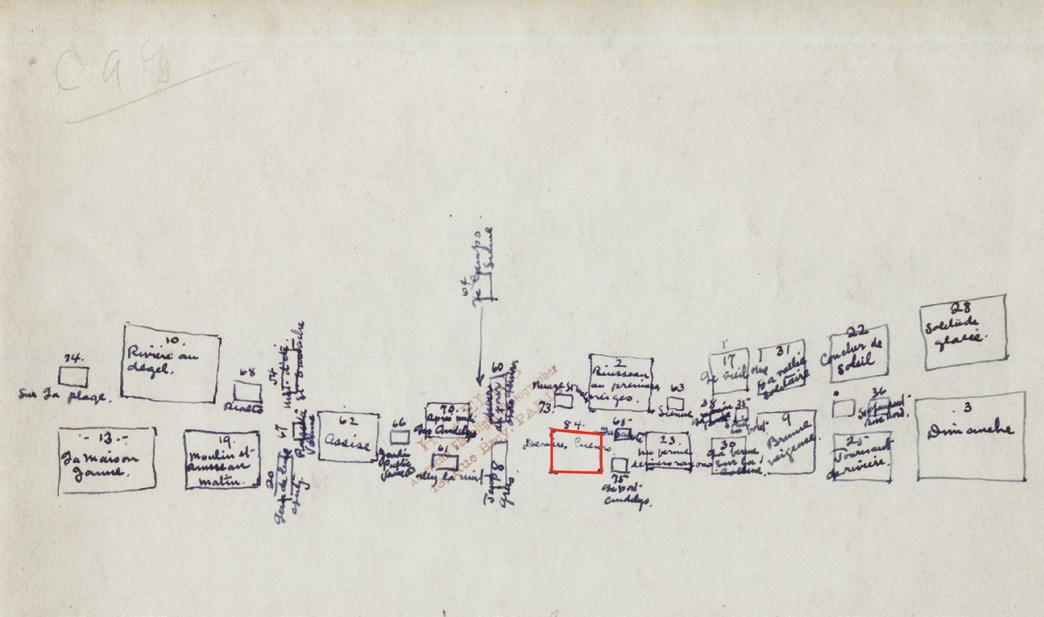
We thank Michèle Grandbois, co-author of Clarence Gagnon, 1881 – 1942: Dreaming the Landscape, for contributing the above essay (translated from the French).
1. At the time, only one other Canadian had been honoured with a solo show in Paris: Blair Bruce, a native of Hamilton, Ontario. But the 1907 exhibition at the Georges Petit gallery was a posthumous affair.
2. François Thiébault-Sisson, “Neiges et forêts du Canada. L’ex position Clarence Gagnon,” Le Temps (Paris), December 10, 1913.
Quoted by Hélène Sicotte in Clarence Gagnon, 1881 – 1942: Dreaming the Landscape (Quebec City: Musée national des beaux-arts du Qué bec, 2006), 115.
e stimate: $ 300,000 – 500,000
Marc Aurèle Fortin
ARCA 1888 – 1970
Paysage d’hiver oil on board, signed and on verso signed, titled and inscribed variously, circa 1938 17 3/4 × 19 3/4 in, 45.1 × 50.2 cm
p rovenan C e
Private Collection, Ontario Important Canadian Art, Sotheby’s Canada, November 6, 1991, lot 55 A Private Collection, Toronto l iterature
Fondation Marc-Aurèle Fortin, “Chronological Details of the Work of Marc-Aurèle Fortin, 1888 – 1970,” undated, https://www.fondationmafortin.org/en/maf_e.html
Michèle Grandbois, editor, Marc-Aurèle Fortin: The Experience of Colour, Musée national des beaux-arts du Québec, 2011, page 132
Paysage d’hiver IS a fine example of Marc-Aurèle Fortin’s unique black manner style, which he developed in 1936. The style
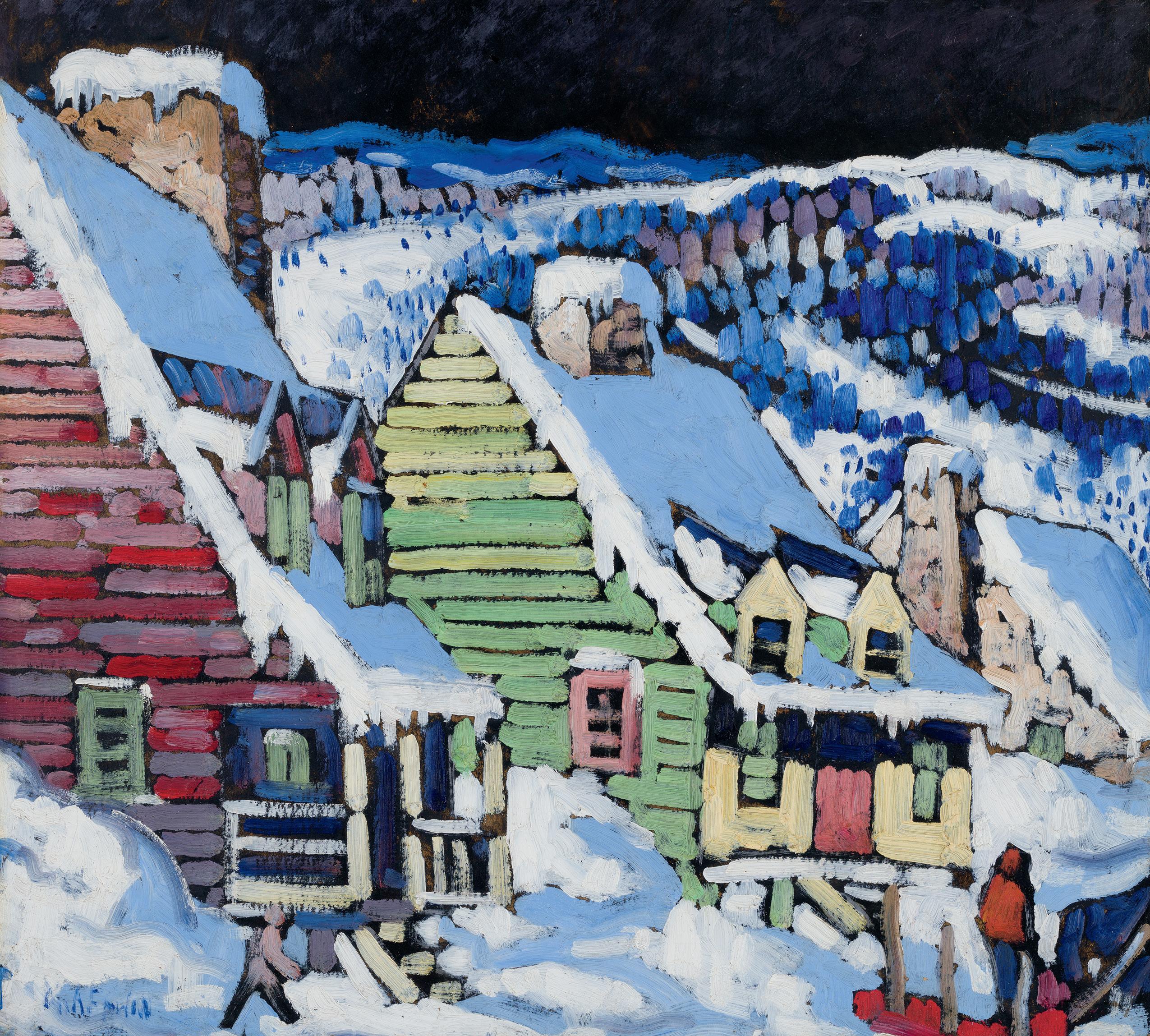
was based on an Oriental carpet he saw in Europe with a black background, “on which the traditional motifs hummed,” as he stated. Michèle Grandbois felt that this approach “was the cul mination of a long process that involved the influence of English painter Alfred East and Fortin’s admiration for the craftsmanship of non-modernist artists.”
A recurring subject in Fortin’s oeuvre was the small villages of Quebec, especially his birthplace of Sainte-Rose and the country side of the Gaspé and Saguenay regions. His paintings reflect his intimate knowledge of the peaceful life of rural Quebec. By paint ing on a black base, Fortin intensified the relationship between light and shade, and in Paysage d’hiver, the black sky makes a strong contrast with the snow and the colourful houses. The pig ment itself becomes the light source, especially the snow, which festoons the houses, piling in drifts around them and on the hill behind the village, and the horizontal slabs of bright colour for the houses, vigorously brushed on, appear to glow. The inclusion of details such as the horse and sledge and the figure striding through the snow add great charm to the scene.
stimate: $ 30,000 – 50,000
Ste. Rose, Winter, Quebec oil on board, signed and on verso signed, dated 1936 and inscribed Acheté à Ottawa 1938 / Antoine Monette / Peint en 1936, Ste Rose 18 × 23 7/8 in, 45.7 × 60.6 cm
Private Collection, Montreal Important Canadian Art, Sotheby’s Canada, October 30, 1990, lot 69
Private Collection, Toronto
Michèle Grandbois, editor, Marc-Aurèle Fortin: The Experience of Colour, Musée national des beaux-arts du Québec, 2011,
M ARC -A UR èl E fORTIN WAS born in Sainte-Rose, and his birth place would remain tremendously meaningful to him throughout his life. Fortin established himself in Montreal in 1910, exhib iting with the Art Association of Montreal, the Royal Canadian
Academy of Arts and many other venues. But although he painted Montreal’s urban neighbourhoods, he also painted the Quebec countryside, rambling by bicycle with his paint materials. Fortin’s magnificent paintings of towering elms backed by cumulus clouds in towns such as Sainte-Rose launched his career in the mid-1920s.
In this exuberant winter scene, the land rises in snow-covered layers behind the town, sprinkled with conical evergreens. Build ing the hillside with masses of white to the top of the picture plane, Fortin created a strong, indirect illumination. He depicted the unique architecture of the houses, with their dormer win dows, chimneys and bright colours, presided over by one of Sainte-Rose’s lofty elms. The man chopping wood and the horse and sleigh traveling down the road bring life to the scene. Fortin believed in the love of terroir—the land—stating that Quebecers should draw “inspiration from the rustic scenes of [our] country and [evolve] toward a deeply national art.” In this painting, we can feel the strength of Fortin’s communion with his beloved Sainte-Rose.
e stimate: $ 30,000 – 50,000

1871
Brittany House oil on board, signed with the estate stamp and on verso titled on the gallery label and inscribed with the Dominion Gallery Inventory #A 152, circa 1911 13 1/2 × 16 3/4 in, 34.3 × 42.5 cm

Dominion Gallery, Montreal
Private Collection, Victoria Fine Canadian Art, Heffel Fine Art Auction House, May 25, 2006, lot 5
Private Collection, Vancouver
Emily Carr, Growing Pains, 1946, pages 293 and 306
I N 1911 , E MI ly Carr left Paris and traveled to Crécy-en-Brie to study with the artist Harry Phelan Gibb. She explored the sur rounding area, writing in her journal: “Distant from Cressy by a mile or by a half-mile, were tiny villages in all directions. Each
village consisted of one street of stone cottages, whitewashed. A delicate trail of grape-vine was trained above every cottage door . its greenery well tended and delicately lovely.” Away from the big cities that oppressed her, Carr enjoyed the simplicity and pleasure of life painting outdoors and tramping the countryside and towns amongst the earthy people of Brittany. That can clearly be felt in this colourful scene, quietly suspended in the stillness of the warm sunlit day. In the fall of 1911, she went on to study with New Zealand artist Frances Hodgkins at Concarneau, a coastal fishing town in Brittany.
Carr’s time in France and her exposure to the art of the Post-Impressionists rejuvenated her approach to her work, which she wrote consequently had “brighter, cleaner colour, simpler form, more intensity.” Freed from her previous naturalistic style, Carr began to use contrasts in hue rather than tone and wielded a more vigorous brush-stroke that showed a greater awareness of texture and rich pigment. Her new boldness is clear in the warm yellow hues of the stone walls, the vivid foliage and the rich pastel tones in the roof and sky. On her return to Canada, Carr had the artistic tools and assurance to embark on her brilliant 1912 canvases of First Nations subject matter.
e stimate: $ 125,000 – 175,000
oil on paper on board, signed with the estate stamp and on verso inscribed variously, circa 1933 24 × 28 3/4 in, 61 × 73 cm
A wedding gift to a Private Collection, Montreal, circa 1946
By descent to the present Private Estate, Montreal l iterature
Maria Tippett, Emily Carr: A Biography, 1979, page 223
John O’Brian and David Alexander, Gasoline, Oil, and Paper: The 1930s Oil-on-Paper Paintings of Emily Carr, Mendel Art Gallery, 1995, page 11
I N J UNE 1933 , Emily Carr visited her niece Lillian Rae in Brackendale, near Squamish, British Columbia. From there she traveled to Lillooet, followed by Seton and Anderson Lakes, then south back to Pemberton. It is likely this painting is from that trip.
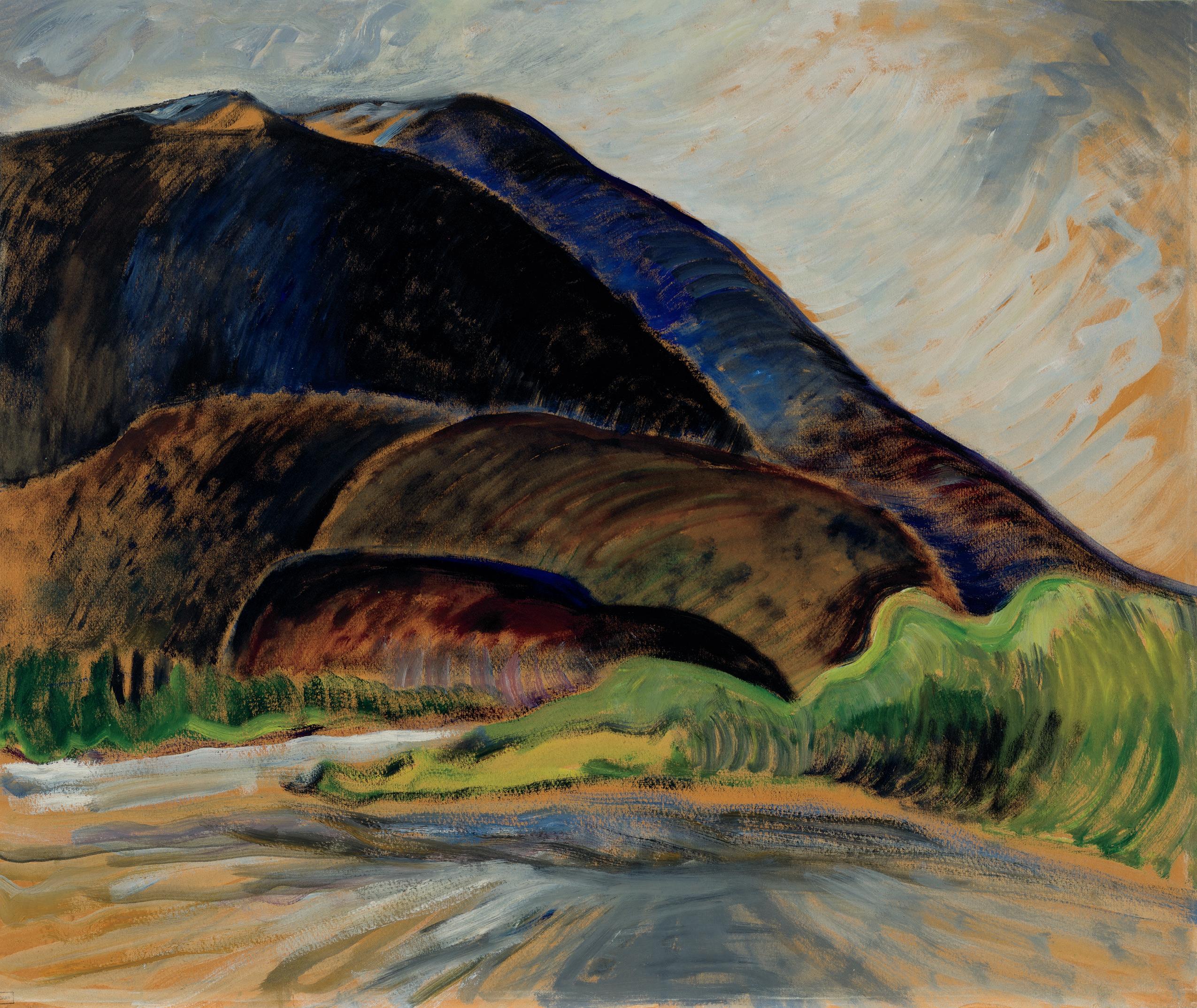
Carr was inspired by the ranges of the Coast Mountains she saw there and wrote in her journal, “Oh, you mountains, I am at your feet—humble, pleading! Speak to me in your wordless words! I claim my brotherhood to you. We are of the same substance for there is only one substance.”
Here we see the “one continuous movement,” as Carr described it, that she depicted in her inner forest paintings, as her brush-strokes emphasize the rhythm flowing through the landscape. This expression of energy was facilitated by her new medium of oil on paper. The addition of turpentine or gasoline to oil paint preserved a richness of pigment while making the paint fluid, like watercolour, and Carr could apply long strokes of paint using sweeping arm movements. Carr varies her paint application from light and transparent to thick and opaque, using various densities of cobalt, gold, green and chocolate brown. This sublime Carr landscape culminates in a radiant aura in the sky, transmitting her perception of the spiritual in nature.
e stimate: $ 125,000 – 175,000

Paris, View from Studio Window oil on canvas, signed and on verso titled and inscribed Estate J.W. Morrice / Return to W. Scott & Sons / #487 , circa 1916
18 1/4 × 21 3/4 in, 46.4 × 55.2 cm
By descent to the present Private Collection, Ontario
l iteratureJames Wilson Morrice Sketchbook #10 , 1914 and 1915, collection of Montreal Museum of Fine Arts, a similar pencil sketch reproduced page 12
Art Association of Montreal, Memorial Exhibition of Paintings by the Late James W. Morrice, r C a , January 16 – February 15, 1925, titled as Paris, View from the Studio Window, lent by the Estate of the Late J.W. Morrice, RCA , catalogue #28
I N THE l ATE nineteenth century, Paris was the capital of west ern art. Students from around the world, attracted by the prestige of the city’s teaching ateliers, its museums and buoyant art life, came to study, paint, travel and, on occasion, stay. Having ful filled his filial duties by passing his Bar exams in Toronto, the 24-year old Scottish-Montrealer James Wilson Morrice arrived in Paris to study briefly at the Académie Julian. He never looked back.

Morrice delighted in the visual displays that Paris offered: its streets and curbside cafés, the bridges across the Seine, the parks, gardens and theatres. In the 1890s, the city’s public spaces became one of his principal subjects and he repeatedly returned to the banks of the Seine, where he painted oil sketches and canvases of the river’s shores, barges, bridges and the stalls of the booksellers that lined the river’s banks. In October 1899, he moved into a studio at 45 Quai des Grands-Augustins, on the left bank of the Seine between the Pont Neuf and Pont Saint-Michel, with a view across to the Place Dauphine on the Île de la Cité.
In 1904, a winter view from Morrice’s studio, titled Quai des Grands-Augustins (figure 1), was purchased by the French government for the museum of contemporary art, the Musée du Luxembourg. Now in Paris’s Musée d’Orsay, the painting is arranged in parallel, horizontal planes. A woman carrying an umbrella walks her dog across the foreground sidewalk towards a bookseller and black-clad woman at the left. The figures are framed by the bookstalls, and beyond one glimpses ice in the river, and the ramp and embankments on the far shore crowned by apartment buildings on the Place Dauphine. The horizontals are united vertically across the canvas by a row of thin, almost leafless trees rising from behind the stalls. The misty, evening nocturne is painted in a delicate palette of beige, brown and pinks with highlights of green and golden yellow. A smaller version of the subject, painted in a palette of browns and greens, was acquired by the National Gallery of Canada in 1909.
FiGuRE
Quai des Grands-Augustins oil on canvas, 1904 25 1/3 × 31

in, 65
cm Collection of Musée d'Orsay, Paris, RF 1980-146 Photo: Hervé Lewandowski,
-Grand Palais / Art Resource, NY
Not for sale with this lot
Morrice painted a number of variant views of the quai in dif ferent seasons over the years, always interpreted in an evolving pictorial language. When traveling, the artist’s common practice was to paint small oil sketches or pochades to define a composi tion, with additional details drawn in his sketchbooks. Given the number of Quai des Grands-Augustins paintings, the paucity of drawn or painted studies for the canvases is somewhat surprising.
Perceived daily while in Paris, the fluctuations of light and colour must have haunted his imagination, allowing him to work directly on the canvas.
Paintings of the Paris quais were interrupted by Morrice’s trav els to North Africa and the West Indies from 1912 to 1915. When war broke out in August 1914, he briefly sought refuge in London. As Elizabeth Pennell wrote, “To be shut up in his studio alone after eight o’clock in the evening was too much for his nerves.” 1 With travel restricted by the war, Morrice returned to the nearby quais in three canvases: Spring, Quai des Grands-Augustins and Autumn, Quai des Grands-Augustins, both in the National Gallery of Canada (accession numbers 30481 and 46627), and Paris, View from Studio Window. The first two are painted thinly, the fig ures almost silhouettes. The compositions find their precedent in
the 1904 canvas, with the bookstalls, barges, river and apartment buildings on the far side of the Seine being the principal compo nents, with the vertical trees behind the bookstalls uniting the upper and lower parts of the composition. The foreground street runs at an angle from right to left, giving a greater dynamism to the composition, as does the freer brushwork. In Paris, View from Studio Window, the paint is less transparent, the trees and buildings more solid. The same silhouette defines the building on the Place Dauphine and the ramp from the river to the Quai des Orfèvres is clearly defined. In spite of the rain, the mood is joyful. A sole figure carrying an umbrella walks by on the wet city street. Most stunning is the rich blue sky, recalling the beautiful blue walls of his painting House in Santiago (Tate Gallery, London) of 1915.
But life was not static on the Quai des Grands-Augustins, as Morrice described in a letter to fellow artist Joseph Pennell.
When I arrived at my studio I found a most ghastly change— the shop next door is now an automobile shop—it is painted red—a beastly hot red—what one would naturally expect
At night there is a huge lantern with a large number & the
114 showing in its frame
word garage underneath giving it the appearance of a place of doubtful fame 2
For whatever reason, Morrice had moved east to 23 Quai de la Tournelle by the fall of 1917.3 The new studio still looked out over the Seine as seen in Quai de la Seine: effet d’automne 4 , correctly identified by Donald Buchanan as being a view from the Quai de la Tournelle.5 Similar elements form the composition; however, the vertical trees align the street in the foreground, partially con cealing the bookstalls, and the buildings on the Île Saint-Louis rise above the young trees.
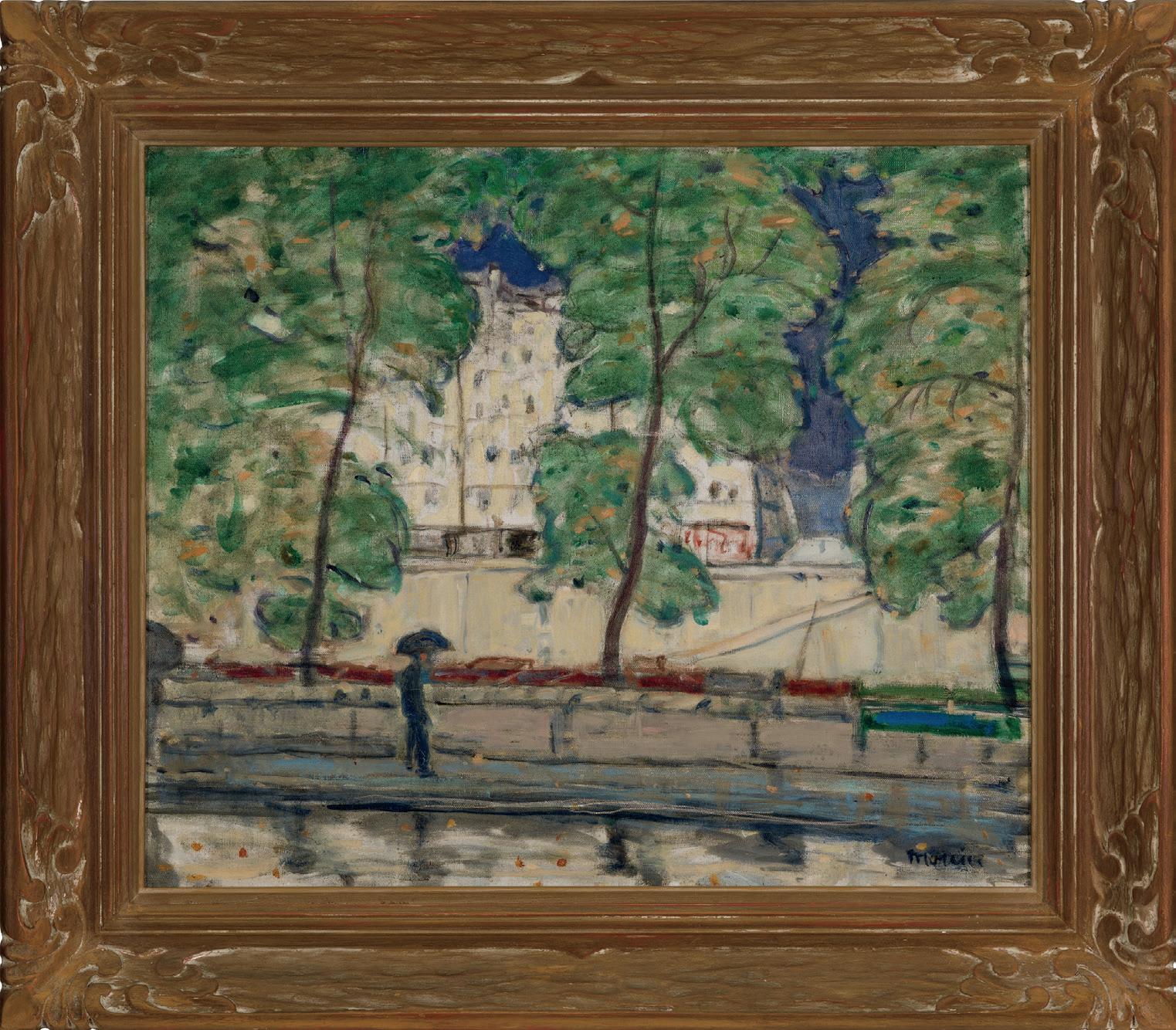
Previously unknown and unpublished, Paris, View from Studio Window is a superb complement and a major addition to the important body of Morrice’s paintings of the Quai des Grands-Augustins, possibly the final canvas of this cherished view.
We thank Charles C. Hill, former curator of Canadian art from 1980 to 2014 at the National Gallery of Canada, and author of Morrice, A Gift to the Nation: The G. Blair Laing Collection, for contributing the above essay.
Thanks to Lucie Dorais, art historian, author of J.W. Morrice (National Gallery of Canada, 1985) and compiler of the catalogue
raisonné of the work of James Wilson Morrice, for her assistance with the cataloguing of this painting. This work will be included in Dorais’s forthcoming catalogue raisonné of the artist’s work.
1. Elizabeth Robins Pennell, The Life and Letters of Joseph Pennell (Boston: Little, Brown, 1929), 2:145.
2. J.W. Morrice, Paris, to Joseph Pennell, London, 12 September [1914?], Pennell Papers (MS S-79-93857, container 248), Library of Congress, Washington, DC .
3. Edmond Dyonnet, Montreal, to Eric Brown, Ottawa, 16 Novem ber 1917 (file 7.1—Art & Artists), Library & Archives of the National Gallery of Canada, Ottawa.
4. Reproduced in colour in Sotheby’s, Toronto, sale catalogue, Important Canadian Art, 18 November 1992, lot 81
5. Donald W. Buchanan, James Wilson Morrice: A Biography (Toronto: Ryerson Press, 1936), 170.
Estimat E : $ 600,000 – 800,000

Girl with a Wash Bowl oil on board, on verso titled, inscribed 335 and variously and stamped with the AAM Helen G. McNicoll catalogue #118 12 5/8 × 9 in, 32.1 × 22.9 cm
Memorial Exhibition of Paintings by the Late Helen G. McNicoll, r B a , ar C a , Art Association of Montreal, 1925, listed page 9, titled as Sketch
National Gallery of Canada, “Helen McNicoll,” https://www.gallery.ca/collection/artist/helen-mcnicoll
e xhibited
Art Association of Montreal, Memorial Exhibition of Paintings by the Late Helen G. McNicoll, r B a , ar C a , November 7 –December 6, 1925, catalogue #118, titled as Sketch
Helson Gallery, Halton Hills, Ontario, Le petit salon: Canadian Artists and Impressionism, April 27 – July 23, 2022
H E l EN M C N ICO ll WAS an important Canadian Impressionist, known for her portraits of children and upper-class and working women, in both outdoor and indoor settings. After studying at the Art Association of Montreal, McNicoll enrolled in the Slade School of Fine Art in London, where she was exposed to both French and British Impressionists. Around 1905 she entered the School of Landscape and Sea Painting at St. Ives in Cornwall, where she was inspired by the teachings of Algernon Talmage and explored painting en plein air. Talmage was noted for stat ing, “Remember, there is sunshine in the shadows,” a tenet manifested in this extraordinary light-infused portrait of a young girl. McNicoll exhibits a gorgeous delicate pastel palette in the girl’s clothing—creamy strokes of white, ivory and pale lemon yellow are contrasted with small touches of pink and highlighted with blue and mauve shadows. The girl is sweetly contemplative, perhaps paused in a task to enjoy the warm sunshine. McNicoll’s brushwork is sensitive—the door and walls in the background and the stone steps are delineated by broad, assured brush-strokes that suggest rather than exactly define wood and masonry.
McNicoll achieved success in Montreal and England during a time of social, political and cultural transformation. Her remark able life was cut short—she died at the age of 35, making her extraordinary paintings rare and sought-after.
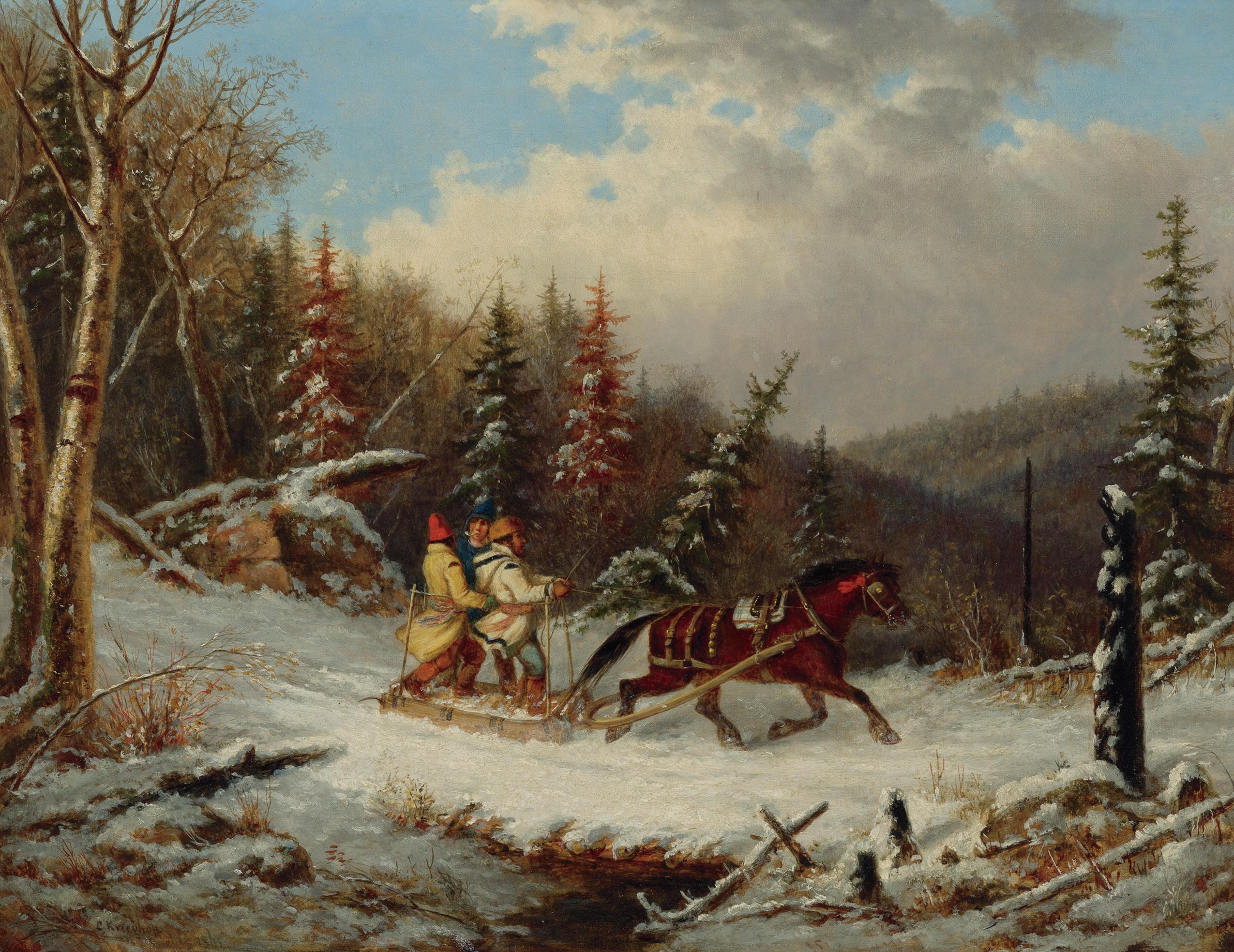
– 1872
The Bush Road, Winter oil on canvas on board, signed, titled Bush Road in Winter on a plaque and dated 1865 and on verso titled on the Laing Galleries label and inscribed 6033 and 918 13 1/2 × 17 1/4 in, 34.3 × 43.8 cm
p rovenan C e H.W. Mara, Toronto
Laing Galleries, Toronto
By descent to the present Private Collection, Vancouver l iterature
Marius Barbeau, Cornelius Krieghoff: Pioneer Painter of North America, 1934, listed page 82; listed and described page 112
e xhibited
Art Gallery of Toronto, 1934
fROM 1853 TO 1863, Cornelius Krieghoff lived in Quebec City, and he often depicted scenes of horses and sleighs traversing rural communities and winter landscapes. Krieghoff followed the seventeenth-century Dutch tradition of painting the daily life of all classes, with an emphasis on Quebec’s rural habitant population.
In this dynamic composition, three habitants are traveling in a traîneau à batons, or stick sled, pulled by a distinctive Quebec breed of horse called the canadien, small but powerful. The driver guides the trotting horse on the snowy path while his passengers casually converse, one man facing us with a pipe in his mouth, his face red from the cold. Kreighoff depicted the fine details of the men’s distinctive dress—their colourful sashes, the various hats and the Hudson’s Bay blanket coat of the driver. He also depicted the unique harness of the canadien, with a red ribbon jauntily attached to its bridle. The speed at which the sled is moving is emphasized by the forward-leaning tree above it and the move ment of the men’s coats. The landscape that surrounds them is dramatic, with cloud formations towering against a blue sky above the cleft in the forested hills. The Bush Road, Winter, both a striking landscape and a record of habitant life, is an inventive and vital early Canadian scene.
e stimate: $ 50,000 – 70,000

Quebec Village in Winter oil on canvas, initialed 17 1/2 × 21 1/4 in, 44.5 × 54 cm p rovenan C e
A.Y. Jackson, A Painter’s Country: The Autobiography of A.Y. Jackson, 1958, page 57 Peter Mellen, The Group of Seven, 1970, page 13 Rosemary Shipton, The McMichael Canadian Collection, McMichael Canadian Art Collection, 1983, page 136
I N 1903 , Al BERT ROBINSON traveled to Paris to study at the Académie Julian and the École des Beaux-Arts. Robinson expressed that he was influenced by the Impressionists, who were at the forefront of innovation in France with their unique approach to light and colour. After his return to his home in Ham ilton in 1906, Robinson was approached by Mr. and Mrs. William Davis to come to Montreal. They offered to support him by paying the rent on a studio and introduced him to well-known artists and collectors. Robinson was soon at the heart of artistic life in Montreal, meeting prominent artists such as Maurice Cullen and Marc-Aurèle Suzor-Coté, and forming lifelong friendships with A.Y. Jackson, Edwin Holgate, Randolph Hewton, Clarence Gagnon and Robert Pilot.
In 1911, Robinson traveled to Europe with Jackson, and on his return to Montreal in 1912, he became one of the first artists to paint the villages of Quebec. Throughout the 1920s, Robinson painted the small towns on the north and south shores of the St. Lawrence River. He was often accompanied by other art ists, such as Holgate, Hewton, Gagnon and particularly Jackson, who wrote about him in his autobiography, A Painter’s Country Jackson related that while in Cacouna in the winter of 1921, he wrote to Robinson, urging him to join him at his hotel, and “to my joy, he arrived one evening. There was something about Robinson that melted all reserve as the frost disappears when
the sun rises.” Jackson described how Robinson charmed the family who ran the hotel, and how the two artists sketched en plein air around the village, which he described as very pictur esque, and engaged with the local population, who were curious about their activities. Robinson also painted at Baie-Saint-Paul, Bienville, La Malbaie, Les Éboulements, Sainte-Fidèle and SaintTite-des-Caps, to name a few.
Along with the Group of Seven, Robinson was one of the pioneers of the modern movement, and the Group invited him to participate in their first exhibition, in 1920, as well as three subsequent shows. As Peter Mellen opined, “Considering how intimate he was with the Group, it is surprising he never became a member.” Robinson was known for his sensitive approach to colour and his use of pastel tones. Rosemary Shipton com mented, “It is as though his pink, grey and blue dipped brush removed the severity from the land and left behind only the silver sunlight and the sound of sleigh bells.” His compositions were lyrical and poetic, expressive of his subtle feeling for his Quebec village subjects. Group member Arthur Lismer wrote, “His art is the colourful expression of daily life, full of charm, devoid of sentimentality.”
In this superb canvas, a man with his walking stick trudges along a sinuous curve of the snowy path to the village. The motif of the telephone poles at the entrance to the village adds a strong vertical element, and, depicted with their wires omitted, they suggest the wayside crosses so often seen in the Quebec coun tryside, a reminder of the importance of religion in Quebec’s small towns. The cluster of houses brings the warmth of human presence, and their colouration is vivacious—pink, red, mauve and blue, reflecting the individuality of their residents. Patches of snow on the roofs break up their dark colouration and echo the rocks showing through the snow on the hill and in the lower right. The snow, which lights up this canvas, is accented with exquisite pastels and counterbalances the rich blue of the sky. Robinson’s enchanting winter scene radiates peace and contentment.
Robinson suffered from heart problems and arthritis later in his life, and by 1936 he had ceased to paint. His shortened career of only about 20 years makes his works, particularly canvases such as this, rare.
e stimate: $ 90,000 – 120,000

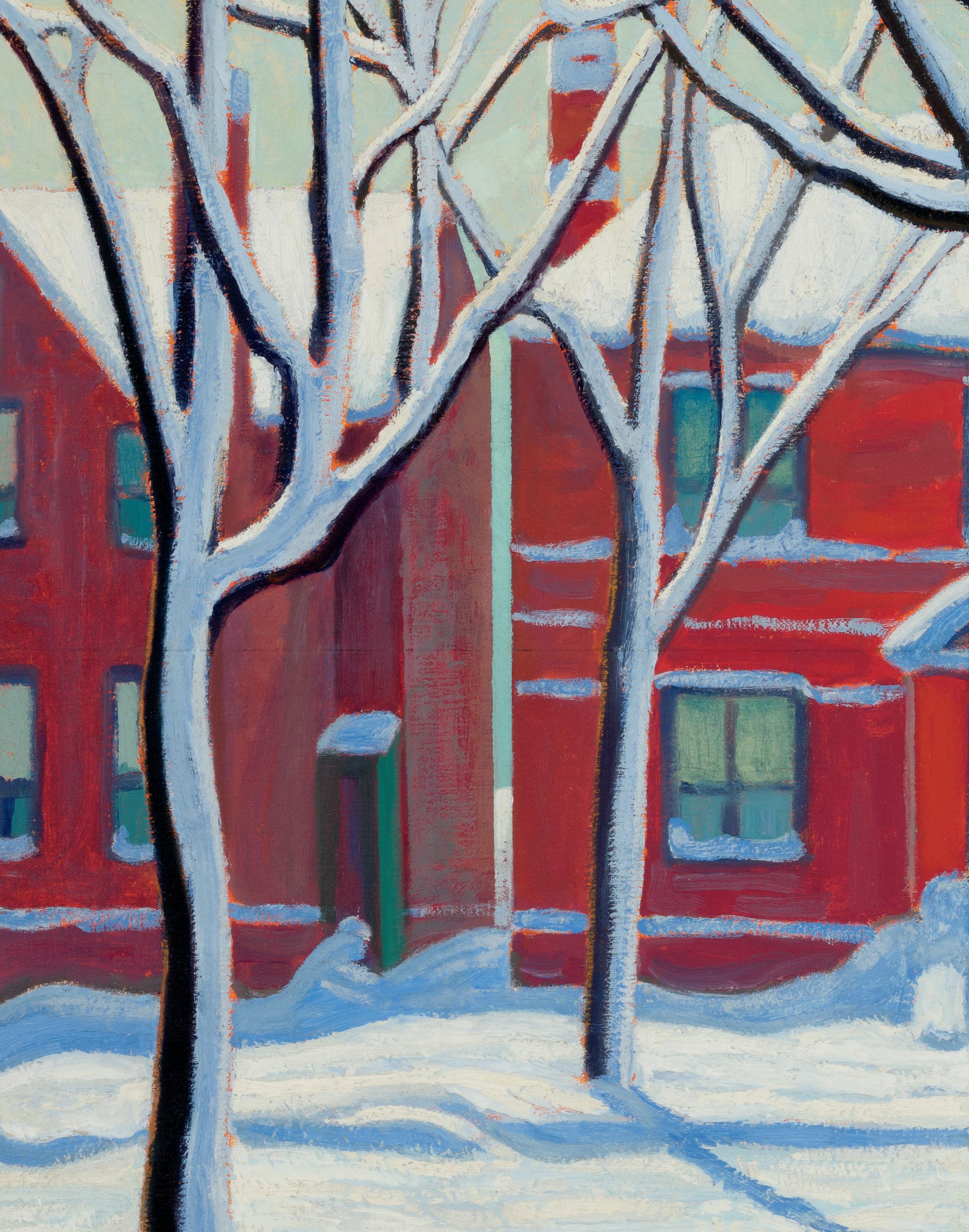

House in the Ward, Winter, City Painting No. 1 oil on canvas, signed and on verso titled as Street Scene, Winter on the Laing Galleries label, circa 1924 32 × 38 3/8 in, 81.3 × 97.5 cm
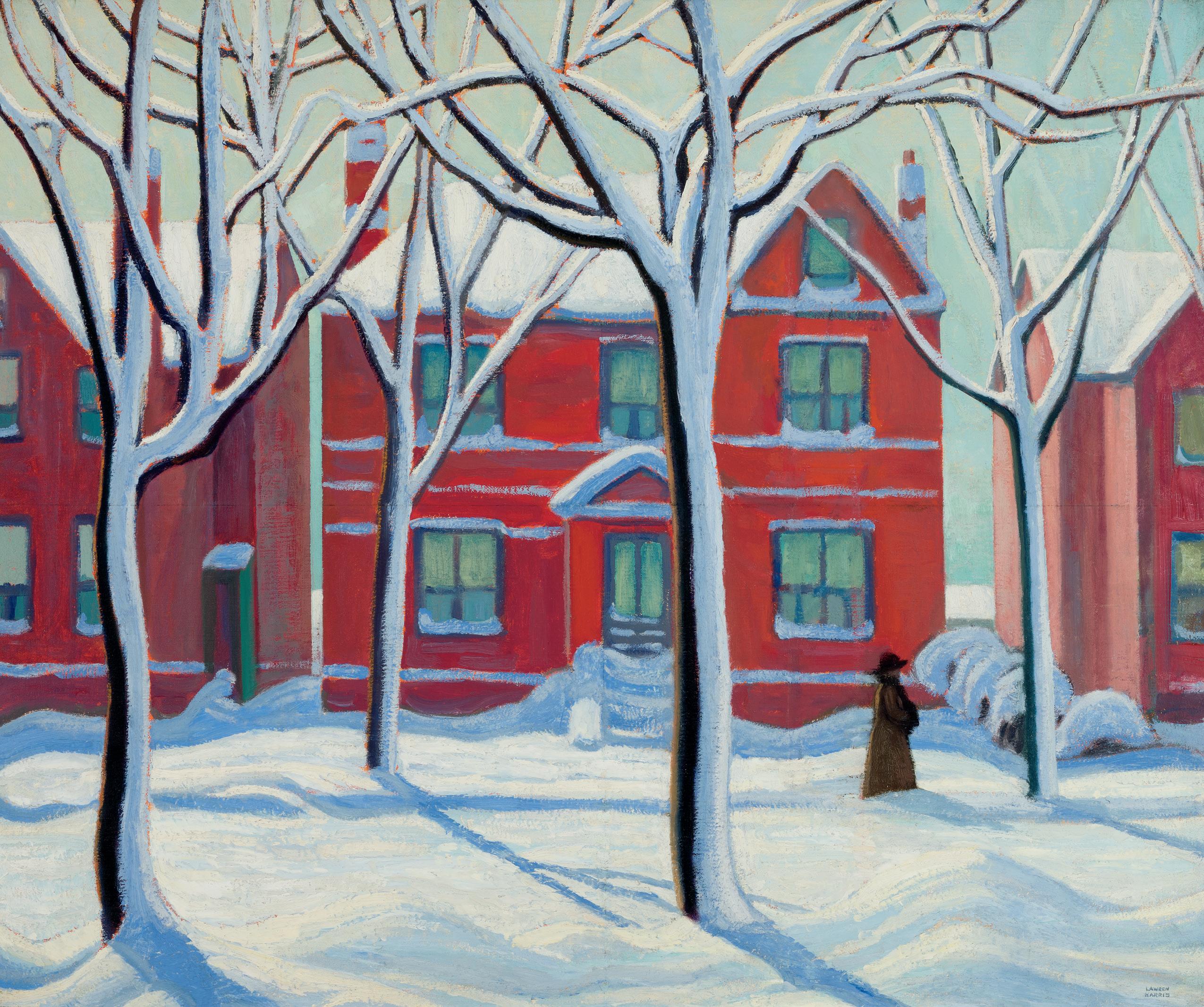
p rovenan C e
Laing Galleries, Toronto
Volkswagen Canada, acquired from the above in 1957
Private Collection, Switzerland
Important Canadian Art, Sotheby’s Canada, May 11, 1994, lot 102
A Prestigious Corporate Collection
l iterature
Doris Mills, L.S. Harris Inventory, 1936, City Paintings, catalogue #1, location noted as the Art Gallery of Toronto,
and a drawing of the painting illustrated by Hans Jensen in the section titled Large Pictures
Jeremy Adamson, Lawren S. Harris: Urban Scenes and Wilderness Landscapes, 1906 – 1930 , Art Gallery of Ontario, 1978, page 25 Paul Duval, Lawren Harris: Where the Universe Sings, 2011, reproduced page 105, titled as House in the Ward, City Painting No. 1 , dated as circa 1918, listed page 401, and the sketch for this work entitled “Houses” Group XXX iii dated as circa 1918 (sold by Heffel November 24, 2005, lot 78), reproduced page 104, listed page 401
lAWREN H ARRIS WAS one of the founding members of the Group of Seven in 1920 and is renowned in the history of abstrac tion in this country, but there is a third important aspect of his artistic practice that is slightly less well known. Beginning with his training in Germany in the early years of the twentieth cen tury, Harris also painted the urban scene. Upon his return to
Canada and his home in Toronto, he continued that interest through his depiction of the environs of Toronto, specifically the area of largely immigrant housing in the area of the Ward. As Jeremy Adamson observed in his landmark 1978 exhibition catalogue, Lawren S. Harris: Urban Scenes and Wilderness Landscapes, 1906 – 1930 , “no other member of the Group of Seven painted Toronto subjects as consistently as Harris.” Indeed, in the 1925 Rous & Mann portfolio, Canadian Drawings by Members of the Group of Seven, two of the four images Harris contributed were of Toronto street scenes, suggesting the importance of this imagery to him. Harris went on to paint urban scenes in Barrie, Hamilton, Grimsby Park, Glace Bay and Halifax, among other towns and cities, but the most important body of urban subject matter is the work done in Toronto.
The earliest Toronto images date from 1909 to 1910, and they continue alongside his developing work as a landscape painter, through most of the next two decades. As Adamson has also pointed out, in the period from 1919 to 1921, Harris exhibited more house paintings than any other theme, and most of these were Toronto subjects. These Ward paintings were of buildings and streetscapes in St. John’s Ward, the area of Toronto bounded by Yonge Street on the east, University Avenue on the west and Bloor on the north. The poorest section of the Ward was the area south of College Street.
Group of Seven members were sometimes criticized by their contemporaries for their depiction of the wilderness of Canada rather than the more picturesque aspects of the country. Harris faced similar criticism about his depictions of Toronto—because he chose to paint slightly decrepit, decaying housing rather than the bright, new commercial buildings or the homes of the wealthy. What the urban and landscape works of the period shared was an intensity of looking which has seldom been rivaled in Canadian painting.
The process that Harris (and his colleagues that formed the Group) developed was to paint or draw in the field and later develop this preliminary work into a canvas. There are, therefore, far more Harris drawings and oil sketches than there are canvases, because many field studies were not developed into larger com positions. This process allowed Harris to refine his compositional ideas, and we can see this clearly when we compare House in the Ward, Winter, City Painting No. 1 with the sketch “Houses” Group XXX iii (figure 1, sold by Heffel November 24, 2005, lot 78). The sketch, done outdoors, depicts a snowy landscape with two red-brick houses and a group of snow-shrouded trees in the fore ground. Strikingly, the sky is a pale yellow. Harris used this sketch as the basis for his larger canvas, but he made important changes to the composition which, in turn, change our reading of the image.
The relatively brisk brushwork of the sketch has been replaced in the canvas by a more considered application of paint. The on-the-spot sketch shows a complex tangle of tree branches at the top of the composition, whereas in House in the Ward, Winter, City Painting No. 1 , this web has been simplified. One of the trees on the right has been enlarged and moved, and the tree on the left has been straightened. These changes allow us to see the central house more clearly and permit Harris the opportunity to introduce the figure walking along the sidewalk. The canvas also broadens the view, showing more of the house on the right side. This allows the house to be the greater focus and gives the
composition a quiet, but insistent, left to right rhythm, subtly echoing the journey of the figure.
Harris has also dramatically changed the light within the painting. In the sketch there is little indication of shadow and no indication of the time of day—it might be dawn or dusk. In House in the Ward, Winter, City Painting No. 1 , dramatic shadows are cast by the trees across the snow by the intense sunlight, suggesting midday. This bright light gives the image a remarkable clarity, and allows us to feel the icy chill of the winter day. Other changes are equally subtle—a slight increase in the verticality of the houses, and the shadows that reach the edge of the pictorial space give the image both a greater distance and gravity. Harris has lightened the red-orange colour of the brickwork on the central house, bringing it more into focus. This shift in colour has been matched by a slight deepening of the tone of the blinds in the house windows. Harris has strengthened the snow-covered hori zontals on the house facade to provide a balance to the verticality of the trees. There are many other small but significant changes between the sketch and the completed canvas, but all contribute to making House in the Ward, Winter, City Painting No. 1 more visu ally compelling and a fuller expression of Harris’s unique vision of the Ward and winter in the city, one that continues to resonate with Canadians.
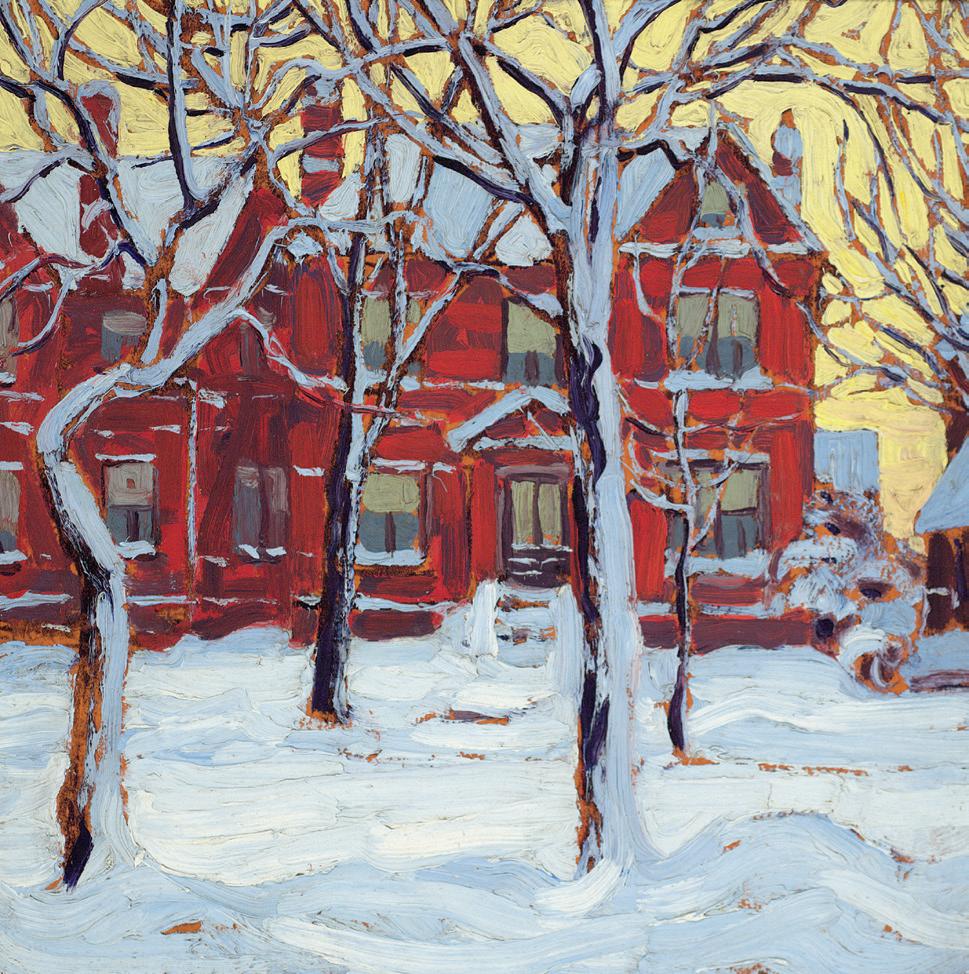
We thank Ian M. Thom, senior curator at the Vancouver Art Gallery from 1988 to 2018 and author of Lawren Stewart Harris: A Painter’s Progress, the catalogue for the Americas Society exhibition in 2000.
e stimate: $ 2,000,000 – 3,000,000

watercolour on paper on board, titled in Carr’s handwriting and inscribed 8/16, circa 1928 30 × 22 1/4 in, 76.2 × 56.5 cm
Barbara E. Spencer, British Columbia
Galerie Claude Lafitte, Montreal Private Collection, Toronto
Ira Dilworth and Lawren Harris, Emily Carr: Her Paintings and Sketches, National Gallery of Canada, 1945, a watercolour of the same title and size listed page 58
Gerta Moray, Unsettling Encounters: First Nations Imagery in the Art of Emily Carr, 2006, pages 133, 134 and 296
E MI ly C ARR’ S INTEREST in First Nations imagery began as early as 1899, when she visited Ucluelet on Vancouver Island, which was then part of a Nootka reserve. From her youth she had felt an affinity with First Nations people, whom she saw as living simple, unpretentious lives. In Ucluelet, the Indigenous people she met had accepted her without concern for Victorian social mores, which annoyed Carr, and which she felt hindered her ambition as a female artist. Carr’s first encounter with carved poles took place in 1907 in Skagway, Alaska, where she saw the Kaigani Haida poles that had been moved there.
In 1912, Carr visited the central and northern coastal com munities of Alert Bay, the Skeena River valley and the Queen Charlotte Islands on an ambitious six-week sketching trip. It was her first experience of the Skeena village of Gitwangak (once known as Kitwangak). Gerta Moray wrote that here, “Carr began to apply the experience she had gained in rendering carved forms at Hlragilda ’ Ilnagaay / Skidegate to impart mass and volume to the Gitxsan poles.” Carr noted that the poles “up the Skeena River [were] warm brown in colour and almost appear like new wood, though on close observation you can see they are of great age and much worn.” It was her opinion that the people of that area (in contrast to the Haida, she pointed out) regarded life with a more light-hearted outlook, and consequently “there were many more cheerful countenances depicted.”
Carr’s optimistic plans to bring attention to the Indigenous people and their plight by documenting their houses and carved poles (which she felt would soon be completely gone) did not fully come to fruition until 1927, when she was visited by anthropolo gist Marius Barbeau and National Gallery of Canada director Eric Brown. They subsequently included her work in the now famous exhibition West Coast Art, Native and Modern, held at the gallery that December, and they invited Carr to attend. This watershed exhibition threw Carr into the Canadian spotlight, and it was during this trip that she would meet Lawren Harris and other members of the Group of Seven. Their support for her work and respect for her as an artist renewed Carr’s enthusiasm to pursue her art, which had suffered numerous financial and critical blows during the previous decade.
With this, her desire to sketch remote First Nations villages was also renewed. Immediately upon return from her trip east, Carr made ambitious plans to travel north. She set out in June of 1928 and revisited a number of villages on the Skeena River that she had seen on her 1912 trip. She returned to Gitwangak to discover that, because it was on the railway line, it had been the subject of a Department of Mines– CNR totem pole restoration project. The poles had been stabilized with reinforcement posts, covered with thick paint that was not traditional, and re-installed in a straight line in the village. Although these procedures were intended to preserve them, Carr was offended by the restoration. She set out to document the poles, as Moray notes, “In pencil and watercolour on eight drawing-book pages, supplemented with five oil sketches, she noted all twelve of the poles then standing in the row along the river, thus renewing her acquaintance with them.” In these works, she was primarily concerned with the pro portions and masses of the poles, often in close-up, as we see here in this superb watercolour from this trip. The carved motifs are animated, as if barely contained on the pole, and the viewer feels the intensity of their gaze, even seen from the side. The backdrop of the mountains, described with transparent washes, is majestic and their insubstantiality makes the solidity and definition of the poles stand out.
This pivotal 1928 trip would be Carr’s last extended visit to First Nations villages. Although she did make shorter visits the following year, by 1930 the forest had become the focus of Carr’s attention.
e stimate: $ 175,000 – 225,000
Cabin in Winter oil on canvas board, signed 13 7/8 × 16 3/4 in, 35.2 × 42.5
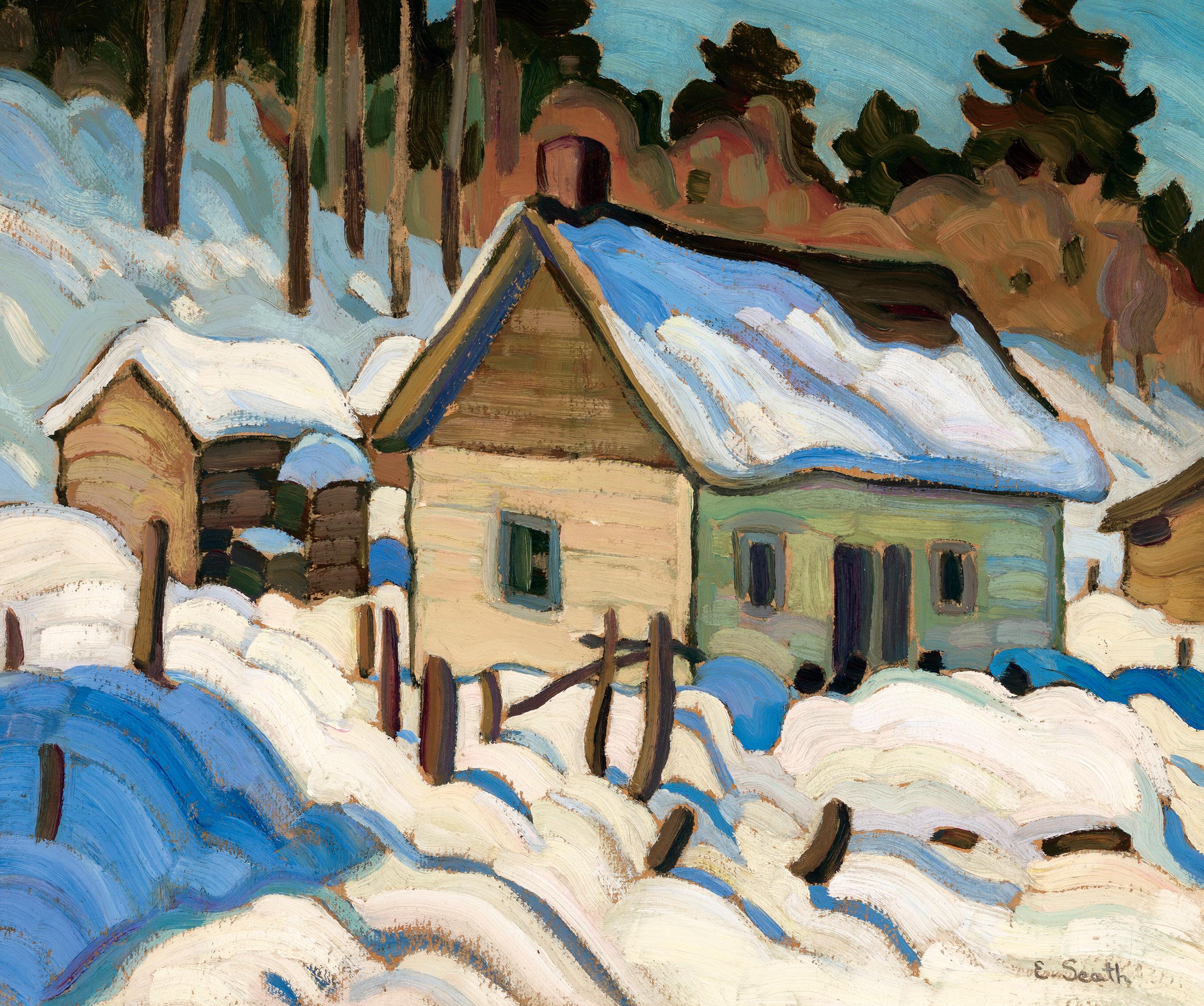
rovenan C
Private Collection, Ontario By descent to the present Private Collection, Ontario
Galerie Walter Klinkhoff Inc., Montreal, Ethel Seath Retrospective Exhibition, September 14 – 26, 1987, catalogue #35
E THE l S EATH STU d IE d under Edmond Dyonnet at the Conseil des arts et manufactures, and under William Brymner and the Impressionist Maurice Cullen at the Art Association of Montreal. Seath was a member of Montreal’s Beaver Hall Group and was
also involved in arts groups such the Contemporary Arts Society and the Canadian Group of Painters. She worked as an illustrator in the newspaper business in Montreal and then as an art teacher at The Study, where she taught for 45 years, while continuing to paint and show her work, notably with her fellow women artists from the Beaver Hall studio.
Cabin in Winter is a strong painting, its vivacious colour and robust sense of volume typical of Seath’s work. The rounded masses of snow tumble down the hill; sunlight raking through the trees casting blue shadows emphasizes this downward move ment. Pale pastel tints of mauve and yellow also work to define volume on the drifts lit by sunshine, and exemplify her absorption of Impressionism. Seath captured the light and atmosphere of a sunny winter’s day—the viewer feels the fresh, crisp air as if they are there. In her simplification of form and use of bold brushwork, Seath shows her qualities as an early female modernist.
$ 30,000 – 50,000
Loading at Water’s Edge oil on canvas, signed and dated indistinctly and on verso signed and dated 1930 28 1/4 × 23 3/4 in, 71.8 × 60.3 cm
p rovenan C e
Private Collection, Vancouver Fine Canadian Art, Heffel Fine Art Auction House, November 7, 1996, lot 89
An Important Private Collection, Vancouver
P E l EG fRANK l IN B ROWNE ll was born in Massachusetts and trained at the School of the Museum of Fine Arts, Boston, followed by the Académie Julian and the atelier of Léon-Joseph-Florentin Bon nat in Paris. Brownell emigrated from the US to Canada in 1886, first residing in Montreal and then in Ottawa, where he took a teaching position at the Ottawa School of Art as headmaster. He also taught at
the Women’s Art Association of Ottawa. Brownell was a founding member of the Canadian Art Club and a regular exhibitor at the Royal Canadian Academy of Arts and the Art Association of Mon treal. He painted landscapes in Gatineau and other areas around Ottawa as well as still lifes, portraits, and marine and genre scenes.
Brownell’s work was known for its radiant light, which is an out standing feature of this splendid canvas. The scene is bathed in a warm glow, and Brownell’s depiction of shimmering water, as well as contrasts between shadows and full sun on the building, is beau tifully handled. His rendering of the sky is exquisite, with a mix of bright cumulus clouds with streaks and darker effects over glimpses of blue creating a euphoric feeling.
The National Gallery of Canada mounted a retrospective exhi bition of Brownell’s work in 1922 and acquired numerous works for its permanent collection.
Consignor proceeds will benefit Ballet BC , Food Stash Foundation and the y MCA of Greater Vancouver. e stimate: $ 12,000 – 16,000
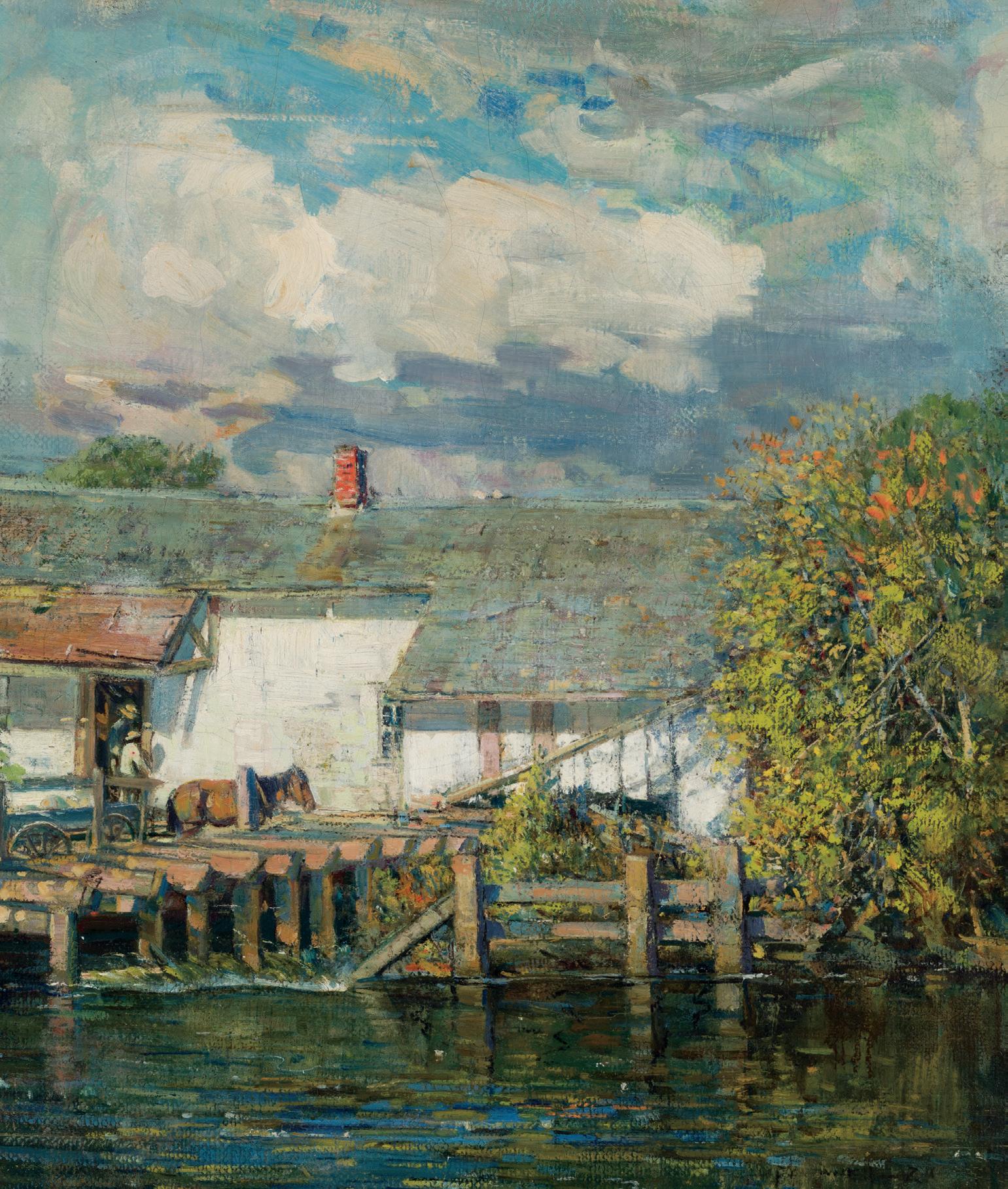
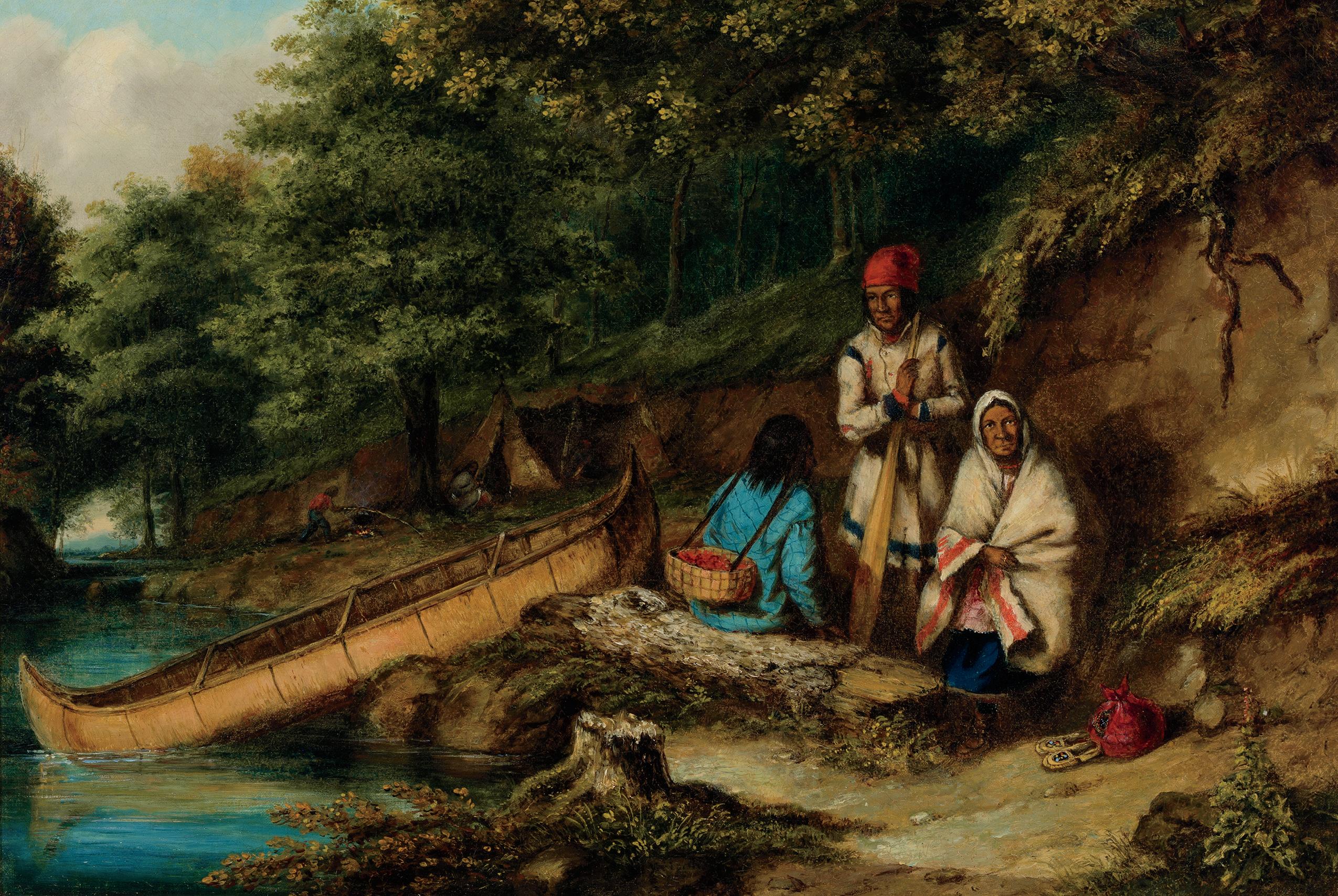
Caughnawaga Indian Encampment at a Portage (Family Resting by a Stream) oil on canvas, signed faintly and on verso titled and dated circa 1848 on the gallery labels and inscribed R.D.C. 26147 and É 8245 on plaques 14 × 21 in, 35.6 × 53.3 cm
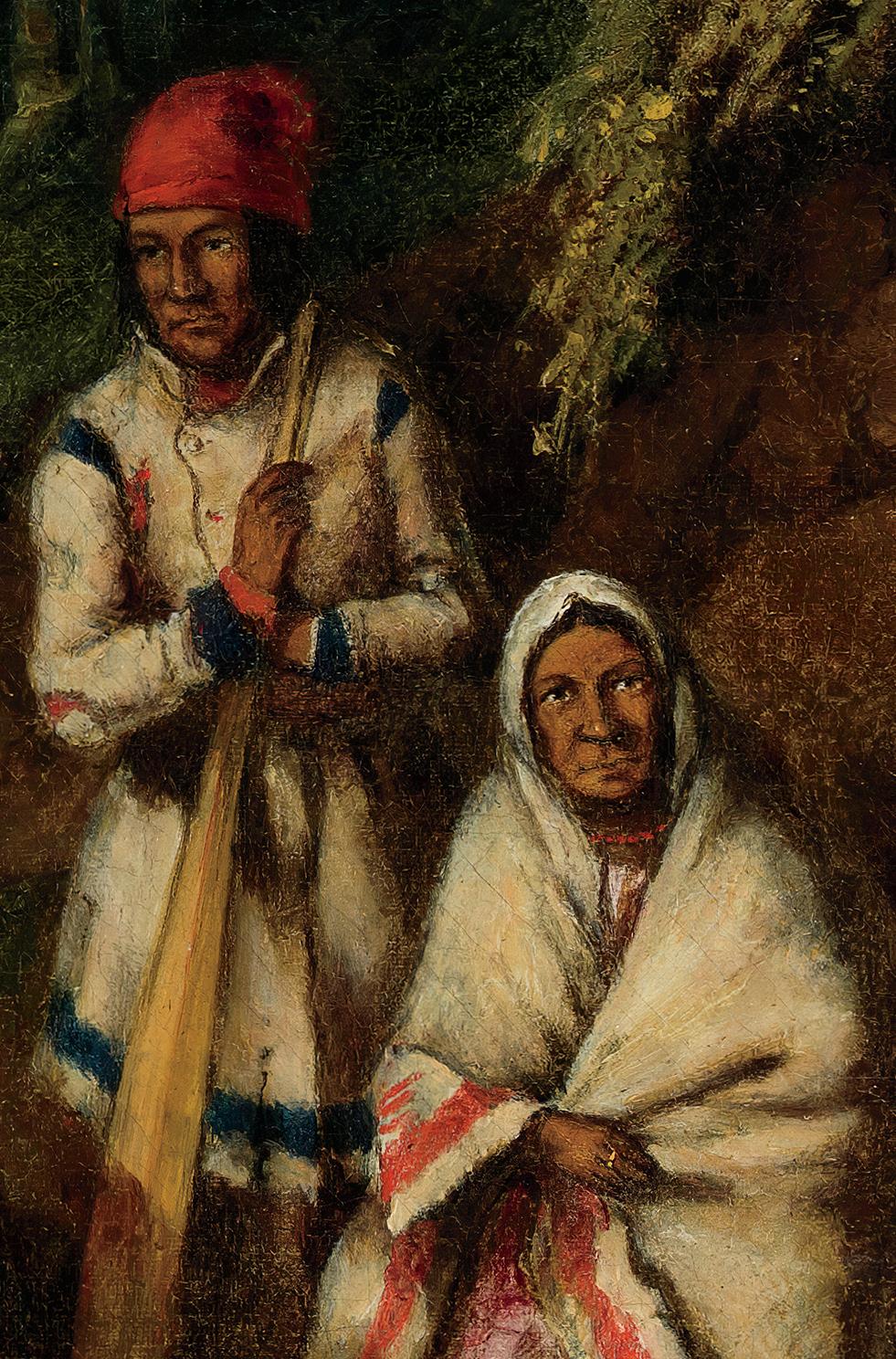
John Budden, Quebec City William Darling Sr., Montreal
Galerie Bernard Desroches, Montreal Galerie Claude Lafitte, Montreal Private Collection, Quebec City l iterature
Dennis Reid, Krieghoff: Images of Canada, Art Gallery of Ontario, 1999, the circa 1844 canvas Caughnawaga Indian Encampment at a Portage and the circa 1848 canvas A Caughnawaga Indian Encampment, both in the collection of the Royal Ontario Museum, reproduced pages 23 and 24, and the 1850 canvas
The Trader, in the collection of the Art Gallery of Hamilton, showing the same grouping of Indigenous people (with the same unusual blue jacket), reproduced page 30
fROM 1846 TO 1853, Cornelius Krieghoff lived in Montreal and Longueuil, and during this time, he often painted the Iroquois of Caughnawaga. During the summer, they left the village of Caughnawaga to live in the surrounding tribal lands. Typical of Krieghoff’s treatment of these scenes during this period, he paints a close-up view of a grouping by their birchbark canoe. Their clothing is meticulously detailed, showing a Hudson’s Bay blanket coat and shawl, a handsome blue jacket, a toque, mocca sins and a bag. Strapped to the back of the individual in blue is a basket of fruit, while in the background the artist includes a cou ple by a fire in front of their tent. It is a peaceful and idyllic scene, typical of Krieghoff’s romantic vision of Indigenous people.
Not only an extraordinary record of Iroquois life, Caughnawaga Indian Encampment at a Portage is also a beautiful landscape—a creek meanders by, an embankment gives a feeling of shelter, and through a distant arched opening emerge the sky and misty mountains. A triangle of open sky at the top reveals billowing white clouds, creating a dreamy atmosphere.
The first collector of this work was John Budden, an auctioneer from Quebec City who was a close friend of the artist.
Untitled (Camp Scene on the Ottawa) watercolour on paper on card, initialed, circa 1870 15 × 21 1/2 in, 38.1 × 54.6 cm
rovenan C e
fRANCES A NNE H OPKINS (née Beechey) has become wellknown as a result of a group of paintings with the subject of voyageur life and canoe travel that has been in the collection of Library and Archives Canada since 1921. Many of her other works remain in private and family hands, or are known only through exhibition catalogues. Hopkins’s life and work has been the subject of a number of popular and scholarly articles and essays 1 as well as two recent books, Thomas Schultze’s Frances Anne Hopkins: Images from Canada (2008) and MaryEllen WellerSmith’s biography France Anne Hopkins: Hudson’s Bay Company Wife, Voyageurs’ Artist (2022). Her work was the subject of the major exhibition Frances Anne Hopkins, 1838 – 1919: Canadian Scenery, organized by the Thunder Bay Art Gallery in 1990.
Born into an artistic family in 1838, Hopkins was homeschooled, and she was likely taught to draw and paint by her father, Frederick Beechey, RN , and her uncle Richard Brydges Beechey, who exhibited at the Royal Academy from 1832 to 1877.
In 1858, she married Edward Martin Hopkins, a widower 15 years her senior, and moved to Canada to help raise his three boys from a previous marriage. Her husband was a senior official in the Hudson’s Bay Company and was often absent on long journeys into the Canadian interior, or to England on company business.
From 1858 to 1870, she lived mostly in Lachine and Montreal, although she also returned to England for extended periods. During this time she gave birth to six children, only two of whom survived to adulthood. She was left to cope with a large house hold for extended periods of time, but nevertheless she pursued an artistic career, becoming involved with the Art Association of Montreal. She was also one of the founders of the Montreal Sketching Club in 1861.
Hopkins carried out a great deal of plein air sketching during her life in Canada, and she began to concentrate on the disap pearing life of voyageur travel. Canoes appear in the paintings of earlier nineteenth-century Canadian artists such as Paul Kane and Cornelius Krieghoff, but the canoe was an important subject in Hopkins’s oeuvre. She made many short canoe trips around Montreal, to Trois-Rivières and Carillon, in the early years of her life in Canada. In 1864, she accompanied her husband on a lon ger canoe trip along the north shore of Lake Superior from Fort William to Michipicoten, and in 1866, on a journey up the Ottawa River to Mattawa. In July and August of 1869, she and her hus band undertook an ambitious trip from Fort William to Montreal. As her husband noted in a letter to one of his fur trade colleagues: “Canoe travel agrees with her.” 2
In September of 1866, Hopkins shipped many of her Canadian watercolours back to London, where some were exhibited. 3 In the spring Conversazione of the Art Association of Montreal in 1870, she exhibited 16 watercolours, all related to her canoeing experiences. 4 That same year, she returned to England for good, returning to Canada only once, in 1884. In England, she con tinued to pursue her artistic career and exhibited widely, often drawing on her North American experiences. She passed away in March 1919.
This watercolour demonstrates Hopkins’s artistic power. The view is likely of the Ottawa River, as Hopkins and her husband traveled in a north canoe on the Ottawa, rather than a larger canot de maître. Her attention to detail in documenting the canot du nord and camp scene, as well as her ability to capture the rich and varied colours of a Canadian autumn, shows the stunning beauty of the landscape, at a time when canoeing transformed from being a necessity for travel and the transport of goods to a leisure pursuit. With its stunning effect of vibrant fall colours and the atmospheric effects of mist on the river and the rising smoke of the campfire, this is an outstanding watercolour by Hopkins. Her work in documenting a passing way of life is now recognized and celebrated as an important part of Canada’s art history.
We thank Jim Burant, adjunct professor of art history at Carleton University, independent curator and contributor to Frances Anne Hopkins: Images from Canada, for contributing the above essay.
1. This recognition includes Grace Lee Nute, “Voyageurs’ Art ist,” The Beaver, June 1947, 32–36; Alice M. Johnson, “Edward and Frances Hopkins of Montreal,” The Beaver, Autumn 1971, 14–19; Elisabeth Margaret Hopkins, “Grandmama,” The Beaver, Winter 1976, 25–29; Sylvia A. Antoniou, catalogue entries 25 and 26, The Painted Past (Ottawa: Public Archives of Canada, 1984), 41–43; Robert Sta cey, “Frances Anne Hopkins and the Canoe-eye-view,” Frances Anne Hopkins (1838–1919): Canadian Scenery (Thunder Bay: Thunder Bay Art Gallery, 1990), 44–57; Eva Major-Marothy, catalogue entry 21, A Place in History: Twenty Years of Acquiring Paintings, Drawings and Prints at the National Archives of Canada (Ottawa: National Archives of Canada, 1991), 46–49; Kristina Huneault, “Placing Frances Anne Hopkins: A British-Born Artist in Colonial Canada,” Local/Global: Women Artists in the Nineteenth Century (Burlington, VT : Ashgate, 2006), 179–99; and Jim Burant, “Frances Anne Hopkins, Making Memory and the Myth of Canadian Identity,” in Frances Anne Hopkins: Images from Canada (Manotick, ON : Penumbra Press, 2008), 11–22.
2. Much of the biographical information about Hopkins has been summarized and thoroughly researched by MaryEllen Weller-Smith in her excellent self-published book Frances Anne Hopkins: Hudson’s Bay Company Wife, Voyageurs’ Artist (Sheridan, MN : Jackpine Books, 2022). This particular quote is cited on p. 114.
3. Ibid., 129.
4. Ibid., 189–90.
e stimate: $ 70,000 – 90,000
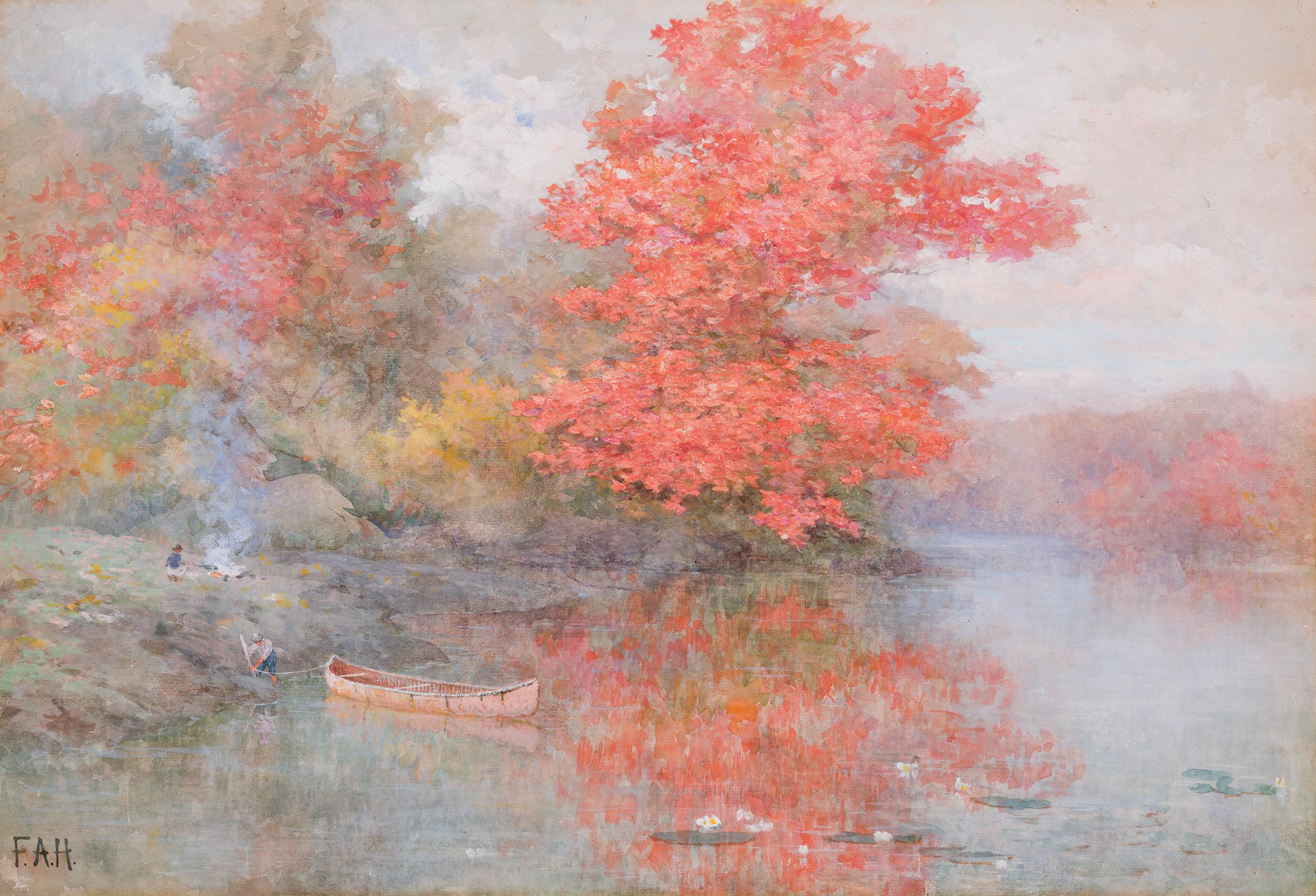

Caribou Hunters in a Winter Snow Storm oil on canvas, signed, circa 1860 12 × 20 in, 30.5 × 50.8 cm p rovenan C e
James Gibb, Quebec City
Mrs. David Ross, whose first husband was James Gibb
By descent to John Theodore Ross, Quebec City
By descent to a Private Collection, Vancouver Island
Private Collection, Montreal
Fine Canadian Art, Heffel Fine Art Auction House, November 8, 2001, lot 18, back cover lot
Private Collection, Montreal
Fine Canadian Art, Heffel Fine Art Auction House, November 24, 2005, lot 146
Private Collection, Quebec l iterature
J. Russell Harper, Krieghoff, 1999, a close-up detail showing Gibb and Krieghoff in the 1859 painting Death of the Moose, South of Quebec reproduced page 147
I T IS PROBAB ly fair to say that for Cornelius Krieghoff, the most important season was winter. His images of the people of Que bec playing, working and living their lives in a world of white are among his most sought after. The effects of snow and snowfall, so clearly seen in this canvas, suggest Krieghoff’s deep understand ing of the conditions of winter and his keen eye for what might prove to be popular subjects for his patrons, the merchants and military men of Montreal and Quebec.
Krieghoff paid close attention to all the details of the landscape in this fine painting—the various trees dusted with snow, the grey expanse of the sky and the wide open, snow-covered path. He showed his mastery of atmosphere in his depiction of the mist iness created by the falling snow as it gathers and obscures the
path in the distance. Similarly, he has been careful to depict the details of the clothing of the hunters and their rifles, and he sug gested a sense of their hardship in the snowstorm by showing the man laden with a pack trudging up the path, leaning into the wind.
In common with his best work, the element of narrative—here, a caribou hunt—is an important aspect of the painting. Krieghoff was aware that many of his paintings would not remain in Canada, and such a scene would have an element of exoticism for a viewer in England. Within Canada, Krieghoff had a strong following of collectors, who appreciated his ability to capture the essence of life in Quebec at the time.
A friend and patron of the artist who owned a number of his paintings, James Gibb, a banker, lumber merchant and prominent businessman, originally purchased this work. For Gibb it prob ably had a more personal sense—perhaps an experience shared with the artist, as Gibb often accompanied Krieghoff on hunting and fishing expeditions. The 1859 painting Death of the Moose, South of Quebec showed Gibb, Krieghoff, John Budden and their Indigenous guide gathered around a freshly killed moose.
A later owner, John Theodore Ross, also owned several important Krieghoff paintings. Ross possessed the masterpieces Merrymaking, 1860, now in the Beaverbrook Art Gallery, Fred ericton, NB , and Winter Scene in the Laurentians—The Laval River (The Crack in the Ice), 1867, subsequently in the Kenneth Thom son Collection. On verso of this painting is a photocopy of a black and white photograph showing Caribou Hunters in a Winter Snow Storm hanging in the Rosses’ home along with their other master pieces by Krieghoff.
Over 160 years later, Caribou Hunters in a Winter Snow Storm is, for us, a valuable record of Quebec history and a glimpse of a lost way of life.
e stimate: $ 40,000 – 60,000
Sketch in Algoma oil on board, signed Frank H. Johnston and on verso dated 1917 on various labels
8 1/2 × 5 3/4 in, 21.6 × 14.6 cm
p rovenan C e Roberts Gallery, Toronto
The Art Emporium, Vancouver, 1976 Private Collection, Edmonton
By descent to the present Private Collection, Edmonton
l iterature
Roger Burford Mason, A Grand Eye for Glory: A Life of Franz Johnston, 1998, page 32
[Algoma] is charted on a grand scale, slashed by ravines and can yons through which run rivers, streams and springs broadening into lakes, churning lightly over shoaly places or dropping with a roll and a mist for hundreds of feet.
f.B HOUSSERT HIS d RAMATIC d ESCRIPTION gives insight into why Algoma was a magnet for Frank Johnston and his fellow members of the Group of Seven. Johnston partici pated in three of the four Group trips to Algoma, including the first boxcar trip, in fall of 1918. Lawren Harris called it “a rugged, wild land . It was a veritable paradise for the creative adventurer in paint in the Canadian north.”
In this stunning composition, Johnston used a tree trunk stripped of its bark in the centre to anchor the foreground, at the edge of a viewpoint overlooking trees glowing with gorgeous fall colours of bright gold and orange. Beyond, ever greens rise in pointed triangular shapes, mixing with deciduous trees in softer tones of yellow. A strip of pale blue sky above creates a connection to the firma ment above the dense growth. Johnston’s fluid brushwork is assured, and his handling of the foreground trees is partic ularly exquisite, with his textural overlay of bright daubs of paint.
e stimate: $ 20,000 – 30,000

1969
Forest Giant, Vancouver Island oil on canvas, signed and dated 1956
indistinctly and on verso titled and dated on the gallery label 20 × 16 in, 50.8 × 40.6 cm
Galerie Walter Klinkhoff Inc., Montreal
By descent to a Private Collection, Montreal Fine Canadian Art, Heffel Fine Art Auction House, November 23, 2007, lot 171 Galerie Walter Klinkhoff Inc., Montreal Private Collection, Vancouver
Dennis Reid, Canadian Jungle: The Later Work of Arthur Lismer, Art Gallery of Ontario, 1985, page 50, three similar oils dated circa 1951 and entitled Forest Giant, Vancouver Island listed pages 84 and 85
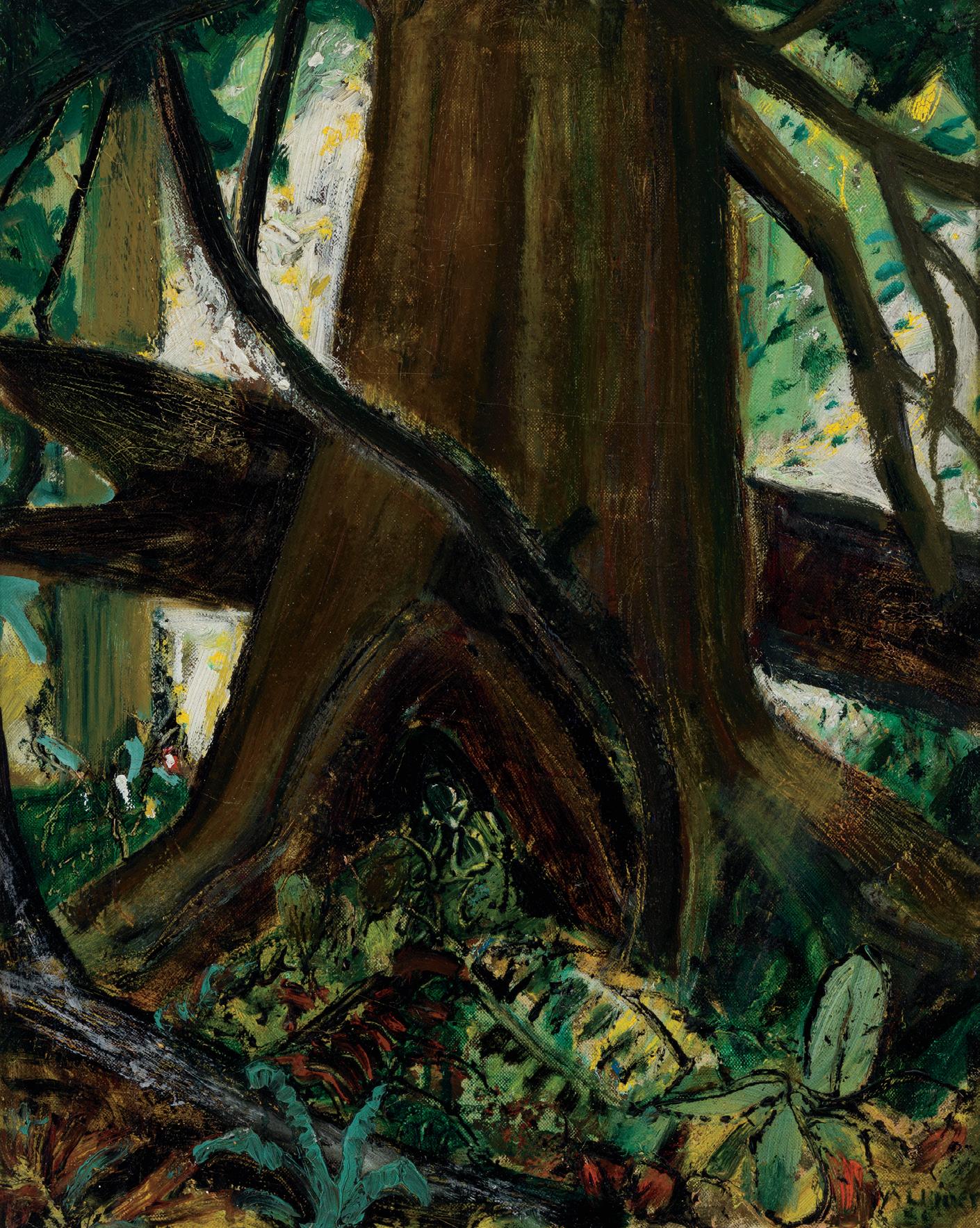
I N 1951 , A retrospective exhibition of Arthur Lismer’s work, originating at the Art Gallery of Toronto, traveled in an abbreviated version to the Art Gallery of Greater Victoria, the Vancouver Art Gallery and the UBC Fine Arts Gallery. This attention likely drew Lismer to take his first trip to the West Coast in the sum mer of that year. Using Galiano Island as a base, he explored Pender and Saltspring Islands, as well as Victoria and Long Beach on Vancouver Island. Inspired by the lush primeval rain forest, he would return for 16 summers. Lismer’s British Columbia forest and seashore paintings form an important part of his artistic oeuvre. His subjects were often closeups of undergrowth and the bases of trees. As described by Dennis Reid, “The dark trunks of trees—with but an occa sional glimmering shard of sky—form a swag-curtain background to the tumbling jewel-like plants of the forest floor.” For est Giant, Vancouver Island focuses on a mighty evergreen trunk, with limbs reach ing down like vines, backed by a massive log. Their dark mass is contrasted by the bright light streaming into a clearing behind. Voluptuous and jungle-like, Forest Giant, Vancouver Island is a powerful paint ing from Lismer’s West Coast works.
e stimate: $ 30,000 – 40,000
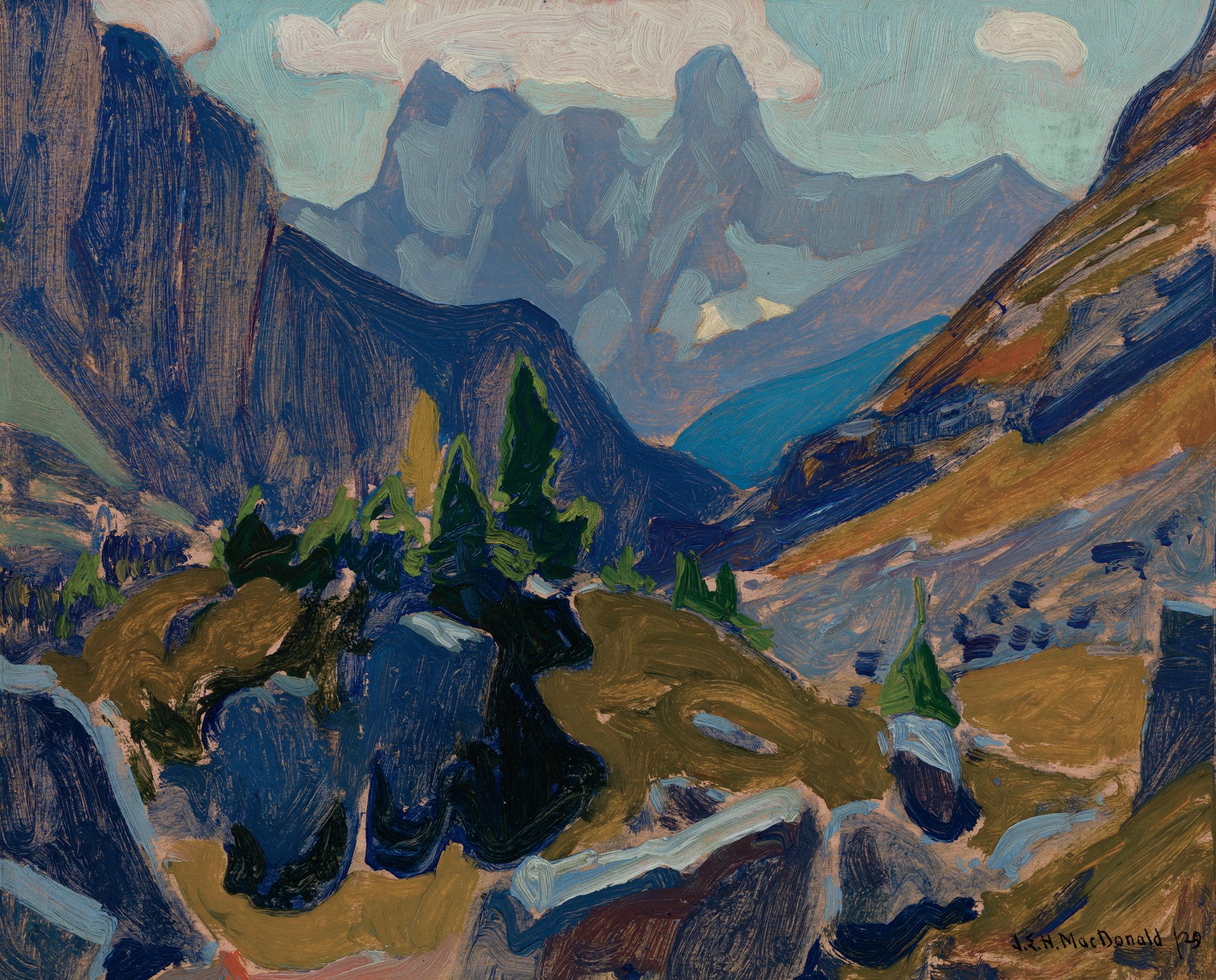
Mt. Goodsir from Odaray Bench oil on board, signed and dated 1929 and on verso signed, titled on the gallery labels and titled Mt. Goodsir from Odaray and dated August 1929 8 5/8 × 10 5/8 in, 21.9 × 27 cm p rovenan C e N.D. Young Loch Gallery, Calgary Masters Gallery, Calgary Private Collection, Toronto l iterature
Lisa Christensen, The Lake O’Hara Art of J.E.H. MacDonald and Hiker’s Guide, 2003, page 37, reproduced page 45 and the 1925 canvas Mount Goodsir, Yoho Park, in the collection of the Art Gallery of Ontario, reproduced pages 36 and 37
J.E.H. M ACdONA ld f IRST traveled to the Rockies in 1924, and he returned every year until 1930. He had already become accus tomed to wilderness hiking and camping with his fellow Group of Seven members, and in the Rockies he clambered up goat paths and rough tracks, loaded with his sketching gear, to capture stunning views such as this. In MacDonald’s journal entry on August 30, 1925, he describes this scene:
A beautiful day. Fine clear morning. Later a few cirrus and in afternoon small cumulus. The peaks all clear. Made sketch of Goodsir in morning light. Mountains beautifully clear and delicate in colour. Had lunch in lee of big rock on Odaray Bench, the snowflakes all round and a delightful warmth and freshness, thought at height of being and enjoyed everything completely.
In this powerful oil sketch, MacDonald captures the rough muscularity of rocky shelves, steep mountain flanks and soaring peaks. The scene is bathed in a clear light from a pale blue sky, in which cumulus clouds float behind the distinctive pointed tips of Mount Goodsir. MacDonald’s sharpened awareness of his subject and the elation he experienced in these mountains are fully pres ent in this striking oil sketch.
e stimate: $ 70,000 – 90,000
T HE f O ll OWING OI l paintings by Lawren Harris from the Lyle family rep resent the very finest examples of his three important subjects: Lake Supe rior, the Rocky Mountains, and the Far North. They have been lovingly cared for by the same family since they were purchased by Norah Lyle with assistance from Lawren Harris Jr. in the mid-to-late 1930s. Harris Jr. and Norah arranged to meet at the famed Studio Building, co-financed by Harris Sr. and Dr. James MacCallum as studio space for Group of Seven artists, and from the works stored there, Norah selected these three master pieces. We are aware of where this took place, as well as approximately when, since at this point Lawren Harris Sr. had departed Toronto for New Hampshire, and the invaluable inventory that Doris Mills completed for Harris in 1936 lists the location of each of these works as the “Studio Building.”
Norah and Harris Jr.’s friendship descended from their fathers’ friendship before them. Harris and Norah’s father John Lyle (1872 – 1945) formed a close connection based on their mutual search for a truly Canadian aesthetic. For Harris, this was through painting, and for Lyle, it was through architecture. After immigrat ing as a child with his family to Hamilton from Connor, Ireland, Lyle went on to be educated at Yale and the École des Beaux-Arts in Paris. Lyle’s first building design was Toronto’s beloved Royal Alex andra Theatre, begun in 1905, and years later, amongst many other important projects, he co-designed Toronto’s monumental Union Station, completed in 1927.
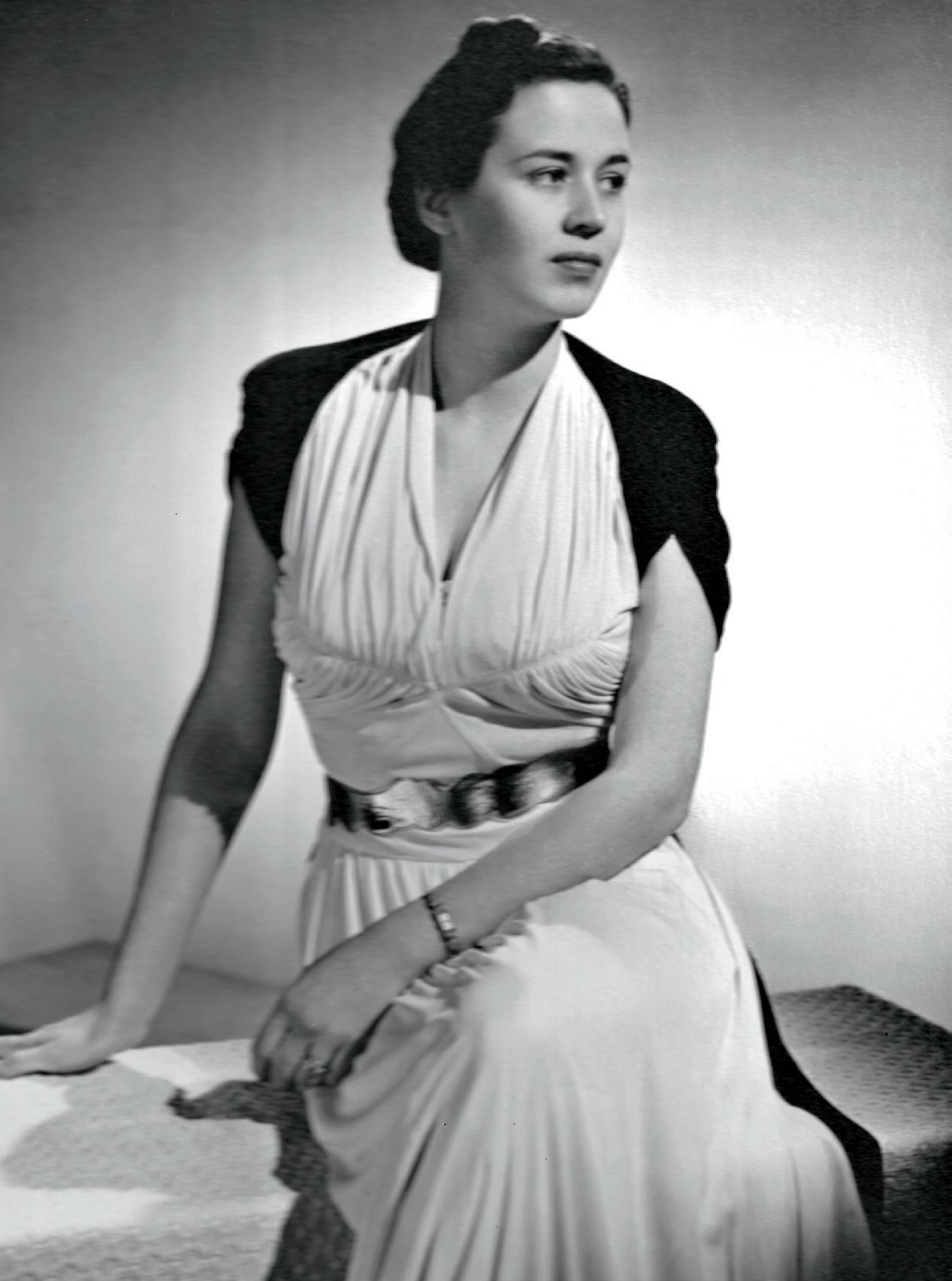
Stirred by the aims of Harris and the Group, Lyle became increasingly drawn to developing a uniquely Canadian style in the arts, leading to his design of the Runnymede Public Library in 1929. For its construction, he incorporated elements inspired by rural Canadian architec ture, and used local materials such as yellow limestone from Ontario’s Credit Valley. His work reached its peak in what is considered Lyle’s masterpiece, the Bank of Nova Scotia in Halifax, with his integration of 86 separate emblems of Canada throughout its edifice, completed in 1931. In a fascinating overlap of creative force, the three artworks Norah acquired were produced by Harris during the same years as some of Lyle’s most notable accomplishments.
Lyle’s lifelong commitment to a particularly Canadian vision also led him to become the third president of the Art Gallery of Toronto (now the Art Gallery on Ontario), and he guided the institution through the harrowing years of World War II . When asked if the gallery should stay open throughout the war, Lyle responded:
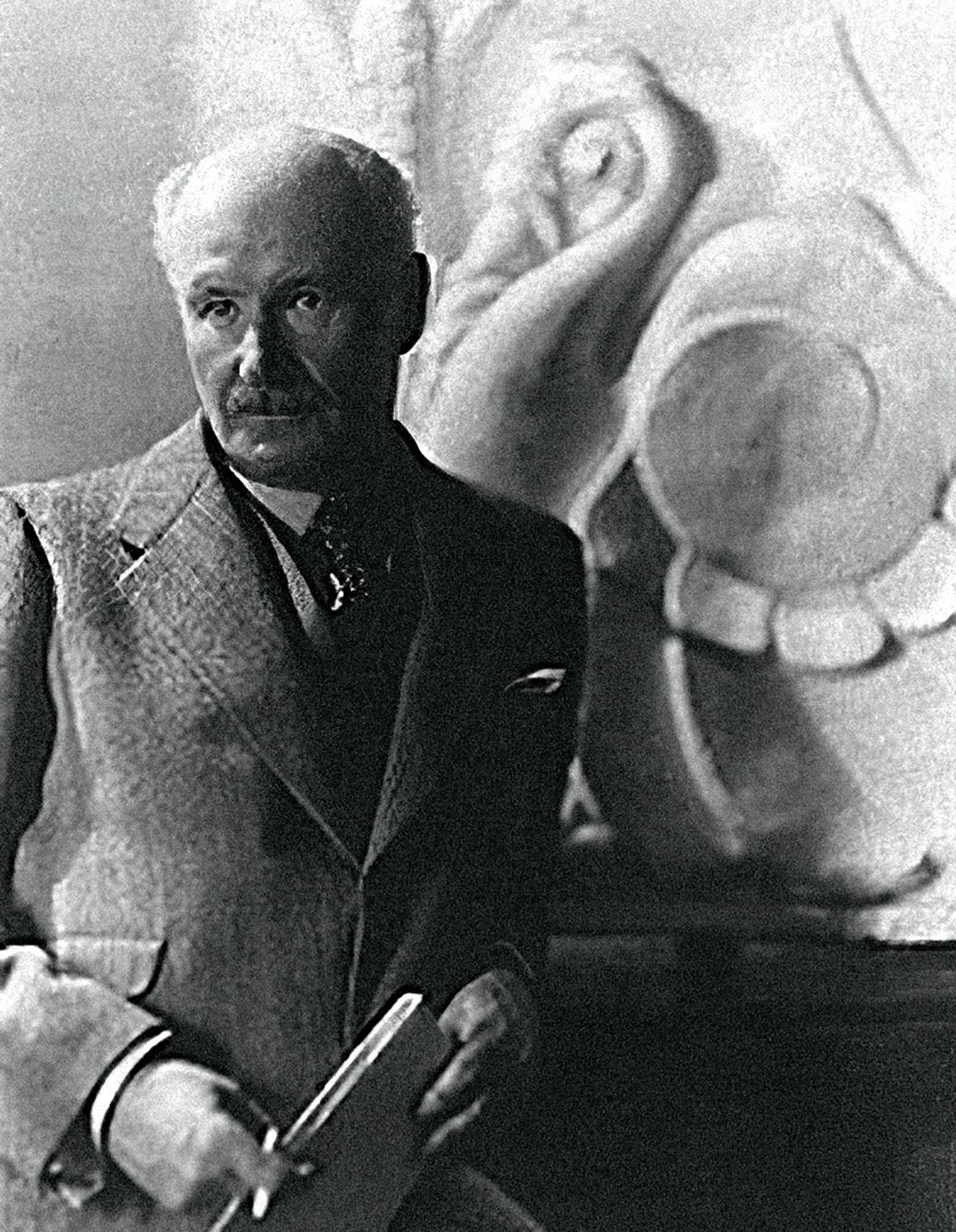
We stand for the preservation of our intel lectual and spiritual resources. Art is the visible and imperishable expression of free minds and, therefore, typifies one of the great goals we are fighting for. It is an escape from the present and a source of inspiration for the future.
Like Harris and the other members of the Group of Seven, Lyle sought a purer and more authentic celebration of Canadian beauty. It is our great fortune that he instilled these same ideals in his daughter, Norah, as she did in her descendants, who have so devotedly stewarded these exceptional paintings over many years.

From Berg Lake, Evening oil on board, on verso signed twice, titled variously and inscribed Six Sketches of Mount Robson, Mountain Sketch IX and 25 Severn St. and with the Doris Mills Inventory #7/4, circa 1929 12 × 15 in, 30.5 × 38.1 cm
Acquired directly from the Artist, with the assistance of Lawren P. Harris, by Norah Lyle, Toronto, circa 1936 By descent to the present Private Collection, New York and Victoria l iterature
Doris Mills, L.S. Harris Inventory, 1936, Rocky Mountain Sketches, Group 7, catalogue #4, location noted as the Studio Building, and a drawing of the painting illustrated by Hans Jensen
Jeremy Adamson, Lawren S. Harris: Urban Scenes and Wilderness Landscapes, 1906 – 1930 , Art Gallery of Ontario, 1978, a similar oil entitled Mount Robson from Berg Lake reproduced page 174
Lisa Christensen, A Hiker’s Guide to the Rocky Mountain Art of Lawren Harris, 2000, the circa 1924 – 1929 graphite drawing for this work entitled Mount Robson (accession #18712), collection of the National Gallery of Canada, reproduced page 33

Steve Martin, Cynthia Burlingham and Andrew Hunter, The Idea of North: The Paintings of Lawren Harris, 2015, a similar oil entitled Mount Robson from the Northeast, in the Thomson Collection at the Art Gallery of Ontario, reproduced page 109
Art Gallery of Toronto, Ontario Society of Artists, Little Pictures, December 1930, catalogue #469
Art Gallery of Greater Victoria, on loan from 2015
lAWREN H ARRIS ’ S From Berg Lake, Evening is an exceptional and striking work, an absolute triumph of the artist’s ability to capture the underlying spirit of the Canadian landscape and translate it into tangible form. Set against an entrancing deep indigo sky, Mount Robson, the highest peak in the Canadian Rockies, is the subject of this transcendent oil sketch, with its massive glaciers and snow-covered slopes radiating an other worldly glow in the dying light of the day. This crystalline portrait of solemnity, stillness and power, distilling the massive scale and grandeur of the “Monarch of the Canadian Rockies” to within the bounds of a 12 × 15 inch beaverboard panel, is a testament to Harris’s remarkable artistic vision, and a superb example of his finest work in the mountains. In 1933, Harris wrote that “the arts epitomize, intensify and clarify the experience of beauty for us, as nothing else can,” reiterating what paintings such as this demon strate so effectively: the power of creative work to reveal the underlying spirit of the world around us, and foster a newfound pathway to deep appreciation. 1
Harris’s landscape paintings of Canada have mesmerized and captivated collectors and the public for over a century. His diverse subjects, ranging from the abundant vitality of Algoma’s rivers and lakes to the austere desolation of Lake Superior’s burnt-over North Shore, and from the calm comfort of decorative snowcovered forests to the drama and humanity of vibrant urban scenes, hold places of importance in Canadian cultural history. Yet no subject carries quite the same significance and immediate association with the artist as the Rocky Mountains. As Harris’s work evolved in the 1920s, shifting from subject to subject, his style also progressed, following a trajectory where he became, in his own words, “more vigorously selective, and [I] sought to have no element, no line or colour in the picture that did not contribute to the unified expression. This led to the utilization of the elements of the North in three dimensions—an organization in depth, giving a still fuller meaning, a still deeper significance to every form and to the relationship of all the forms in the pic ture.” 2 Harris was able to apply this disciplined and deliberate methodology effectively in the mountains. There, the topograph ical legacy of geological change provided abundant diverse and fascinating forms, allowing for an almost sculptural approach to compositions, at a scale where detail and decorative patterns could be eschewed in service of representing the indwelling spirit of the landscape instead.
The Rocky Mountains provided the inspiration for many of Harris’s most well-known and highly revered works of art, and
From Berg Lake, Evening is a stunning addition to this oeuvre. Held in a private collection since it was acquired directly from the art ist’s studio in the mid-1930s, it emerges confidently holding its own among iconic compositions like Mountain Forms (sold by Heffel November 23, 2016, lot 118), Mount Lefroy (McMichael Canadian Art Collection), Mount Robson, (McMichael Canadian Art Collection) and Isolation Peak (Hart House Permanent Collec tion, University of Toronto). All of these works represent Harris at the pinnacle of his career, and all were completed within a few years near the end of the 1920s. In fact, despite the lasting legacy and impact of Harris’s mountain works, the artist made only four or five sketching trips to the Rockies during his landscape period. Beginning with a trip to Jasper in 1924 alongside A.Y. Jackson, Harris then returned regularly for several summers, continually expanding his explorations and culminating in a final visit in 1929, during which he spent most of his time in Mount Robson Provincial Park (created in 1913, it was British Columbia’s second provincial park).
It was this last trip in 1929 from which this work originates. Harris’s main base during his time at Robson was most likely the Berg Lake Chalet, opened in 1927 by Roy Hargreaves on the shores of the eponymous lake which lies at the base of Robson,
over 20 kilometres in from the railway line below. Harris’s artis tic output from this trip is quite prolific. He explored all around the lakes, glaciers, ridges and mountain passes in the area, and mapping his sketching locations clearly demonstrates his skills as an intrepid mountaineer and adventurer—he ranged far beyond where today’s hiking trails would take one in the park. In these conditions, while Harris was still working on his oil on board sketches in the field, the role of the pencil sketch became much more prominent as an initial means to capture the abundance of material in situations where carrying multiple sketching panels, or stopping to paint in fast-changing mountain weather, might prove to be challenging.
The partially disassembled Sketchbook 6 , in the collection of the Art Gallery of Ontario (and the now widely distributed other drawings that once completed it), constitutes much of Harris’s work from this 1929 trip. One drawing, Mount Robson (figure 1), now in the collection of the National Gallery of Canada, matches From Berg Lake, Evening as a direct predecessor and related work. The pencil sketch, with its sense of sublime tranquility, perhaps originates from the end of a long day of exploration, with Harris viewing the last of the evening light shining on Mount Robson as he descended back towards his camp after a trip high in the

Mount Robson from Berg Lake oil on board, circa 1929 12 × 15 in, 30.5 × 38.1 cm
Private Collection
Not for sale with this lot
alpine sketching places like Hargreaves Glacier, or the views from Mount Munn and Mount Anne-Alice. Harris would have returned to camp with a sketchbook full of ideas, and perhaps worked up the oil sketch by the lakeside, or saved it to revisit later back in his studio in Toronto, where he could give careful consideration and attention to its many refined elements. The delicate treatment of the deep blue-green water and its soft reflections of Tum bling Glacier, the subtle ombre along the western slopes below the Emperor Face, where the cool white of the snow transitions into the warm maroon brown of the rock, and the precise brushstrokes used to delineate the essential geometry of the mountain: all of these components demonstrate that this is truly a master work that demonstrates Harris’s stellar technical prowess and his clarity of vision.
From Berg Lake, Evening is one of six depictions of Mount Robson that Harris exhibited as a series of panels in late 1930, showing the varied profiles and moods of the mountain. This work is naturally paired with Mount Robson from Berg Lake / From Berg Lake, Morning (figure 2, sold by Heffel November 23, 2016, lot 209). Both are powerful portraits of majesty with similar compositions, and comparing the two reveals Harris’s expert wielding of light and colour to create atmosphere, with the
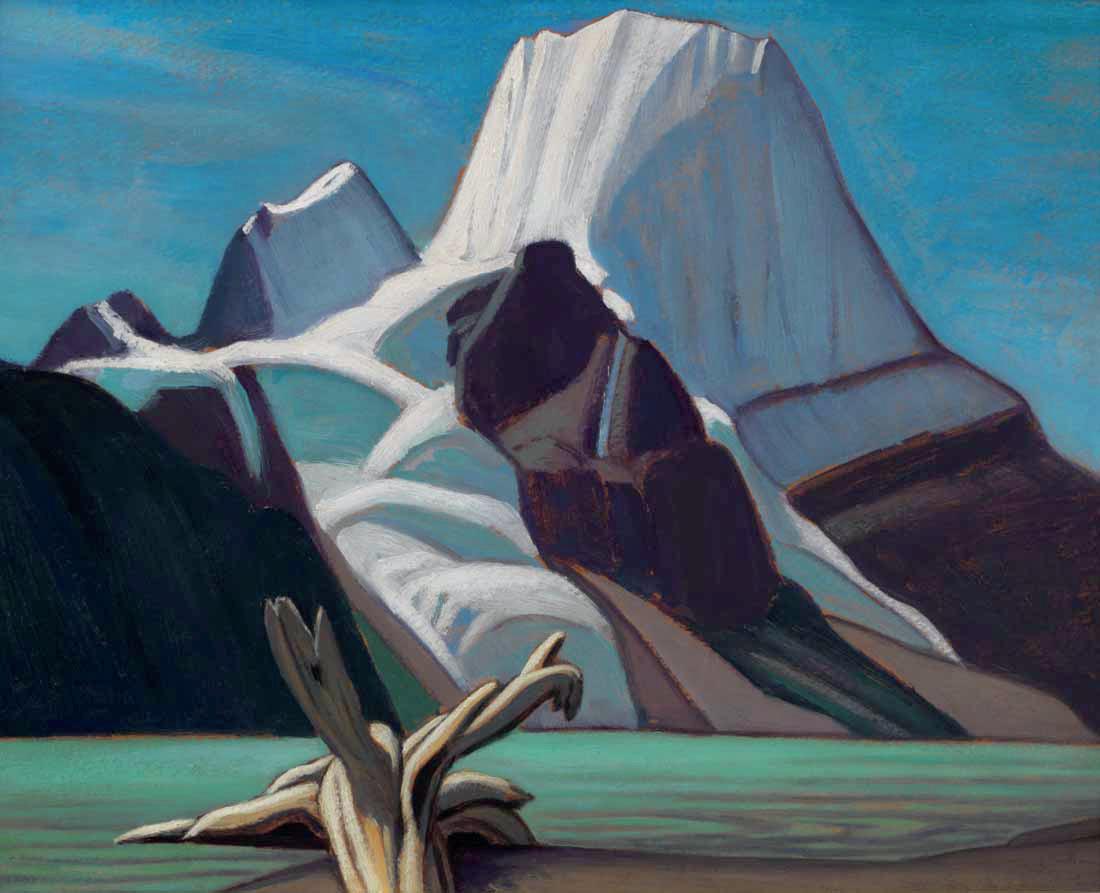
glowing darkness of evening and comforting rich tones being the perfect complement to the brilliant and sharp light of the graceful morning scene. The other works in this series include the often published Mount Robson from the Northeast (the Thom son Collection at the Art Gallery of Ontario) and the sketch for the aforementioned canvas at the McMichael Canadian Art Col lection, Mount Robson. As a series, these six mountain paintings, with their notable integration of an increasing abstraction of the natural landscape, could alone secure Harris’s legacy as a leader in defining a uniquely Canadian visual language. Taken as a part of his wider and diverse catalogue, From Berg Lake, Evening is an outstanding addition to the evidence of Harris being one of the most important and fascinating artists in Canada’s history.
We thank Alec Blair, Director/Lead Researcher, Lawren S. Harris Inventory Project, for contributing the above essay.
1. Lawren Harris, “Theosophy and Art,” The Canadian Theosophist 14, no. 5 (July 15, 1933), 129.
2. Lawren Harris, quoted in Lawren Harris, ed. Bess Harris and R.G.P. Colgrove (Toronto: Macmillan, 1969), 51.
$ 700,000 – 900,000
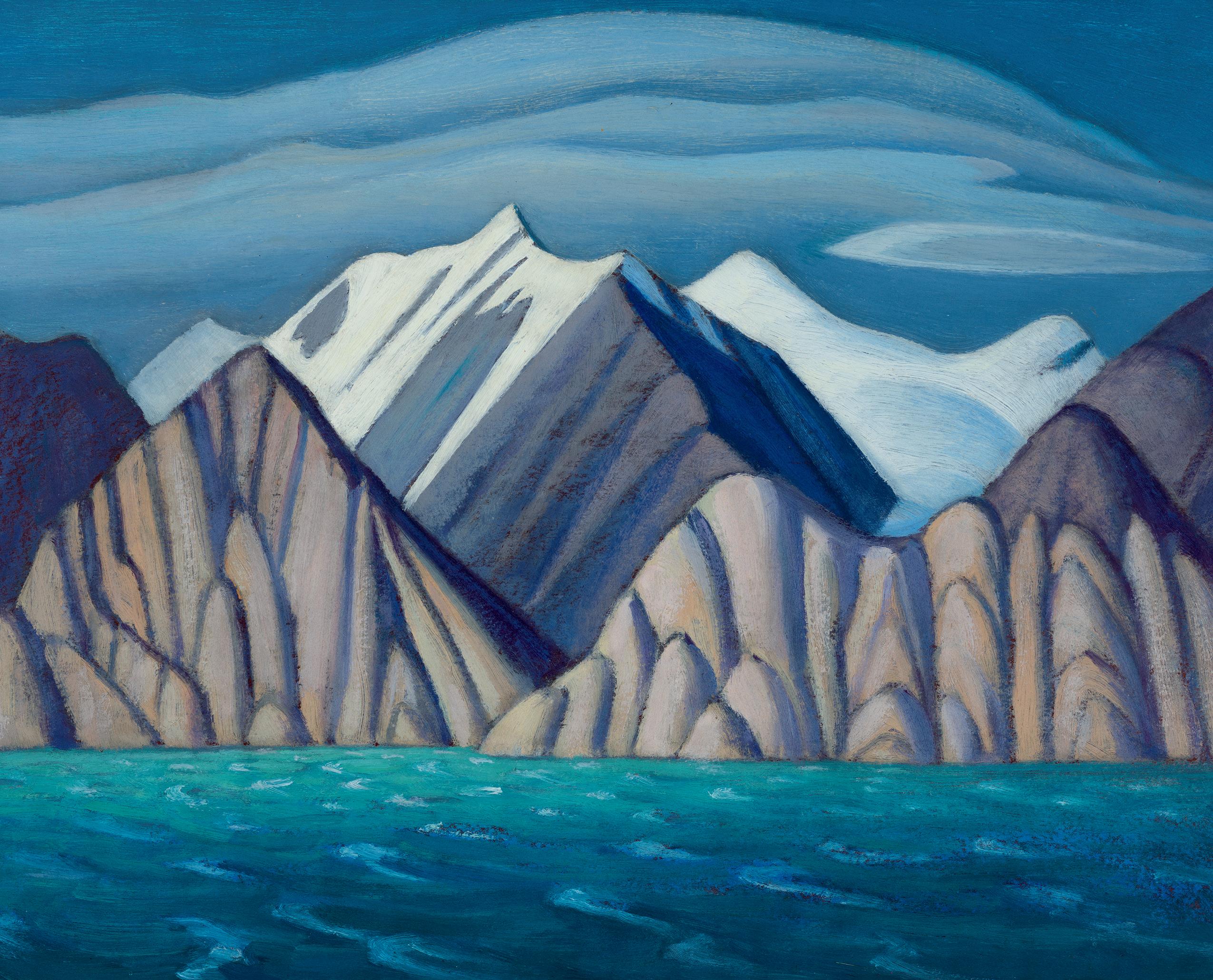
oil on board, on verso titled partially on the remnants of the artist’s label and inscribed in graphite N. Lyle and with the Doris Mills Inventory #1/15, 1930 12 × 15 in, 30.5 × 38.1 cm
Acquired directly from the Artist, with the assistance of Lawren P. Harris, by Norah Lyle, Toronto, circa 1936
By descent to the present Private Collection, New York
l iteratureDoris Mills, L.S. Harris Inventory, 1936, Arctic Sketches, Group 1, catalogue #15, location noted as the Studio Building, and a drawing of the painting illustrated by Hans Jensen
Jeremy Adamson, Lawren S. Harris: Urban Scenes and Wilderness Landscapes, 1906 – 1930 , Art Gallery of Ontario, 1978, a similar work entitled Bylot Island i, private collection, reproduced page 201
Christopher Jackson, Lawren Harris: North by West: The Arctic and Rocky Mountain Paintings of Lawren Harris, 1924 – 193 1, 1991, a similar work entitled South Shore, Bylot Island, private collection, reproduced page 55, plate 13
Peter Larisey, Light for a Cold Land: Lawren Harris’s Work and Life An Interpretation, 1993, a similar work entitled Bylot Island i, private collection, reproduced plate 33
T HERE IS A mythical aura to the arctic works of Lawren Harris, a certain sense of fulfillment that they bring to his artistic journey in the depiction of Canadian landscape. All of them originate from the artist’s single expedition to the region in 1930, which would be the last sketching trip that Harris would take with a fellow member of the Group of Seven, and in fact, his own final journey into the realms of the Canadian landscape with the express purposes of sketching and painting it. In the years shortly after this trip, Harris’s artistic focus would shift significantly, and he would adopt non-objective abstraction as his main subject for the remainder of his career. Works such as this luminous Arctic Sketch X v , and the other 48 oil sketches we know resulted from this trip, represent the artist’s final word on the landscape of Can ada, and provided him with the satisfaction and freedom to move into more purely universal realms.
This expedition to the Arctic took place aboard the SS Beothic, which departed from Sydney, Nova Scotia at the beginning of August 1930. Harris was accompanied by A.Y. Jackson, who had been a passenger on the ship three years prior, sketching along side Dr. Frederick Banting. After hearing favourable reviews of this 1927 trip, and having had the chance to appreciate the resulting works (Harris owned copy number 1 of Jackson’s signed book of arctic drawings, The Far North), it must have been clear to Harris that the Arctic was full of potential subject matter that would suit his current fascinations and style. His artwork had evolved throughout the 1920s, and in the couple of years prior to this journey, his work in Lake Superior and the Rockies had adopted a much stronger focus on the austere and the expansive.

Island I oil on canvas, circa 1930 32 × 45 in, 81.3 × 114.3 cm
Private Collection
Private Collection
Not for sale with this lot
His mountain works in particular seemed to be foreshadowing the subjects he would find on this trip: alpine peaks and patterns of rock, snow and glacier, with an increasing focus on solid form and the distillation of only the most essential and core elements of the massive subjects manifesting in his drawings and paintings. In retrospect it would appear inevitable that he might follow up his work on the inland sea of Lake Superior and the Rocky Moun tains in a location where he could bring the two together—the dramatic coasts of the Arctic.
Arctic Sketch X v provides a stellar example of connections that can be drawn to preceding works. The pyramidical peaks of the foreground, shining in the warmth of the sun, could have been taken directly from the top half of a work like Mountain Forms (a point that Arthur Lismer comically pointed out at the time in a cartoon, now in the collection of the National Gallery of Canada, which reads “Mr Laurentian ’Arris changes his mountains into icebergs with a single stroke of his brush,” showing Harris in front of recently altered mountain canvases with a large bucket labeled “blue” on the floor). Yet, while the scalloping, strong lighting and snow patterns are familiar, the overall colour palette clearly distinguishes this as an entirely distinct subject. The inviting gradation of light on the water, from deep teal to a bright greenblue, contrasts strikingly against the pale grey and tans of the rock forms, and draws from Harris’s explorations of light and water on the north shore of Lake Superior, but is totally reinvented in this novel context.

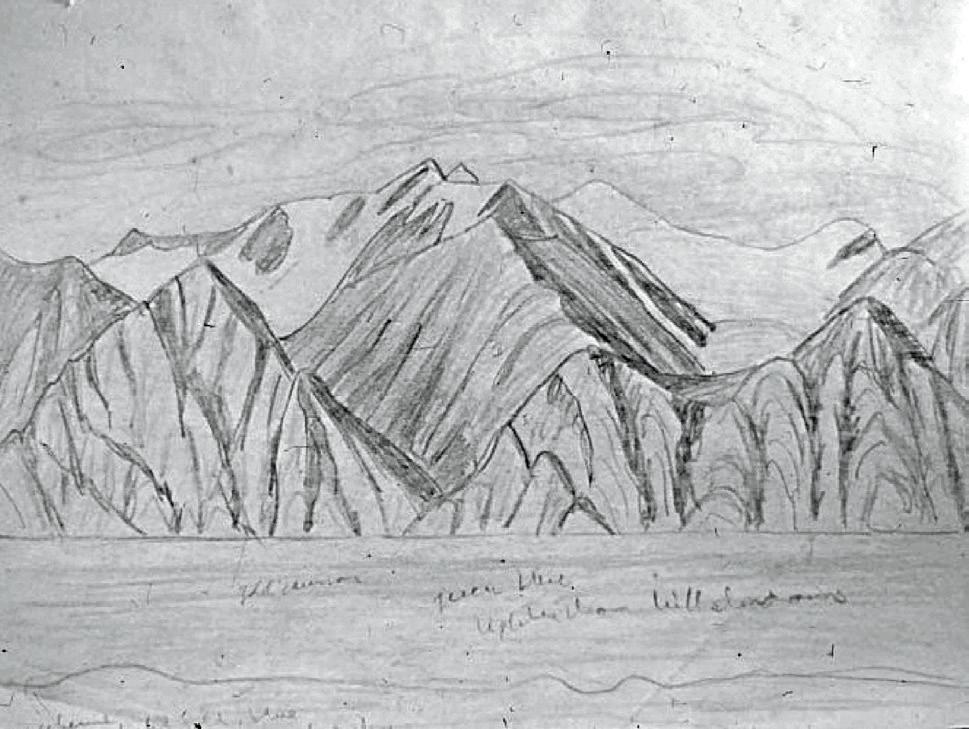
Throughout the 1920s, Harris had developed a methodology that integrated the use of preliminary graphite drawings (or notes,
as he and Jackson would refer to them) much more prominently. This was perhaps born out of convenience in the Rockies, where the need to always carry heavy paints and panels up steep slopes and into potentially inclement weather would be a challenge. But in the Arctic, it became a necessity, as Harris recounted: “While we were on this trip Jackson and I painted a large number of sketches, although painting was difficult as we usually saw the most exciting subjects while steaming through channels or while being bumped by pack ice. On many occasions we had time only to take rapid notes. These notes we worked up into sketches, crowded into our small cabin, seated on the edge of our respective bunks with only a porthole to let in the light.” 1 Beyond addressing logistical challenges, the use of preliminary pencil sketches seems to have allowed Harris additional opportunity to consider the composition and the most salient core elements. It was obviously an important methodology for the artist, as he seems to have used it even while the ship was anchored for sev eral days, as in the case with this work, which was based on a drawing from his Arctic Sketchbook (figure 1, Drawing 273, Book 7 , currently unlocated).
The subject of the drawing, and the subsequent panel, is the southern shore of Bylot Island, looking across Eclipse Sound. According to Jackson’s recounting of the trip, they anchored there, off of Pond Inlet, on the evening of August 26 and left on August 31, 1930. During that stay, Harris drew abundant inspi ration from the surrounding dramatic landscape, resulting in at least seven oil sketches of the area and numerous canvases. The most closely related to Arctic Sketch X v is a sketch entitled South
Shore, Bylot Island (private collection) and the brilliant canvas Bylot Island i (figure 2, sold by Heffel May 26, 2010, lot 165). The region depicted in all of these works is now part of Sirmilik National Park, an Inuktitut name meaning “the place of glaciers,” reflecting the legacy of over 2,000 years of human occupation in the area, and the ongoing importance of the place to the commu nities of Pond Inlet (Mittimatalik) and Arctic Bay (Ikpiarjuk).
The Beothic made the stop at Pond Inlet on its way south, and the open water and spectacular mountain views were clearly a bit of welcome peace after some tense days of adventure. After hav ing battled ice floes and almost running aground in shallow water near Bathurst Island, the Beothic had worked its way through Lan caster Sound, where Harris and Jackson painted the ice. Harris later recounted, “From this point we went south along the coast of Ellesmere Island into Lancaster Sound where we were held up by ice for days. For four hours on our way out the ship was in danger of being crushed by the immense weight of the huge mov ing ice flows. We then went around the top of Baffin’s Island.” 2

With these experiences in mind, Arctic Sketch Xv’s brightly lit and luminous shoreline mountains and eerie glaciers, contrasted against foreboding and ominous dark clouds behind, are a fitting representation of the ever-present connection between beauty and danger in this remote region of the world, a true visual depic tion of the awesome. Austrian poet Rainer Maria Rilke captured such a tension in 1923’s Duino Elegies, “For beauty is nothing but the beginning of terror which we are barely able to endure, and it amazes us so, because it serenely disdains to destroy us.” It is exactly this kind of beauty and amazement that Harris found
in the entrancing power of the Arctic, and it radiates from this superb panel.
For Harris, the works depicting the Arctic represent the cul mination of his mission to define Canadian visual art on its own terms, and they provided the necessary inspiration and satisfac tion to allow him to continue his evolution into pure abstraction. It was clear, even to contemporary audiences, that this was the direction the work was taking him in. It is as though all of Harris’s prior landscape painting somehow led him, almost unescapably, to the Arctic, and prepared him to create stunning works such as this panel. And, in turn, it was the arctic works, and perhaps the sense of completion they brought to that phase, that allowed him to move into the abstract realm. The emergence of important works such as this is exceedingly rare and exciting these days, and Arctic Sketch X v , once again, is a welcome addition to the catalogue of Harris’s phenomenal artistic achievements.
We thank Alec Blair, Director/Lead Researcher, Lawren S. Harris Inventory Project, for contributing the above essay.
1. Lawren Harris, The Story of the Group of Seven (Toronto: Rous & Mann, 1964), 24.

Ibid.
stimate: $ 700,000 – 900,000

Lake Superior Sketch XI oil on board, on verso signed, titled and inscribed with the Doris Mills Inventory #4/11, circa 1925 1928 12 × 15 in, 30.5 × 38.1 cm
Acquired directly from the Artist, with the assistance of Lawren P. Harris, by Norah Lyle, Toronto, circa 1936
By descent to the present Private Collection, Victoria
l iteratureDoris Mills, L.S. Harris Inventory, 1936, Lake Superior Sketches, Group 4, catalogue #11, location noted as the Studio Building, and a drawing of the painting illustrated by Hans Jensen
Lake s u P erior s ket C h X i , an evocative and meditative work, is a prime example of the artistic maturation that occurred for Lawren Harris on Lake Superior’s North Shore. As one of his most frequently visited sketching grounds (he would visit at least seven times between 1921 and 1928), it was the site of some of his most critical developments, and where he was able to explore new modes of expression and ways of communicating the beauty that he found in the Canadian landscape. Here, in recently burnt-over forests, and on headlands towering above the expansive lake, the sense of space gave Harris the chance to explore the landscape in ways that prior trips to the Algoma region, and its abundant, often encroaching vitality, had not.
Once again working alongside his fellow members of the Group of Seven on sketching trips to the North Shore, Harris benefited from the same camaraderie that in Algoma had supported the production of new, vigorous and exciting depictions of the Canadian North. Here, again, Harris was able to continue to push the boundaries of what his landscape art could be, and his fellow artists recognized his resonance with this place. A.Y. Jackson, Harris’s most frequent sketching companion, pointed out Harris’s desire in the 1920s for something “bare and stark,” 1 and it was certainly found here. Jackson would later write: “It was this country that gave Harris the motives for many of his best known canvases. There was a feeling of space, dramatic lighting, the stark forms of rocky hills and dead trees, and beyond, Lake Superior, shining like burnished silver. However bold the artist’s conception of it was, it seemed inadequate.” 2
It is in this spirit of boldness that Harris developed a series of works, of which Lake Superior Sketch X i is wonderfully represen tative, that moved beyond earthly subjects and into more ethereal territory. He began to directly focus on the subject of light itself,
and its interplay as it reflected off the great lake. This approach was born of repeated trips to the region, during which an evolu tion occurred in Harris’s practice, including a process of paring down his subjects. While much of his focus early on involved the vibrant, changing autumn vegetation, on his later visits (the size of this sketching board indicates it was from one of the trips between 1925 and 1928), he became much more austere in his depictions. The works that resulted became self-contained worlds, in which the islands and headlands of Lake Superior are the stage upon which great dramas of light, cloud and water are performed.
This motif was so important to Harris that he created and exhibited multiple major canvases from his sketches, including several from the same exact perspective as this sketch, which are now in major public collections, among them Clouds, Lake Superior (collection of the Art Gallery of Winnipeg) and Lake Superior iii (the Thomson Collection at the Art Gallery of Ontario).
Lake Superior Sketch X i , and other similar depictions, were opportunities for Harris to explore his ideas relating to the unity between the different realms of the universe. The warm yellow light that shines from behind the cloud forms is matched by its reflection off the water, both illuminating the dark shore with the same intensity. In viewing these scenes, observing the reci procity of these phenomena, their symmetry in patterns, we join Harris in considering the connections between our worldly expe riences and those that transcend our perception. They make clear Harris’s motivations and beliefs about his work, which included the idea that “our spirits emerge into purer creative work wherein they change the outward aspect of nature, alter colours, intensify forms, purge rhythms of pettiness, and seek to enable the soul to live in the grand way of certain wondrous moments in the North, when the outward aspect of nature becomes for a while full luminous to her informing spirit—and man, nature and spirit are one.” 3
We thank Alec Blair, Director/Lead Researcher, Lawren S. Harris Inventory Project, for contributing the above essay.
1. A.Y. Jackson, A Painter’s Country: The Autobiography of A.Y. Jackson (Toronto: Clarke, Irwin, 1958), 57.
2. A.Y. Jackson, “Lawren Harris: A Biographical Sketch,” in Lawren Harris: Paintings 1910–1948 , ed. Sydney Key (Toronto: Art Gallery of Toronto, 1948), 11.
3. Lawren Harris, quoted in Lawren Harris, ed. Bess Harris and R.G.P. Colgrove (Toronto: Macmillan, 1969), 61.
e stimate: $ 300,000 – 500,000
At St. John’s, Newfoundland oil on board, signed and on verso signed twice, titled by the artist and on the gallery label, dated circa 1921 on the gallery label, inscribed Property N.D. Young, purchased from the artist about 1958 and certified by the artist’s son, Lawren P. Harris, September 22, 1980 10 1/2 × 13 3/4 in, 26.7 × 34.9 cm p rovenan C e
Acquired from the Artist by N.D. Young, circa 1958 Roberts Gallery, Toronto Private Collection, Ontario
fROM 1918 TO 1923 was a period of social realism for Lawren Harris, and an important subject for him was houses—principally in Toronto’s working-class neighbourhood of the Ward. He also depicted houses in outlying towns such as Barrie and Lake Simcoe.
In late winter or early spring of 1921, Harris went east to New foundland and Nova Scotia to paint. In Nova Scotia, he painted the tenements he found in Halifax. However, his Newfoundland subjects were more upbeat—he painted the small settlements there with their simple structures, and this is a fine work from this group. There was a warmth to these small communities—they had a strong social structure, surviving on such activities as fish ing and sealing, and people depended on one another. Reflecting that, the houses are all connected by paths and are situated close to each other on the steep hillside. Their setting is dramatic—a mountain with rocky plateaus towers over them, with a sliver of ocean showing beyond. Harris’s colour palette is rich: radiant green grass, red and purple houses, and rock formations with orange, purple and pink tones.
Harris’s Newfoundland paintings are rare. Fewer than 20 works are known, and he did not return to this painting place. Harris used some of the scenes from this trip to illustrate his only book of poetry, Contrasts, published in 1922.
e stimate: $ 40,000 – 60,000

Lac Laberge, Whitehorse oil on canvas, signed and on verso titled and inscribed John Parker, circa 1964
× 20 in,
rovenan C
× 50.8 cm
from the Artist by Judge John Parker
descent to the present Private Collection, Vancouver
Dennis Reid, Alberta Rhythm: The Later Work of A.Y. Jackson, Art Gallery of Ontario, 1982, page 33
A.y. J ACKSON f IRST traveled to the Yukon in 1943 with H.G. Glyde, driving up the newly built Alaska Highway. He returned to the Yukon in 1964, from September 9 to October 30, this time with fellow artists Ralph Burton and Maurice Haycock, traveling by plane over a landscape of bush, muskeg and lakes.
This panoramic view, full of colour and rhythmic movement, is from that trip. The artists drove the Alaska Highway again, then recrossed back into the Yukon and visited outlying areas such as the Ogilivie Mountains, finally arriving back in Whitehorse. As Dennis Reid wrote, “Jackson had one goal in his sketching, to mark down as exactly as possible the light, colour, form, and tex ture of a place.” Jackson found the clear air and long, open views over unpopulated landscapes very appealing. This painting is animated by an undulation that passes horizontally through the foreground hills and distant mountains, and vertically through the slender evergreens. Jackson’s rich palette, from pink, peach and purple tones to greens and blues, brings a satisfying lushness to this fine northern landscape canvas.

The consignor’s father was a judge in the Yukon from 1958 to 1968, and he befriended Jackson in 1964, when the artist was painting there. Judge Parker acquired this and other paintings directly from Jackson.
30,000

oil on board, stamped with the estate stamp and on verso dated spring 1916, inscribed TT 44 and stamped with the Estate stamp 10 1/2 × 8 1/2 in, 26.7 × 21.6 cm
Acquired from the above by Laing Galleries, Toronto, 1941
G. Blair Laing, Toronto
By descent to Andrea Hines, Nova Scotia, 1991
Laing Galleries, Toronto
Private Collection, Toronto, 2001
Private Collection, 2006
J. Russell Harper, Painting in Canada: A History, 1966, reproduced page 282; and in the second edition, 1977, reproduced page 363
David P. Silcox and Harold Town, Tom Thomson: The Silence and the Storm, 1977, page 108, reproduced page 109
Joan Murray, Flowers: J.E.H. MacDonald, Tom Thomson and the Group of Seven, 2002, titled as Orchids, Algonquin Park, reproduced pages 104 and 105
David P. Silcox, The Group of Seven and Tom Thomson, 2003, page 50, reproduced page 53
MacDonald’s The Tangled Garden, one of the best known and possibly most popular of Canadian paintings, has become a kind of Judas goat leading us to think that many Canadian artists have made floral works. Few have. One could wish that Thomson, like Morandi, had set to painting still life in his isolation, for the flowers Thomson placed directly before his palette in shallow space—objects freed from the amphi theatre of the sky or the towering dark of pine—made him flatten out the picture plane, draw it nearer to the eye. He perceived his surface as an area for pattern–making; ephem eral light was no longer of prime concern. He gave nothing to the perfume of delicacy of his flowers, no hostage to sen timentality, but transcribed them simply as broad strokes of colour which impart a toughness of design sometimes miss ing in his harder themes of rock and bracken. In these few pictures Thomson proved he was able to move to the particu lar from the panoramic, from air and sun to its product, with ease and sureness of touch.
HAROld TOWNJames e dward h ervey (J. e h .) m a Cd onald
The Tangled Garden oil on beaverboard, 1916 47 3/4 × 60 in, 121.4 × 152.4 cm

Collection of the National Gallery of Canada Gift of W.M. Southam, F.N. Southam, and H.S. Southam, 1937, in memory of their brother Richard Southam, 4291 Photo: NGC
Not for sale with this lot
essay by J oan murrayAf TER SPEN d ING THE winter of 1915 and 1916 in Toronto, Tom Thomson arrived in Algonquin Park in the middle of March. In April or early May, Thomson was visited there by Lawren Harris, his cousin Chester Harris and Dr. James MacCallum. The four men would have talked about the contemporary scene in Canadian art, and Thomson would have been brought up to date with what had happened since he left. Among the topics they would have discussed would have been the reception received by J.E.H. MacDonald’s The Tangled Garden at the Ontario Society of Artists exhibition in March to April of that year; it had been
so savagely criticized by Hector Charlesworth in Saturday Night magazine that they must have been indignant. They also may have talked about Thomson’s paintings of wildflowers, partic ularly his painting Canadian Wildflowers. It had been chosen by his friends (most likely Harris) as one of the works to represent Thomson at the Provincial Exhibition in Halifax the previous September. That spring, when Thomson essayed the theme of wildflowers again but in a vertical format, he may have had MacDonald’s painting in mind when he painted the central moccasin flower and the leaf which branches overhead. The dis tinctive pink, inflated, slipper-like lip and petal-shaped flower and green leaf, of course, face in the opposite direction, but the branching leaf seems to echo MacDonald’s curvaceous sunflower stem. As in Thomson’s wildflower paintings of the previous year, the flowers are pressed close against the edge of the picture plane so that they seem to grow in an imaginary out-of-doors immedi ately in front of the viewer. Thomson set them against a dynamic black background to give them a more intense yet tremulous colour. That the flowers may seem more subdued in colour than in his other pictures of flowers could be due to his having painted them in moonlight, as a lost label on the verso of the frame suggested uncertainly (“moon” and “light” both had question marks).
Thomson may have intended Moccasin Flower as an unpreten tious exercise, but the luscious image and striking design that he crisply conveyed has set the work apart in his oeuvre as one of the unique expressions of his art. It is proof that Thomson’s study of colour and design was yielding better and better results. More than that, for many of its admirers, its quality of fragility and
T his Pag E : t om t homson Marguerites, Wood Lilies and Vetch oil on panel, 1915
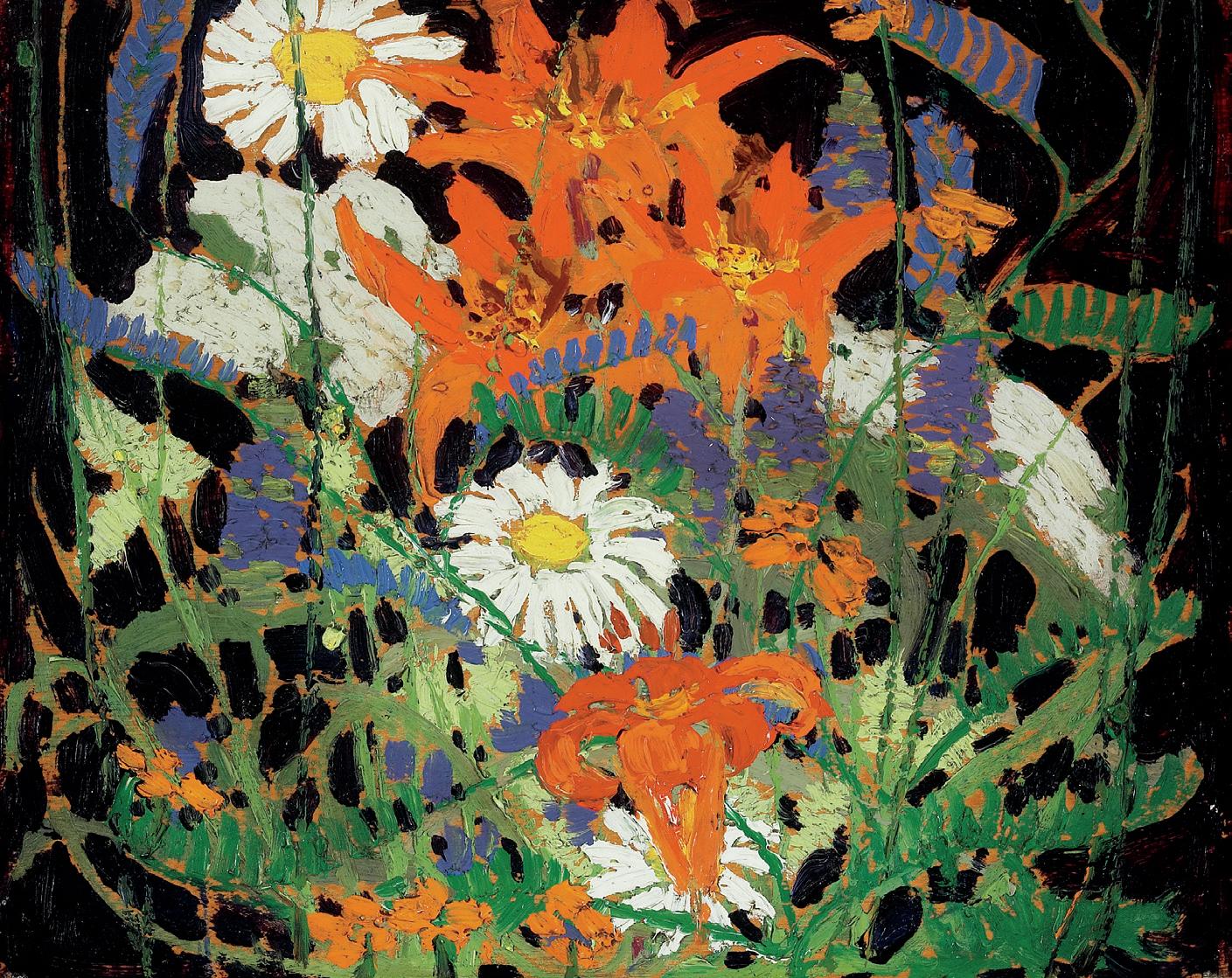
8 7/16 × 10 9/16 in, 21.4 × 26.8 cm
Collection of the Art Gallery of Ontario, 2563
Gift from the Albert H. Robson Memorial Subscription Fund, 1941
Photo: AGO
oPP osi TE Pag E : t om t homson Sketch for “The West Wind” oil on panel, 1916
8 7/16 × 10 9/16 in, 21.4 × 26.8 cm
Collection of the Art Gallery of Ontario, L69.49
Gift from the J.S. McLean Collection, Toronto, 1969, Donated by the Ontario Heritage Foundation, 1988
Photo: AGO
tenderness, its arresting glamour, is a metaphor for life on earth, triggering a visual experience transposed to the cerebral memory forever. Thomson managed to achieve a more than successful result in this painting of wildflowers. The flowers have an almost vibratory effect, which he achieved by employing bright colour— pink, yellows and orange among whites, while he rendered the leaves with longer brush-strokes. The painting, a really convinc ing picture of flowers, would have given him hope for the future, a future which included his rewriting the genre of landscape painting up to that time with works such as The Jack Pine, among other great examples of his art. The painting Moccasin Flower is an ode to Algonquin Park and the inspiration he found in the sanctity of the north. As Harold Town once wrote, flowers “visit the sick room of the painter’s frustration and cheer him up.”
Moccasin Flower is an icon of Canadian art, a national treasure.
We thank Joan Murray, author of the Tom Thomson catalogue raisonné and former chief curator at the Art Gallery of Ontario, for contributing the above essay.
This work is included in the Tom Thomson catalogue raisonné, researched and written by Joan Murray, as # 1916.68 and can be viewed at https://www.tomthomsoncatalogue.org/catalogue/ entry.php?id=510.
T OM T HOMSON ’ S f RIEN d A.Y. Jackson once described Algon quin Provincial Park as a place “hacked up . fire-swept, dammed by both man and beaver, and overrun with wolves.” 1 This rugged ness was a large part of the appeal for Thomson and Jackson, and
many of their works exploited the harsh allure of wind-wrought pines, frigid lakes and baleful skies. Yet the northern landscape was also, as Jackson noted, a place of gentler motifs of rare and elegant beauty—such as Thomson shows in this gorgeous paint ing of wildflowers on the forest floor.
Spring was one of Thomson’s favourite seasons in which to paint. When he arrived in Algonquin in March 1916, snow still lay on the ground, as revealed by more than a dozen works he painted over the space of the following weeks. Then, as the snow and ice retreated, the spring ephemerals emerged—woodland flowers that pushed through the soil and bloomed in the short space of time between the spring melt and the summer leaf-out. Thomson had painted flowers at least once before. In the summer of 1915, attracted by the bright bursts of colour and the sinuous lines of stems and leaves, he created a series of small panels of summer flowers, such as Marguerites, Wood Lilies and Vetch (col lection of the Art Gallery of Ontario). In this 1916 painting he concentrated instead on delicate, early spring plants such as the trout lily and the moccasin flower, which stop photosynthesizing and disappear from the forest floor when summer arrives and the tree canopy blocks out the sunlight.
The trout lily with its nodding head of yellow flowers, along with the pentagonal white blooms of hedge bindweed, was a common enough sight in Algonquin Provincial Park. However, the moccasin flower, or lady’s slipper, was much less so. The moc casin flower is an orchid, a member of what a nineteenth-century American botanist called the “high-bred race, fastidious in hab its, sensitive as to abodes.” 2 Moccasin flowers grow only under certain special conditions: as Catharine Parr Traill noted in Cana dian Wild Flowers, first published in 1868, they were found in the
damp soil on the edges of forest streams and in boggy ground such as tamarack swamps. Moccasin flowers were a rare sight even in the 1860s, and Traill lamented that a time would come when “these rare productions of our soil will disappear from among us.” 3 In fact, by the turn of the twentieth century, conser vation efforts were needed to stop gardeners and plant-hunters from uprooting them, and therefore, because they rarely survived transplanting, driving them to extinction.
The rare and endangered status of the moccasin flower gave it special connotations, and it became a metaphor for any thing native, wild and scarce that was threatened by intruders. Throughout the nineteenth century, the plight of the moccasin flower was compared by poets and conservationists to that of Native Americans, who, as Traill noted as early as the 1850s, were “dying out fast thanks to the white man.” 4 Or as Susan Fennimore Cooper wrote around the same time, a “bold and hardy race” of foreign invaders was “driving away the prettier natives”—both moccasin flowers and the aboriginal inhabitants of the Americas. The “vanishing orchid” motif went side-by-side with the “vanishing Indian” theme so prevalent in Canadian and American writing.5
How much Thomson knew of these connotations is an open question. On one level he was no doubt simply drawn to this rare specimen, a pink-tinged orchid with its shoe-shaped pouch and large, creased leaves. As both a nature lover and trained designer he had a brilliant eye for patterns in nature—what Arthur Lismer (who on several occasions painted with him in Algonquin Provin cial Park) called an “uncanny sensitivity” for “simple sights.” 6 The moccasin flower with its distinctive shape and colour would have made an arresting sight. But Thomson was a visual poet,
acutely attentive to the emotions invoked by a landscape, as a work he created that same spring—the sketch for The West Wind, done during a sudden storm—amply demonstrates. In the spring of 1916, with the war raging in Europe and friends like Jackson at the front, Thomson must have been struck by the poignancy of such fragile and vulnerable beauty surviving for a brief time in the midst of the ruggedness of the boreal forest.
We thank Ross King, author of Defiant Spirits: The Modernist Revolution of the Group of Seven, for contributing the above essay.
1. A.Y. Jackson, foreword, Catalogue of an Exhibition of Paintings by the Late Tom Thomson (Montreal: The Arts Club, 1919).
2. A.B. Hervey, Beautiful Wild Flowers of America (Boston, 1882), 101.
3. Catharine Parr Traill and Agnes FitzGibbon, illus., Canadian Wild Flowers, 4th ed. (Montreal, 1895; first published 1868), 61. Con servation efforts are described in Richard Primack, “Science and Serendipity: The Pink Lady’s Slipper Project,” Arnoldia, Spring 1996, 9–14.
4. Catharine Parr Traill, The Canadian Settler’s Guide, 7th ed. (Toronto: Office of the Toronto Times, 1857), 217.
5. For an exploration of these issues, see Kyhl D. Lyndgaard, “Pro logue: Taking Off the Moccasin Flower and Putting on the Lady’s Slipper,” in Captivity Literature and the Environment: Nineteenth-cen tury American Cross-cultural Collaborations (Abingdon: Routledge, 2017), 1–11; Cooper quoted on p. 4.
6. Arthur Lismer, “Tom Thomson (1877 – 1917), Canadian Painter,” Educational Record of the Province of Quebec 80 (1954): 171.
e stimate: $ 1,000,000 – 1,500,000
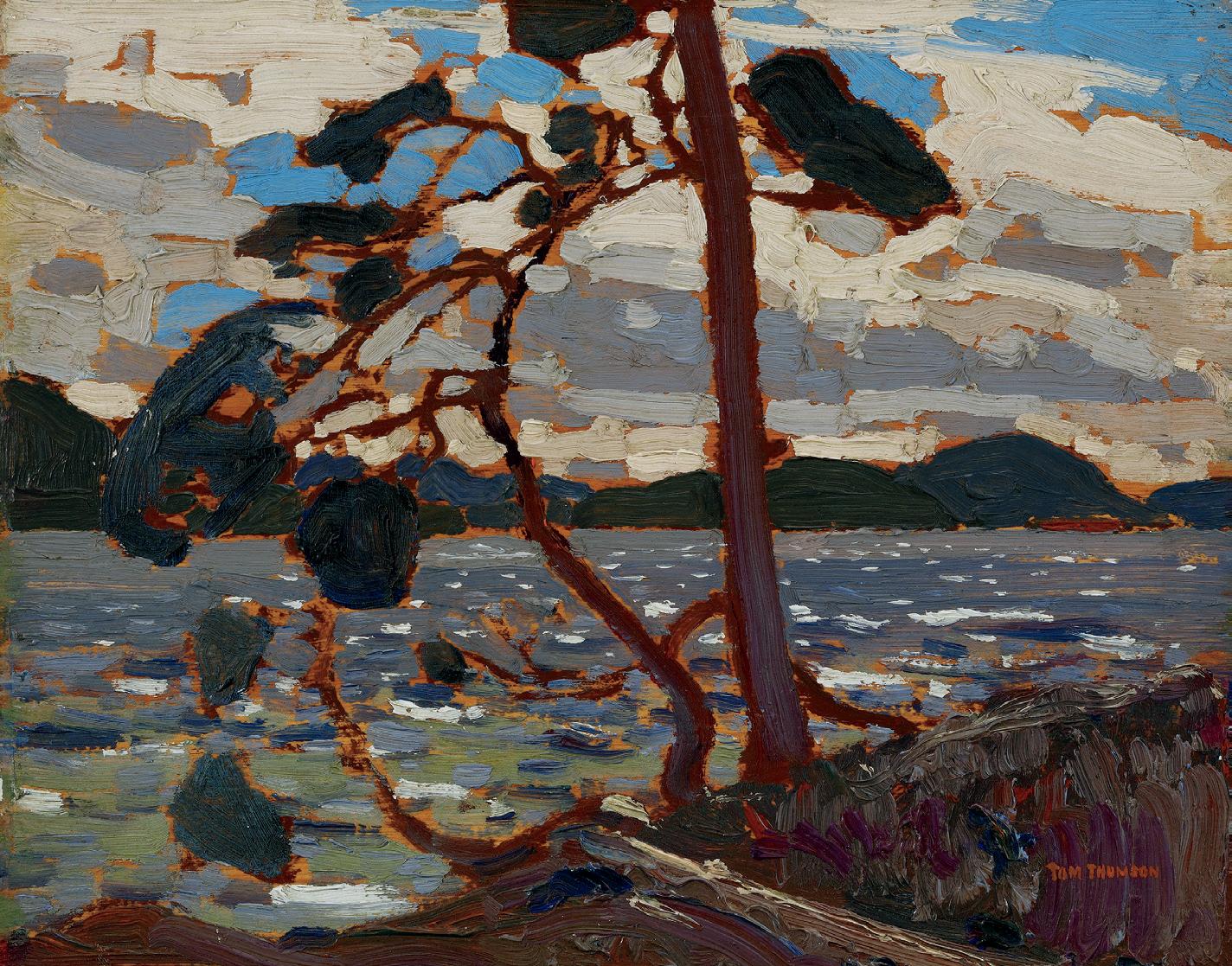
Autumn in the Don Valley oil on board, signed and on verso signed, titled and inscribed 3641 Yonge St and $ 75 , circa 1925 11 7/8 × 16 in, 30.2 × 40.6 cm
p rovenan C e Canadian Art, Joyner Fine Art, May 16, 1989, lot 100 G Private Collection, Ontario
fRE d ERICK VAR l E y SPENT seven years after the First World War working in Toronto (with the exception of a summer in Bob caygeon in the summer of 1923), mostly painting portraits, but also landscapes. He participated in Group of Seven exhibitions and taught at the Ontario College of Art, where he was appointed
a full-time teacher in fall of 1925. The Don Valley was a natural park area within easy reach of Toronto, and Varley painted a num ber of works there, such as this oil with its striking moody sky. Pale cumulus formations billow on the horizon, while dark grey storm clouds loom overhead, interspersed with glimpses of tur quoise and blue sky. Varley expertly handles the weather effects, such as the descent of a rain shower, and his colour palette is rich and varied. His brushwork is fluid and assured—broad strokes give the impression of flowing water, and Varley varies his paintstrokes to delineate vegetation and the rhythmic direction of the rolling land. Autumn in the Don Valley is a fine Group of Seven period work; through its open vista, the eye flows freely to the iconic solitary tree and up into the exciting, turbulent sky.
e stimate: $ 25,000 – 35,000

Quiet Sundown, Halfway Lake oil on board, signed and on verso signed, titled and inscribed with stock #3795 on the Roberts Gallery label, circa 1958 12 × 15 in, 30.5 × 38.1 cm
p rovenan C e
Roberts Gallery, Toronto Private Collection, Ontario
H A lf WAy lAKE , IN Sudbury District in northeastern Ontario, was so named because, in the early 1900s, there was a logging camp on its shore, located halfway between the main logging area and the railway line where timber was loaded for trans port. The foreground terrain with the stumps left a clear path for
A.J. Casson to approach the lake to paint the stunning vista. Casson’s fine sense of composition, honed by many years with the Group of Seven and a long career in commercial art design with Sampson Matthews Limited, is fully manifested here. A golden sunset light rakes across the scene from the left, touch ing trees and the hillside. Casson’s depiction of the lake surface shows his expert handling of effects—one section is opaque, as if ruffled by a breeze, another is still, showing the reflection of the stylized trees. The elements of this landscape have a fine sense of balance: the powerful shape of the central hill looms, while in the distance, triangular misty hills are contrasted by drifting cirrus cloud formations. This is an outstanding mid-career work, likely from about 1958, when Casson retired from Sampson Matthews to devote himself full time to his painting.
e stimate: $ 30,000 – 40,000


oil on canvas, signed with the estate stamp and on verso signed twice with the estate stamp on the tacking edge, titled and inscribed with the Inventory #B 150 on the Dominion Gallery label and inscribed variously, circa 1931 16 × 20 1/4 in, 40.6 × 51.4 cm
Dominion Gallery, Montreal Kastel Gallery Inc., Montreal
Fine Canadian Art, Heffel Fine Art Auction House, November 24, 2005, lot 193
Private Collection, USA
Fine Canadian Art, Heffel Fine Art Auction House, May 15, 2013, lot 163
Private Collection, Toronto
Doris Shadbolt, Emily Carr, 1990, pages 163 and 167, the related 1930 charcoal drawing Untitled (landscape with “eye” in sky), collection of the Vancouver Art Gallery, reproduced page 165

E MI ly C ARR’ S SMA ll sketchbook drawings of 1929 and 1930 formed the basis for a group of contemporaneous larger drawings that consolidated her ideas for canvases, such as the carefully worked charcoal precursor to this work, Untitled (landscape with “eye” in sky), dated 1930. Of these larger studio drawings, Doris Shadbolt wrote, “Whether her excited discovery of nature’s rich revelation of form possibilities simply impelled her into such fully developed statements or whether she needed to consolidate her ideas before taking them into her painting, they give us a reveal ing glimpse into her working method and her creative process.”
Carr made three last excursions to Indigenous areas on the outer coast of northwestern Vancouver Island: Nootka, Friendly Cove and Port Renfrew in 1929, and Quatsino Sound in 1930. At this time, she was alternating between images of landscape and Indigenous imagery. Doris Shadbolt noted that during this period, Carr “was still under the spell of the Indian presence and in several of these drawings she expressed the underlying correspondence that she had discovered between the natural environment and the Indian carvings in which eyes, or eyelike shapes, appear between totemlike sections of foliage.” The fas cinating drawing Untitled (landscape with “eye” in sky) is evidence of Carr’s thoughtful consideration of her image. The imagina tive inclusion of an abstracted eye motif, which looms out of the stormy sky over the landscape, shows that she was still “under the spell of” First Nations imagery. It implies the Indigenous view of the forces present in nature that they distilled in their totems, in the stylized eye of a thunderbird or raven.
In the dramatic Storm Over Grey Forest, we can see the evo lution of this painting from the drawing. The storm, implied in the drawing, has broken over the land, descending like a water fall. Where there was an eye in the drawing, there is now an abstracted aperture of light piercing through the tempest. The compression of the storm is made visible, the wind whipping the branches into wavelike formations, pushing them up at their tips. Light bursts out between sky and forest from the aperture, creating the sense of awe that one feels in the presence of such electrifying weather. Emerging from this wild motion are several cross-like trees, which act as vertical anchors. Slivers of bare can vas and white paint-strokes amongst the dark trees also let light into the density of the forest, as do mauve, brown and pink tones.
Much of Carr’s work in the 1930s was done using thinned oil paint on paper, which allowed a tremendous freedom of move ment. Storm Over Grey Forest embodies that freedom in a rare and thrilling oil on canvas, in which her expressionistic brush-strokes captured the essence of the intangible—the storm’s energy, the vapour-laden air, and the sensation of intensity in the forest.
e stimate: $ 250,000 – 350,000

The Oyster Beds: Cancale oil on canvas, signed and on verso titled on the Watson Art Galleries label and certified by Watson Art Galleries
13 3/4 × 18 1/4 in, 34.9 × 46.4 cm
Private Collection, Vichy, France
Jacques Dubourg, Paris
Watson Art Galleries, Montreal, 1936
Private Collection, Ottawa, 1947
Private Collection, California
Important Canadian Art, Sotheby’s Canada in association with Ritchie’s, May 25, 2009, lot 20
Private Collection, Toronto
Donald W. Buchanan, James Wilson Morrice, 1936, listed with description page 159
Lucie Dorais, “James Wilson Morrice: Les années de formation,” MA thesis, University of Montreal, 1980, reproduced figure 90, titled as Les parcs à huîtres, to illustrate the section on Cancale, 1896
Charles C. Hill, Morrice, A Gift to the Nation: The G. Blair Laing Collection, National Gallery of Canada, 1992, page 41, the circa 1896 oil on canvas entitled La Bretonne, collection of the National Gallery of Canada, reproduced page 43, figure 5a
J AMES W I l SON M ORRICE first visited the fishing port of Can cale in Brittany around 1892 to 1893, and the painting Rocher de Cancale, with oyster beds in the foreground, dates from that trip. In 1896, Morrice returned to Cancale, as documented in letters to his American friend Robert Henri, who was at Moret-sur-Lo ing with his students. Morrice had planned to spend the whole summer in Saint-Malo but soon left for Cancale, which was only 15 kilometres away. Charles Hill wrote that “Morrice found the town, its harbour, and its inhabitants so attractive that he stayed for over a month.” From June 6 to July 9, he painted the oyster beds, beach scenes and boats in the harbour.
There are abundant drawings in Morrice’s Sketchbook #2 , in the collection of the Montreal Museum of Fine Arts, and together with sketches and small canvases, these prove that he was very productive in Cancale during the 1896 trip. Among the works he painted is the very similar painting Breton Women Walking Among Oyster Beds, Cancale, in the Thomson Collection at the Art Gallery of Ontario. Morrice had a romantic vision of the past in the French countryside, in which people subsisted in traditional ways—like gathering oysters. Cancale was well known for its native oysters with flat shells, called the Belon. Men went to sea to collect oysters from their fishing grounds, then dropped them in their personal “beds” at high tide, while women and children waited for low tide to sort them.
In The Oyster Beds: Cancale, Morrice’s colour palette has a har monious resonance. The sandy ground is a kind of putty colour,
very soft and sensual, with highlights of blue, cream and pink. The painting has an even light and close, light tonal values. The water in the oyster beds reflects the pale blue sky and the sticks or weirs that define the edges of the beds. The two young oyster gatherers in the foreground are dressed in traditional clothing, the boy with his beret and scarf, the girl with her bonnet—tra ditional dress for the area around Cancale. The girl is similar in dress and hairstyle to the girl wearing a pink dress and white bon net featured in front of oyster beds and weirs in La Bretonne, a circa 1896 Morrice canvas in the collection of the National Gallery of Canada.
The deserted, beached boat in the distance gives a poignant feeling to the scene; it also draws our attention to the horizon line of pale blue ocean and an intriguing pale, yellowish sky that brings light into the scene and harmonizes with the tone of the sandy ground. Morrice’s brushwork could be described as luscious in its sensuality.
Morrice returned to Paris in early August, possibly through Saint-Malo. The body of work that he created during this short time in Cancale stands as unique and marvellously atmospheric. The Oyster Beds: Cancale is an outstanding work from this part of his oeuvre.

We thank Lucie Dorais for her assistance with the cataloguing of this painting. This work will be included in Dorais’s forthcom ing catalogue raisonné of the artist’s work.
e stimate: $ 80,000 – 120,000
Entrance, Coldwell Bay, Lake Superior oil on board, signed and on verso signed, titled and titled on the Dominion Gallery label, inscribed Hogarth with the Doris Mills Inventory #4/129 and variously and with the artist’s hand-drawn pencil map and stamped with the Dominion Gallery stamp, circa 1922 – 1923 10 1/2 × 13 3/4 in, 26.7 × 34.9 cm p rovenan C e
Dominion Gallery, Montreal
Private Collection, Ontario
By descent to the present Private Collection, Ontario l iterature
Doris Mills, L.S. Harris Inventory, 1936, Lake Superior Sketches, Group 4, catalogue #129, location noted as the Studio Building
T HE STARK AN d dramatic edges of Lake Superior’s North Shore were areas of abundance for Lawren Harris, filled with opportunities for new and exciting depictions of the Canadian landscape. Entrance, Coldwell Bay, Lake Superior, an oil from one of the artist’s early visits to the lake, is a superb example of the energizing potential that Harris found here. The work radiates inspiration, and its assured, bold forms and strong chromatic contrasts remain striking and fresh a century after its creation. It is evidence of the rich rewards that were to be discovered by the intrepid artist amongst the many challenges of Lake Superior’s austere and wild topography, and carries with it the important legacy of the Group of Seven’s reimagining of landscape art in this country.
Painted in either 1922 or 1923, this painting is filled with the same vibrancy of colour that so effectively animated Harris’s Algoma works just a few short years before. Here, the golden cadmium yellows and brilliant crimson of the deciduous fall foli age are arresting in their intensity, a crystalline depiction of this annual display of northern beauty. Yet, despite the connection to earlier wood interiors, there is a novelty found as well, a grand ness that characterizes Harris’s experience on the North Shore. An epic sense of space is emphasized by a haze that is found in the distance—an atmospheric phenomenon common in his works from this time, and used to great effect to highlight the vibrancy of the foreground and the striking contrast with the electric-blue water and the muted violet greys of the far shore’s rocky cliffs.
As Harris emerged from the density of the Eden-like para dise that was Algoma, the expansiveness of the inland sea had
a profound effect on his work, and trips to Lake Superior in the early 1920s marked a critical turning point in his artistic journey. Before he found his way to the Rocky Mountains, and eventually to the realms of abstraction, the austerity and vastness of Lake Superior presented an opportunity for transition, a shifting of attention away from the corporeal interests of the tangible world to the ethereal spaces that resonated with a greater spiritual sig nificance. The composition of this work symbolically captures this shift, with the foreground crisp and clear, and the far shores across Coldwell Bay appearing eerie and seemingly from another realm. Several years later, Harris would paint a similar compo sition from the same vantage point (North Shore, Lake Superior, in the McMichael Canadian Art Collection), which continues along this trajectory. In the later picture the foreground has been reduced to a mere platform to position the viewer, and attention is solely focused in the distance. In light of this, the confident experimentation in Entrance, Coldwell Bay, Lake Superior can be viewed as a marker on the artist’s journey, a waypoint that allows one to follow the path of his evolution.
Poetically, the verso of this work also contains its own sig nificance for Harris’s explorations. Underneath the various inscriptions and gallery labels there is a pencil-drawn map of the North Shore in Harris’s own hand, delineating the various bays, lakes and hilltops that were the sketching grounds between Marathon and Coldwell. The railway, and presumably the stop at Mile 69, is indicated, giving rare insight into the logistics and experiences that Harris and his fellow artists (in this case, he was accompanied by A.Y. Jackson) had a century ago, exploring these spectacular landscapes. This work was completed a little to the east of the region depicted in the hand-drawn map, looking west along the shore towards the hills from which he would later paint views of Pic Island, in present-day Neys Provincial Park.
The “Hogarth” inscription on the verso, also in Harris’s hand, likely refers to Donald M. Hogarth, a mining financier and mem ber of the Legislative Assembly of Ontario, who represented the North Shore’s Port Arthur constituency at the time this work was painted and was a contemporary of Harris’s. The two men likely knew each other, for Hogarth had a summer home on Lake Sim coe’s Kempenfelt Bay, near the Harris family’s own Woodend estate. As a brilliant and powerful representation of a region that both men had significant and deep connections to, this work was likely set aside by Harris for Hogarth’s consideration.
We thank Alec Blair, Director/Lead Researcher, Lawren S. Harris Inventory Project, for contributing the above essay.
e stimate: $ 150,000 – 250,000


Nude on a Couch oil on canvas on artist board, signed and with the artist’s thumbprint and on verso titled on several museum exhibition labels and dated 1940 on a label and with the Varley Inventory #100
18 × 14 in, 45.7 × 35.6 cm
Laing Galleries, Toronto
Acquired from the above by Charles S. Band, Toronto, 1957 Estate of Helen E. Band, Toronto
Fine Canadian Art, Heffel Fine Art Auction House, November 26, 2009, lot 235
Private Collection, Toronto
l iterature
The Collection of Mr. and Mrs. Charles S. Band: Contemporary Canadian Painting and Drawing, Albright Art Gallery, 1958, listed page 9
The Collection of Mr. and Mrs. Charles S. Band, Art Gallery of Toronto, 1963, listed page 21
Christopher Varley, F.H. Varley, Canadian Artists Series, National Gallery of Canada, 1979, reproduced page 27
Christopher Varley, F.H. Varley: A Centennial Exhibition, Edmonton Art Gallery, 1981, page 148, reproduced page 149
Peter Varley, Frederick H. Varley, 1983, essay by Joyce Zemans, page 72, reproduced page 162
e xhibited
Art Gallery of Hamilton, The C.S. Band Collection, November 5 – 30, 1954, titled as Slumber, catalogue #42
Albright Art Gallery, Buffalo, The Collection of Mr. and Mrs. Charles S. Band: Contemporary Canadian Painting and Drawing, October 1 – November 2, 1958, catalogue #32
Canadian National Exhibition, Toronto, Private Collectors’ Choice in Canadian Art, September 1959
Vancouver Art Gallery, Paintings and Drawings from the Collection of Mr. and Mrs. Charles S. Band, March 1 – 21, 1960, catalogue #32
Willistead Art Gallery, Windsor, Canadian Paintings and Drawings from the C.S. Band Collection, April 29 – May 29, 1961, catalogue #22
Rodman Hall Arts Centre, St. Catharines, F.H. Varley: Paintings and Drawings from the C.S. Band Collection, November 1962
Art Gallery of Toronto, The Collection of Mr. and Mrs. Charles S. Band, February 15 – March 24, 1963, traveling to the Montreal Museum of Fine Arts, May 23 – September 1, 1963, catalogue #41
Art Gallery of Ontario, Toronto, F.H. Varley: A Centennial Exhibi tion, September 17 – November 13, 1982, traveling exhibition, this work only shown at the Art Gallery of Ontario location
McMichael Canadian Art Collection, Kleinburg, The Group of Seven: Masterpieces from Toronto Collections, May 24 –August 23, 1987
Nude o N a C ou C h is not Varley’s only nude, but it is, arguably, his greatest, and one of the most evocative and enigmatic paint ings of his career. Long a part of one of the most distinguished collections of Canadian art formed in the first half of the twen tieth century, the painting is a remarkable tour de force of the painter’s art. The work is at once profoundly sensual, and yet, as art historian Joyce Zemans has noted, “there is something jarring about it.” Christopher Varley, in his centenary exhibition cata logue, links this work to the powerful nudes of the great Austrian Expressionist Egon Schiele and notes the “warm colour on the model’s nipple and knee,” which “reminds us of the Viennese painter’s mottled flesh tones.” While such connections are sug gestive, Nude on a Couch is, however, Varley’s own image, and an important landmark within his development as an artist.
It is, nevertheless, easy to see why the work has produced a sense of disquiet amongst viewers. The work is a series of con trasts—the extreme openness and vulnerability of the pose is countermanded by the fact that much of her “angelic” face is covered. She is at once available and removed. The softness of her body and the sinuous flow of the lines that delineate her body are markedly different from, as Zemans describes, the “roughly textured, cool-coloured drapery on which she lies.” Indeed, the treatment of the drapery might almost be described as brutal, and belies the tenderness and vulnerability of her pose. So, too, is the distant landscape slightly unnerving. We find ourselves ask ing why this woman would be naked and alone in this glowering landscape. There are no immediate answers, and this ambiguity is part of what makes the work so memorable.
One of the most striking aspects of Nude on a Couch is the dramatic composition. The figure is abruptly cropped and the space of the painting is unclear—we seem to be viewing her from slightly above, yet she is clearly not at our feet—and there is lit tle evidence of a couch (the curved element at the lower left is, one presumes, the arm of the couch). Varley seems to have con sciously avoided the easy and conventionally pretty in favour of a difficult but more powerful beauty. Such decisions are what give the painting such visual force. Christopher Varley was surely right when he called this one of Varley’s “most inventive and powerful compositions.”
How then are we to read this work? The work shares some of the sexual abandon seen in the drawing Nude Standing, 1933 –1935 (collection of the National Gallery of Canada) but has none of the coyness of that figure. Instead we see an image which seems almost achingly tender. One cannot know the answers, and every viewer must complete their own narrative when con sidering this subtle and complex image. While one may be left wondering as to the precise meaning of the work and the identity of the model, one cannot forget the uncanny power and beauty of this singularly compelling work.
This work is #100 in the Varley Inventory listing.
e stimate: $ 500,000 – 700,000
From J.W. Morrice's studio, Guaranteed by W. Scott & Sons / signed by the artist and variously, circa 1892
15 1/4 × 12 in, 38.7 × 30.5 cm
William Scott & Sons, Montreal, 1929
William Scott & Sons, Montreal, 1939
Roberts Gallery, Toronto, between 1949 and 1961
Important Sale by Auction, Waddington, McLean & Co., Toronto, November 28, 1987, lot 845
Private Collection, Ontario
By descent to the present Private Estate, Ontario
Robert Ayre, “J.W. Morrice Pictures as Scott’s ‘One of [the] Greatest of Our Painters,’ ” The Standard (Montreal), January 28, 1939, page 21
St. George Burgoyne, “Phases of Art of J.W. Morrice on View at Scott’s Galleries,” The Gazette (Montreal), January 28, 1939, page 5
Nicole Cloutier, James Wilson Morrice, 1865 – 1924 , Montreal Museum of Fine Arts, 1985, page 75, the 1911 canvas entitled Le verger, Le Pouldu, in the collection of the Montreal Museum of Fine Arts, reproduced page 204
A.K. Prakash, Impressionism in Canada: A Journey of Rediscovery, 2015, page 333
e xhibited
William Scott & Sons, Montreal, Paintings by J.W. Morrice, January 24 – February 10, 1939
J.W. Morrice painted an amorous world guided by the furious melancholy of his own soul, a world in which sensuality was the whole of life. The only serious business was observation. Serene and tranquil, his art lay in the studied silence with which he removed all artificial barriers to what he saw. His art is a visual synthesis which arouses that rare state of satis faction known as the aesthetic emotion—an art unto itself.
A . K . PRAKASHJ AMES W I l SON M ORRICE spent most of his life in France, first arriving there about 1890. He became one of the most prominent Impressionists in Europe and Canada, and his contemporaries considered him one of the best landscape painters of the age. His
observations of nature and of light were brilliant. He lived in Paris but often traveled to small towns and rural areas in France, such as Brittany and Normandy.
As he explored the countryside, he found a cultivated land scape, including orchards, and painted them in spring and summer around Saint-Malo (most of these views have sea back drops) and Le Pouldu, in Brittany, and in Normandy. He must have found them a picturesque subject, whether laden with fruit or blossoming in spring, as in The Orchard, and he kept his compositions entirely natural, without buildings or the presence of people. As Nicole Cloutier wrote, “Morrice . . . sometimes employed rich vegetation in a similar manner to architecture, allowing it to dominate the entire composition.” In 1911, he painted the large canvas Le verger, Le Pouldu (collection of the Montreal Museum of Fine Arts), which has a similar landscape setting. However, in Lucie Dorais’s judgment, our painting was most likely executed in Normandy, which was known for its apple orchards—Morrice traveled there often, as it was close to Paris.
This canvas would have been preceded by a pochade, a small oil on panel (slightly larger than a medium-size envelope) painted on the spot, to faithfully capture the details and atmosphere of the scene. Morrice’s sensitivity to light in The Orchard is excep tional. Sun breaks through an aperture in dark storm clouds on the left, flooding the field behind the fruit trees. This use of backlighting is a striking device, emphasizing the depth of the picture plane. It also serves to push the row of trees forward and make them more prominent. Their blossoming feels lively, an impression created by whirling daubs of pink and white pigment. The upturned branches in the central trees reinforce this vivacity. Small strokes of white-based paint in the grass and earth in the foreground echo the blossoms. Morrice’s brushwork is fluid and animated, creating the impression of a fresh and exciting day of changeable weather—a satisfying experience of “aesthetic emotion” in the peaceful French countryside.
This painting was exhibited by William Scott & Sons in Montreal in 1939, and art critics of the time included it in their reviews. Robert Ayre, writing in the Standard, commented, “There are early works like The Orchard, saturated with atmo sphere.” St. George Burgoyne wrote in the Gazette of “a more sombre note” being sounded “in ‘The Orchard,’ with an expanse of gashed, grey sky and the fruit trees in blossom—a study in low tones capitally managed.”
We thank Lucie Dorais for her assistance with the cataloguing of this painting. This work will be included in Dorais’s forthcom ing catalogue raisonné of the artist’s work.
e stimate: $ 40,000 – 60,000
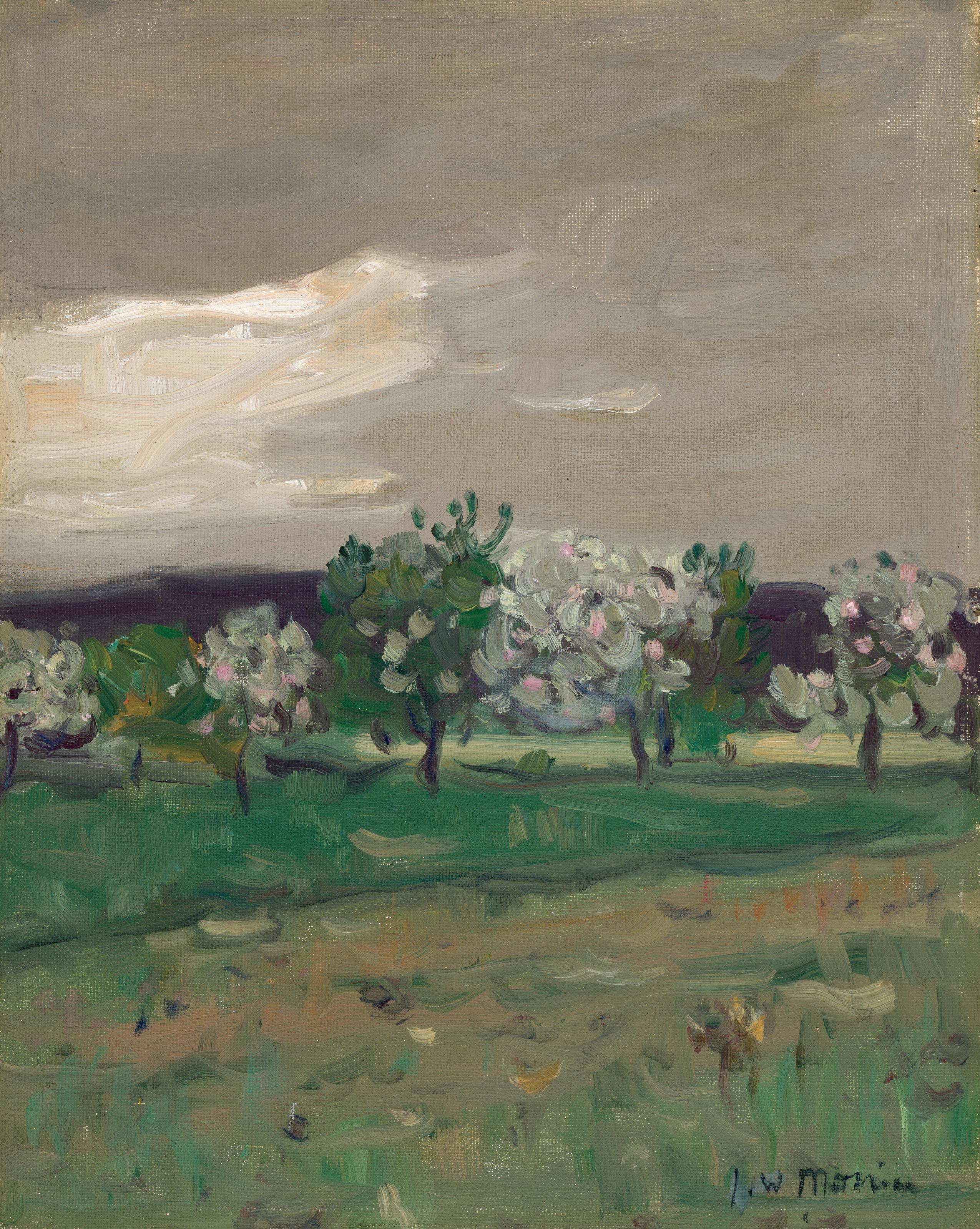
1898
1967
Quebec from Pointe Levis, PQ oil on canvas, signed and on verso signed, titled and titled View of Quebec from Pointe Levis, Que. on the gallery labels and dated 1960 – 1966 24 × 32 in, 61 × 81.3 cm
rovenan C
Galerie Walter Klinkhoff Inc., Montreal Kastel Gallery Inc., Montreal Private Collection, Ontario
A.K. Prakash, Impressionism in Canada: A Journey of Rediscovery, 2015, page 632
T HIS SCENE O f Quebec City from Pointe Lévis is absolutely iconic for Robert Pilot, from the depiction of historic buildings
to the ferries steaming across the St. Lawrence River. This view from high on a hill, cloaked in a layer of snow, is exquisitely beau tiful. Pilot had ample opportunity to showcase his Impressionist skills, absorbed decades before at the Académie Julian in Paris and from his stepfather, the Canadian Impressionist Maurice Cullen. Delicate atmospheric effects are everywhere, from the sensitively modulated clouds to the plumes of steam and smoke rising from the ships and from buildings on the far shore. Pilot picks up the light reflecting off ice pans in the river, the snow covering the hillsides and the delicate tracery of branches in the foreground trees to illuminate the scene.

Later in his life, Pilot would rework sketches from his early years, as he said, “to capture the essential poetry of the scene[s] I had worked on in my youth.” The urban life of Old Quebec was of paramount interest to him, and he particularly favoured the bluish hue of twilight. Quebec from Pointe Levis, PQ is an acutely nostalgic scene that captures the charming allure of Old Quebec.
e stimate: $ 40,000 – 60,000
Petite Rivière, Que. oil on board, signed and on verso signed, titled and dated circa 1925 on the gallery label 8 1/2 × 10 1/2 in, 21.6 × 26.7 cm
Galerie Walter Klinkhoff Inc., Montreal Fine Canadian Art, Joyner / Waddington’s, May 30, 2006, lot 65 Private Collection, Vancouver
A.y. J ACKSON ’ S EAR ly exposure to French Impressionism in France in 1907 and his absorption of its tenets can be sensed in his gorgeous sky in Petite Rivière, Que. Upward brush-strokes lay down layers of hues from turquoise to deeper blue and create a radiant, vibrating atmosphere. In this still scene, anchored by the
stationary boats, Jackson created movement through the diagonal of the shore, the soft flow of the river and the shimmering sky.
Almost every year during the 1920s, Jackson made sketching trips in late winter and early spring to the north and south shores of the St. Lawrence River. Jackson’s paintings of this area forged his legacy, and his affection for this rural area that he knew so well was palpable. Here the sun has melted the snow, which lin gers in patches on the shore and hills across the river, revealing the warm brown of bare earth. Slivers of exposed board add to this impression of warmth, as do spots in the sky, and emphasize the ridges of textural brushwork. The river, broken free of win ter ice, is a striking milky green, purple and blue. This tranquil, appealing painting is an outstanding Group of Seven period work.
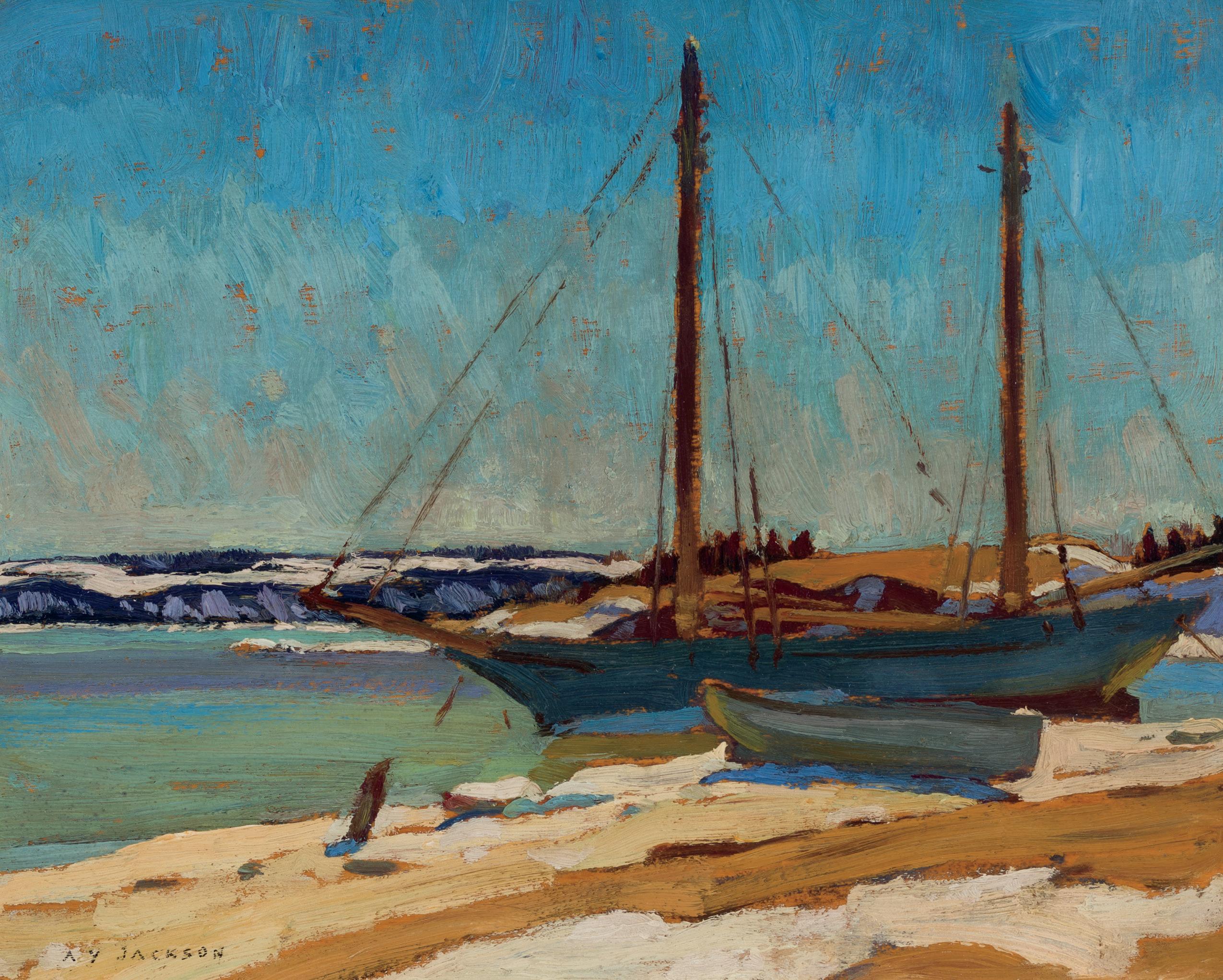
There is an unfinished sketch on verso.
$ 25,000 –
Misty Morning, Cloche Mountains oil on board, signed and dated 1936 and on verso titled and dated on the gallery labels and inscribed variously 10 × 11 7/8 in, 25.4 × 30.2 cm
p rovenan C e
Roberts Gallery, Toronto
The Art Emporium, Vancouver Kaspar Gallery, Toronto Fine Canadian Art, Joyner Fine Art, May 16, 1989, lot 74

Private Collection, Toronto
A RTISTS IN THE Group of Seven each had their special painting places, and for Franklin Carmichael, that place was the La Cloche Mountains. His unique bond with this singular and beautiful landscape endured from the early 1920s until the time of his passing, in 1945. This region had expanses of water and broad
valleys, and its white quartzite rock formations were geologically special. In order to immerse himself in this stunning landscape, Carmichael acquired five acres of land on Cranberry Lake and built a cabin there in 1935.
In Misty Morning, Cloche Mountains, Carmichael took a posi tion on the near shore, painting the mist drifting down over the mountaintops from the bottom of a formation of upward-reach ing striations of cloud. His fine eye for composition, honed over many years of plein air sketching and working as a top designer for the commercial art firm Sampson-Matthews Ltd., picked out the rhythm in the undulating hills, the patterns in the moun tains shaped by snowmelt, and the focal points in the layers of landscape. Carmichael was a sensitive man, given to reading extensively about American Transcendentalism, theosophy and cosmology earlier in his life. In the La Cloche area, in solitary and contemplative landscapes such as this, Carmichael found the experience of spiritual communion that he sought.
stimate: $ 70,000 – 90,000
verso
by Ralph Waldo Emerson (Essays and Other Writings), William Kingsland (Our Infinite Life) and Edwin Carpenter (The Art of Cre ation: Essays on the Self and Its Powers). As Catharine Mastin wrote, “Carmichael’s own fascination with the microcosm of nature finds its Emersonian equivalent in painted versions of trees, skies, rock walls, forest floors, and valleys throughout his career, but espe cially up to the mid-1920s.”
M. Mastin, Portrait of a Spiritualist: Franklin
and the National Gallery of Canada Collection
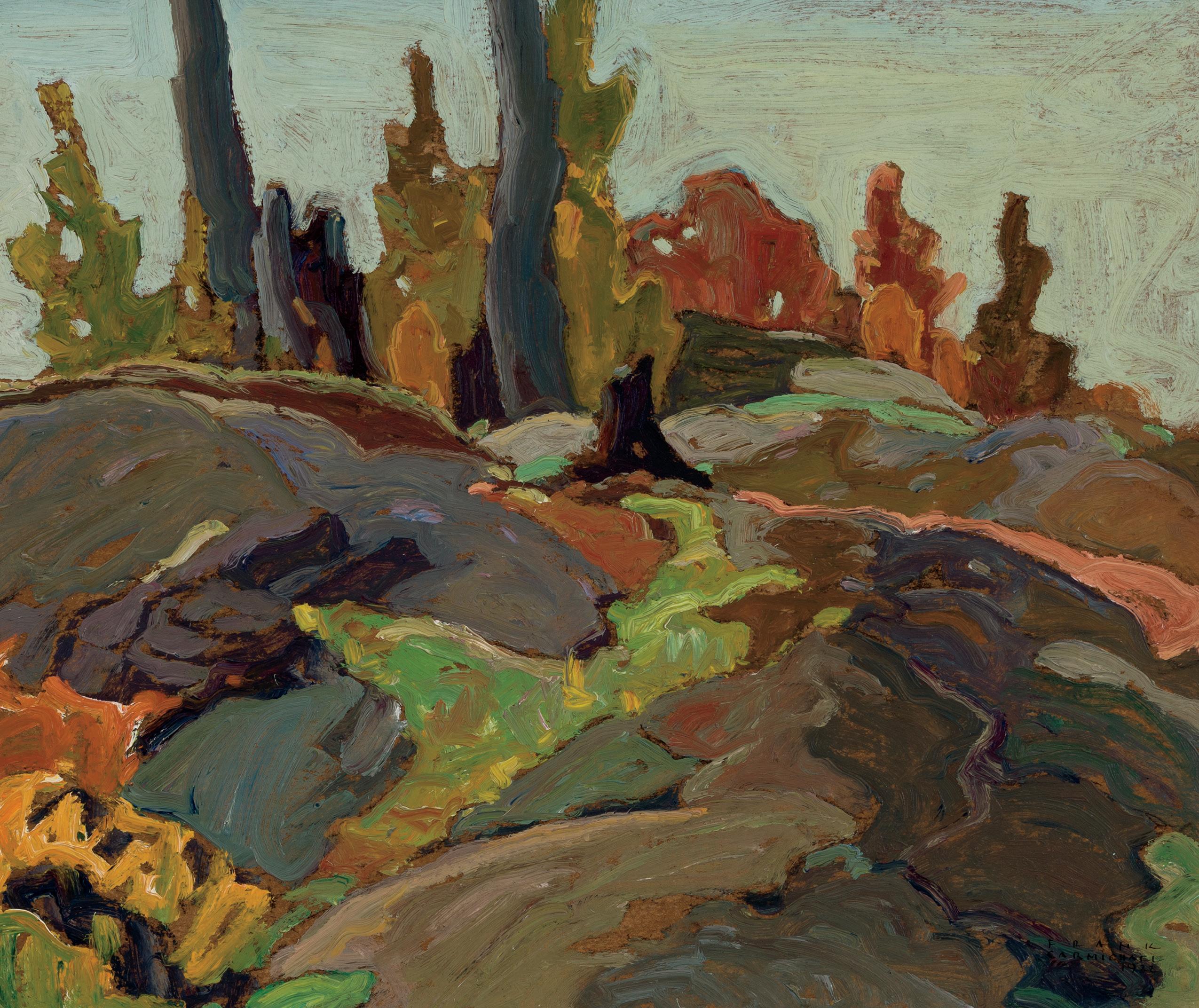
Gallery of Canada,
Art Gallery,
, January
an intense time of spiritual searching for Franklin Carmichael. He was looking for a higher order beyond material form—a unity of nature and the universe. He read
His style emerged from one of tapestry-like forms inspired by Japanese design and French Art Nouveau into the more mus cular representation of the landscape as seen in Morning Light. Although this work was painted a few years before he accompa nied Lawren Harris on sketching trips to Lake Superior, starting in 1925, Carmichael exhibited in the early Group of Seven shows in 1920, 1921 and 1922. Given their similar interests in spirituality, Carmichael was likely influenced by Harris, as this painting has affinities with the simplifications beginning to show in Harris’s work. Morning Light is a bold work that shows Carmichael’s auda cious use of colour and composition—such as the trees that move up out of the picture plane and the layered, tumbling rock forms. e stimate: $ 40,000 – 60,000
Habitant Farm in Winter oil on canvas, signed 15
Private Collection, New Hampshire Important Canadian Art, Sotheby’s Canada, May 11, 1994, lot 136 Angus and Cathy MacNaughton, California
Russell Harper, Krieghoff,
and sense of quality that grips the attention as do no others by his generation of Canadian artists.” An important part of Krieghoff’s oeuvre were images of the habitants of Quebec in their rural set tings, captured carrying out their everyday activities. The artist took a romantic view of these people, seeing them as hard-work ing but fun loving, fond of eating, drinking and dancing.
ORNE
K RIEGHO ff WAS one of a small group of artists in the nineteenth century, including Paul Kane, whose work had a specifically Canadian character. Krieghoff’s paintings of habi tants, Indigenous people, army officers, city dwellers and the landscape, as J. Russell Harper noted, “have an intimacy, verve,
Habitant Farm in Winter is replete with charming details—a horse pulling a berline-barque sleigh stops by a farmhouse, its occupants chatting with the gesticulating farmer, observed by two children and a figure on the veranda. The sturdy canadien horse bends down to look at the dog in an echo of the human social exchange. Krieghoff’s depiction of the life of these vital people is fascinating. Habitant Farm in Winter is also a finely painted land scape; it is a tour de force of visual effects, showcasing Krieghoff’s exquisite handling of snow, fine detail in the trees and the softly glowing layers of clouds in the overcast sky.
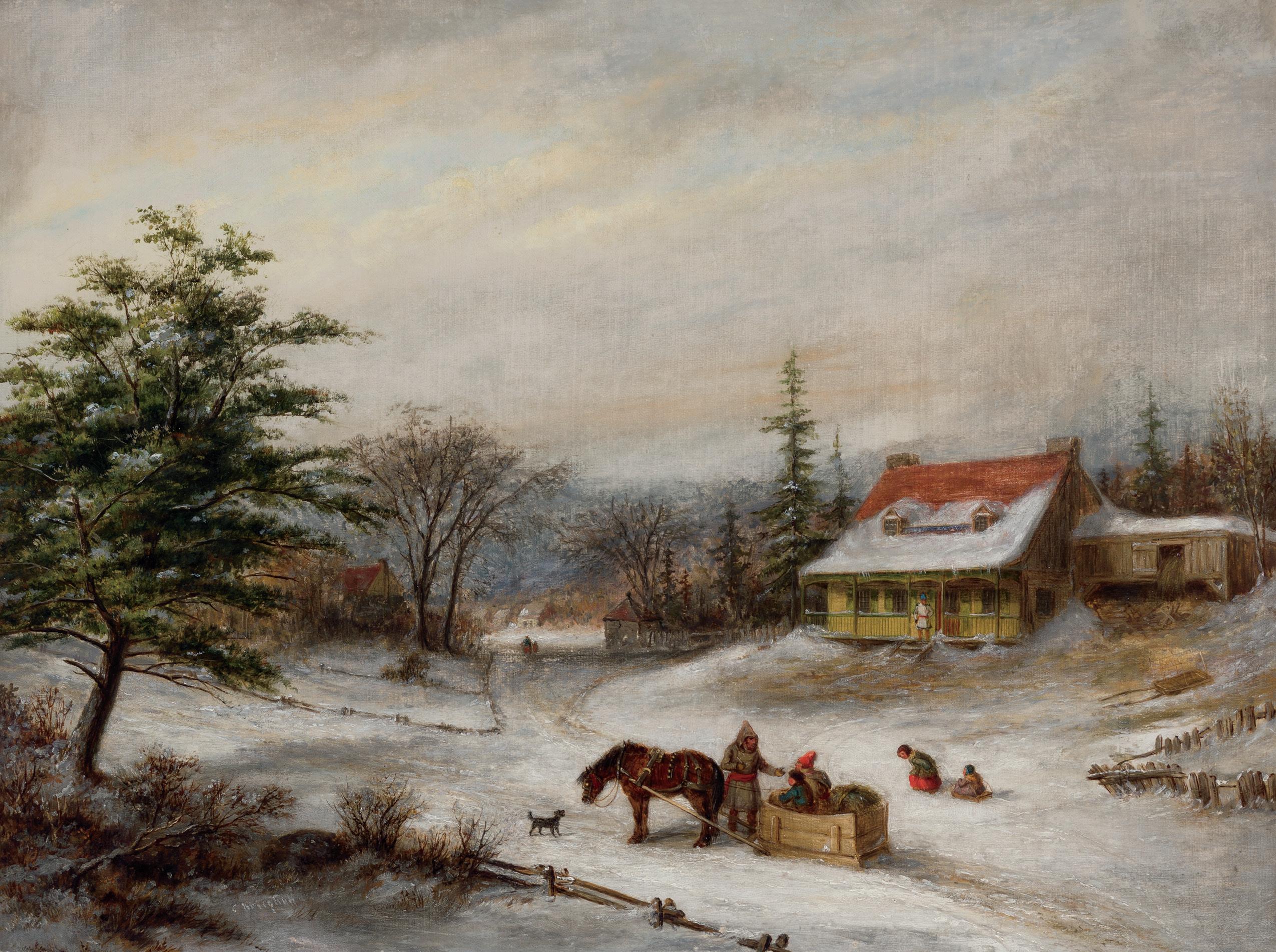
1872
Indian Basket Seller oil on canvas, signed and on verso titled on the gallery label 10 3/4 × 9 1/4 in, 27.3 × 23.5 cm
p rovenan C e Galerie Walter Klinkhoff Inc., Montreal Private Collection, Ontario
l iterature
Marius Barbeau, Cornelius Krieghoff: Pioneer Painter of North America, 1934, page 148, listed pages 147 – 148
J. Russell Harper, Krieghoff, 1999, a similar oil entitled The Indian Woman Basket Seller, dated circa 1850s, reproduced page 126
W HI l E l IVING IN Montreal in the 1850s, Cornelius Krieghoff observed the Indigenous moccasin and basket sellers from Caughnawaga who came to the city to ply their wares, and he often depicted them traveling through the surrounding landscape.
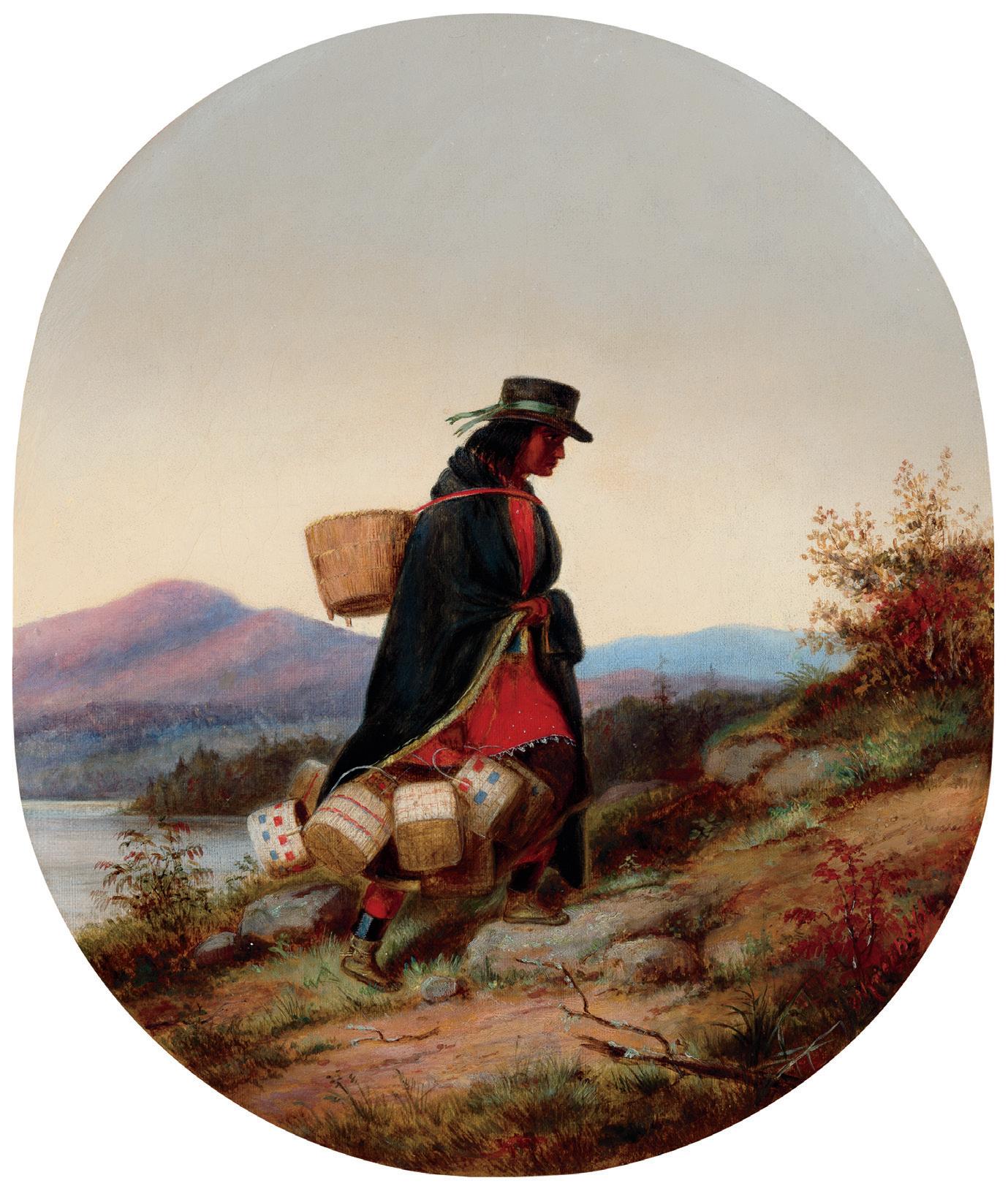
First Nations subjects comprised about a third of his oeuvre, with subjects ranging from single figures to complex tableau scenes.
A work of this title is included in the 1934 listing of Krieghoff’s works by ethnographer Marius Barbeau, with this description:
Summertime. Figure occupies half the height of picture, facing right. Mounting an incline. Beaver hat, wide brim and blue ribbon. Under-robe, red; dark blue blanket. Seven bas kets string next to skirt; larger one of bark held by pack strap across shoulder. Distant hills.
This painting reflects Krieghoff’s fine attention to detail, and Barbeau described the painting as “carefully and well painted.”
The work includes a particularly fine vista, with Krieghoff staging the woman against a glowing sky. The subject reflects Krieghoff’s romantic view of Indigenous people as mysterious and selfsufficient, at ease with moving through the wild landscape alone.
Paintings such as this were often acquired by local merchants as well as military men from Britain, to whom they were exotic reminders of their time in Canada.
e stimate: $ 20,000 – 30,000
Elm Street
watercolour on paper, signed and dated 1939 and on verso inscribed by Douglas Duncan W-138 and Elm St. on the sheet and W-398 / W-146 / Frame and Glass on the labels 14 × 20 in, 35.6 × 50.8 cm
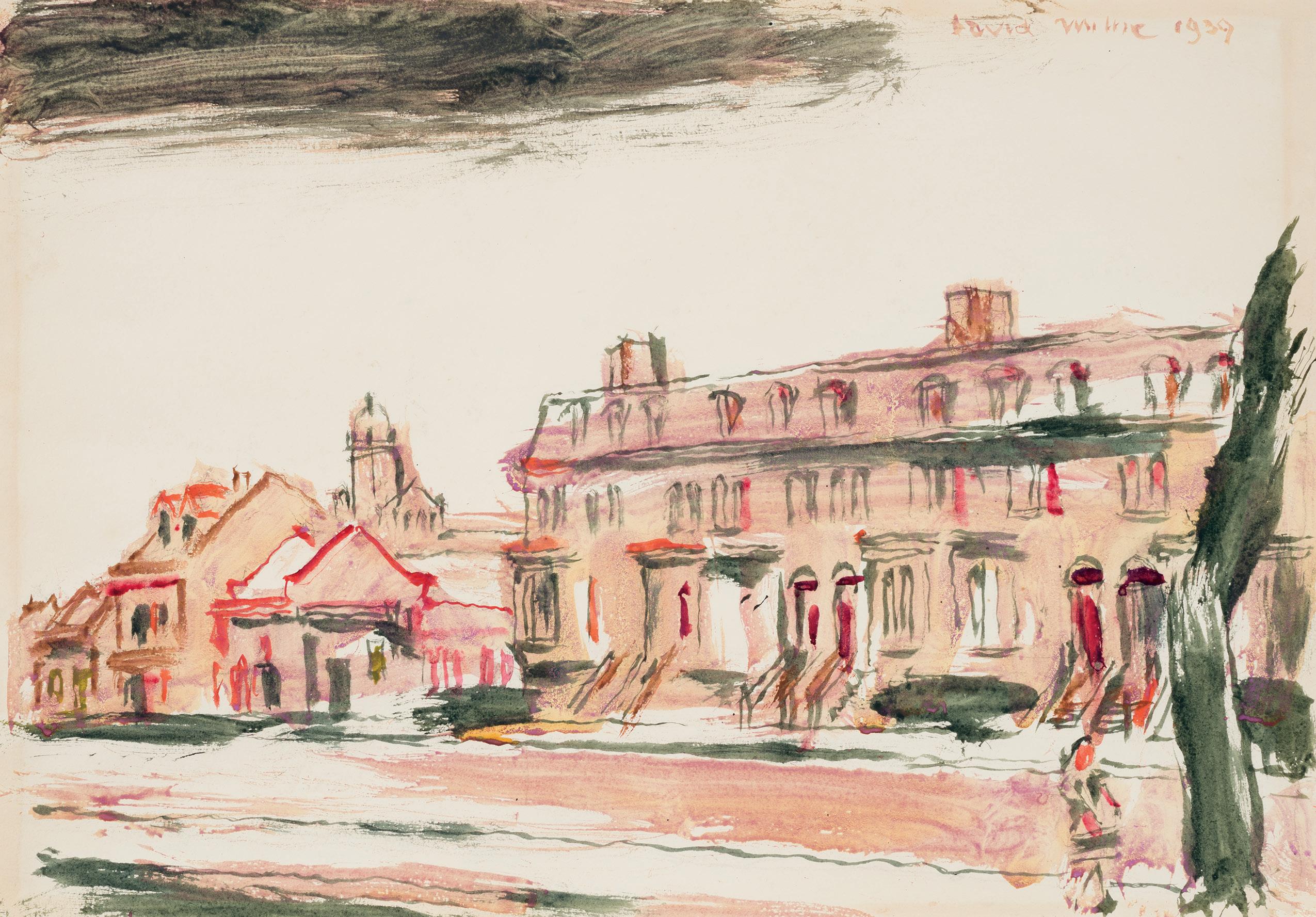
p rovenan C e
Douglas Duncan Picture Loan Society, circa 1965 Canadian Art, Joyner Fine Art, May 29, 2001, lot 42
Private Collection, Ontario By descent to the present Private Estate, Ontario
Sixty-ninth Annual Spring Exhibition, Ontario Society of Artists, Art Gallery of Toronto, 1941, page 12
David Milne: The Toronto Year, 1939 – 1940 , Marlborough-Godard, 1976, page 6, listed page 11
David Milne Jr. and David P. Silcox, David B. Milne: Catalogue Raisonné of the Paintings, Volume 2: 1929 – 1953 , 1998, reproduced page 700, catalogue #401.13
Douglas Duncan Picture Loan Society, Toronto, Recent Water Colours by David Milne (Autumn 1939 to Autumn 1940), January 11 – 24, 1941, catalogue #8
Art Gallery of Toronto, Sixty-ninth Annual Spring Exhibition, Ontario Society of Artists, March 7 – 31, 1941, catalogue #109 Marlborough-Godard, Toronto, David Milne: The Toronto Year, 1939 – 1940 , January 1976, catalogue #8 I N 1939 , dAVI d MI l NE moved from Six Mile Lake to Toronto, where he stayed until fall of 1940. It was a personally and profes sionally fulfilling year—Milne moved in with Kathleen Pavey, and Douglas Duncan started showing his work. Duncan ensured that Milne was included in exhibitions at the Art Gallery of Toronto, the Canadian Society of Painters in Water Colour, the Canadian Group of Painters and the 1939 New York World’s Fair, to name a few. Also, after the isolation of Six Mile Lake, Milne enjoyed see ing films and visiting museums and art galleries.
Milne worked predominantly in watercolour in Toronto, paint ing urban subjects and rural settings such as the upper Don River valley, as well as interiors and still lifes. Elm Street is two blocks north of Dundas Street, off Yonge Street, although these build ings are now demolished or transformed. This painting shows Milne’s shift from his drybrush style of the 1920s. He described his new style as “vivid and gay” and “far from realistic,” delineat ing the shape of the buildings with black lines and applying colour with wet washes. Milne left bare paper for sky—providing spatial breathing space—but topped off the left corner with an area of black to denote clouds. In Elm Street, Milne shows his mastery of watercolour, handling his effects with fluid ease. e stimate: $ 30,000 – 40,000
CSGA CSPWC 1882 – 1953
Reading by the Table watercolour on paper, on verso titled, dated February ? 1940 and inscribed by Douglas Duncan W-180 and 178 15 1/4 × 20 1/4 in, 38.7 × 51.4 cm
p rovenan C e
Douglas Duncan Picture Loan Society, Toronto Acquired from the Art Rental Service, Art Gallery of Toronto, by Morris Altman, Toronto, 1966 Canadian Art, Joyner / Waddington’s, November 23, 2004, lot 24
Private Collection, Montreal Canadian Fine Art, Joyner / Waddington’s, November 28, 2006, lot 35
Private Collection, Toronto
l iterature
David Milne Jr. and David P. Silcox, David B. Milne: Catalogue Raisonné of the Paintings, Volume 2: 1929 – 1953 , 1998, page 720, reproduced page 720, catalogue #401.74
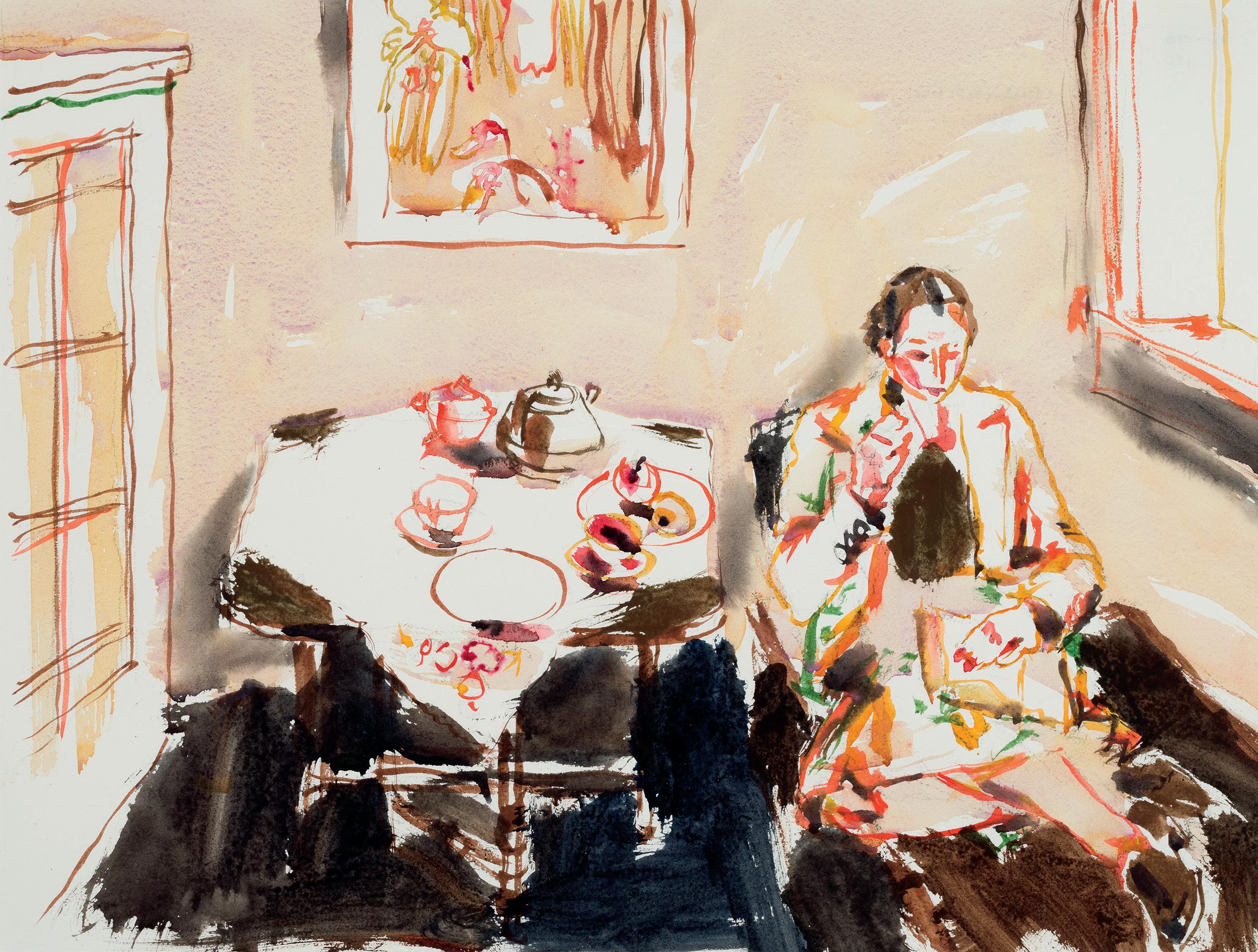
dAVI d M I l NE MOVE d to Toronto in the summer of 1939 to live with Kathleen Pavey, and this sojourn, although brief, was very
productive. (The couple moved to Uxbridge, Ontario, in fall of 1940.) The happy change in Milne’s private life infused his paint ings with joy and vitality. Milne’s professional life also took a turn for the better, as Douglas Duncan began to mount regular exhibi tions of his work at his Picture Loan Society gallery and promoted his work vigorously.
This watercolour was painted in one of the various apartments the Milnes stayed in during this time, and shows Kathleen read ing in their dining room. Milne produced five versions of this subject, but praised this composition as being the most successful. The painting is full of charming details—one of Milne’s water colours, Honeysuckle, is on the back wall, and the table shows the remains of a lunch. Milne used coloured outlines to define forms, and he struck a fine balance between painted washes and unpainted paper to define his image. He commented in his diary about his composition: “It is an example of unity being sought by a deliberate breaking of the parts so they do not separate but unite.” Reading by the Table, with its natural, fluid effects, captures an atmosphere of intimacy and is a window into Milne’s life.
e stimate: $ 15,000 – 25,000
Little Reflections, Dart’s Lake, Adirondacks, NY watercolour on paper, signed, dated Sept. 29, 1921 and inscribed Dart's Camp and on verso inscribed by Douglas Duncan #95 (crossed out) / #98 (crossed out) / #141 15 × 22 1/2 in, 38.1 × 57.2 cm
Douglas Duncan Picture Loan Society, Toronto, circa 1960 Private Collection, Ottawa
By descent to the present Private Collection, Ontario
David Milne Jr. and Nick Johnson, “David Milne: His Journal and Letters of 1920 and 1921, a Document of Survival,” artscanada no. 30, August 1973, reproduced page 53
David P. Silcox, Painting Place: The Life and Work of David B. Milne, 1996, reproduced page 144
David Milne Jr. and David P. Silcox, David B. Milne: Catalogue Raisonné of the Paintings, Volume 1: 1882 – 1928 , 1998, page 314, reproduced page 325, catalogue #203.29

e xhibited
Art Association of Montreal, 1924, titled as Across the Lake, catalogue #82 Arts Club, Montreal, 1924
fROM M Ay O f 1921, due to their difficult financial straits, David and Patsy Milne moved to Big Moose in the western Adirondacks to work at the summer resort called Dart’s Camp. The resourceful Milne razed a small tool shed and rebuilt it as a little cabin beside the lake. With his afternoons and evenings free, Milne painted watercolours en plein air and on the porch of the cabin when it rained, working on the reductive and original drybrush watercolour style that he had developed earlier in France and Belgium. In his autobiography he wrote, “The Dart’s pictures were all in the same vein. They might be described as line drawings in colour. Shape was all-important, colour was a mere agent in simplifying the form. The chief means of simplification was form itself, a contrast of open and worked-over spaces.”
This watercolour is spare in its use of form—the reflections appearing only in small sections in the mid-lake, the trees in the hills just outlines, their black lines twinned with lines in a care fully controlled palette of green and reddish and orange brown. At least half of the watercolour is bare paper. In Little Reflections, Dart’s Lake, Adirondacks, N y , Milne’s minimalist approach focuses attention on his elegant use of line and allows his forms to vibrate through the space he left.
e stimate: $ 30,000 – 50,000
Gaspé oil on board, signed and on verso signed, titled and dated 1927 9 × 12 in, 22.9 × 30.5 cm
p rovenan C e Kaspar Gallery, Toronto Angus and Cathy MacNaughton, California
I N 1927, A RTHUR l ISMER left his position of vice-principal at the Ontario College of Art and began to teach at the Art Gallery of Toronto. He continued to paint, and that same year he went on a sketching trip to the picturesque Gaspé area of Quebec, travel ing on a CNR rail pass that his friend Eric Brown, director of the National Gallery of Canada, had obtained for him.
This oil sketch is a fine example of the vigour of Lismer’s landscapes from this classic Group of Seven period. The ges tural brushwork in the sky is particularly striking, dramatically delineating the forward thrust of the dark cloud formations, con trasted by luminous clouds above them, into the rich turquoise sky. This painting is a tour de force of atmospheric effects, such as the localized sheets of rain that cascade downward, caught by the light streaming from the right that then bounces and sparkles across the water, defined by bright daubs of paint. Lismer uses bold brush-strokes to depict the boats lying offshore and pulls the viewer’s eye up into the sky with the vertical movement of their masts. Lismer has compressed the exhilarating energy of this Gaspé scene into this oil sketch with great finesse.
e stimate: $ 25,000 – 35,000





















































t erms and Conditions of b usiness
T HESE terms aNd Co N ditio N s of Busi N ess represent the terms upon which the Auction House contracts with the Consignor and, acting in its capacity as agent on behalf of the Consignor, contracts with the Buyer. These Terms and Conditions of Business shall apply to the sale of the Lot by the Auction House to the Buyer on behalf of the Consignor, and shall supersede and take precedence over any previously agreed Terms and Conditions of Business. These Terms and Conditions of Business are hereby incorporated into and form part of the Consignment Agreement entered into by the Auction House and the Consignor.
The Auction House is Heffel Gallery Limited, or an affiliated entity;
The Consignor is the person or entity named in the Consign ment Agreement as the source from which the Property or Lot has been received for auction;
The Seller’s Commission is the amount paid by the Consignor to the Auction House on the sale of a Lot, which is calculated on the Hammer Price, at the rates specified in writing by the Consignor and the Auction House on the Consignment Agreement Form, plus applicable Sales Tax and Expenses;
The Property is any Property delivered by the Consignor to the Auction House to be placed in the auction sale held by the Auction House on its premises, online or elsewhere and, specifically, that Property described by Lot number in the Auction House catalogue for the auction sale. The Auction House will have the authority to partition the Property into Lots (the “Lots” or “Lot”);
The Reserve is a confidential minimum price for the sale of the Lot, agreed to between the Consignor and the Auction House. The Reserve will not exceed the low estimate;
Knocked Down means the conclusion of the sale of the Lot being auctioned by the Auctioneer;
Expenses shall include all costs incurred, directly or indirectly, in relation to the consignment and sale of the Lot;
The Hammer Price is the price at which the Auctioneer has Knocked Down the Lot to the Buyer;
The Buyer is the person, corporation or other entity or such enti ty’s agent who bids successfully on the Lot at the auction sale;
The Purchase Price is the Hammer Price and the Buyer’s Premium, applicable Sales Tax and additional charges and Expenses, including expenses due from a defaulting Buyer;
The Buyer’s Premium is the amount paid by the Buyer to the Auction House on the purchase of a Lot, which is calcu lated on the Hammer Price as follows: a rate of twenty-five percent (25%) of the Hammer Price of the Lot up to and including $ 25,000; plus twenty percent (20%) on the part of the Hammer Price over $ 25,000 and up to and including $ 5,000,000; plus fifteen percent (15%) on the part of the Hammer Price over $ 5,000,000, plus applicable Sales Tax;
Sales Tax means Federal and Provincial sales, excise and other taxes applicable to the sale of the Lot, applied using place of supply rules required by Canadian taxation authori ties. QST will be levied on all purchases collected in Quebec or shipped to Quebec;
A Registered Bidder is a bidder who has fully completed the registration process, provided the required information to the Auction House and has been assigned a unique paddle num ber for the purpose of bidding on Lots in the auction;
The Proceeds of Sale are the net amount due to the Consignor from the Auction House, which shall be the Hammer Price less Seller’s Commission at the Published Rates, Expenses, Sales Tax and any other amounts due to the Auction House or associated companies;
These Terms and Conditions of Business apply to all live and online auction sales conducted by the Auction House. For the purposes of online auctions, all references to the Auctioneer shall mean the Auction House and Knocked Down is a literal reference defining the close of the auction sale.
The Auction House acts solely as agent for the Consignor, except as otherwise provided herein.
a) The Buyer is the highest Registered Bidder acknowledged by the Auctioneer as the highest bidder at the time the Lot is Knocked Down;
b) The Auctioneer has the right, at their sole discretion, to reopen a Lot if they have inadvertently missed a Bid, or if a Registered Bidder, immediately at the close of a Lot, notifies the Auctioneer of their intent to Bid;
c) The Auctioneer shall have the right to regulate and control the bidding and to advance the bids in whatever intervals they consider appropriate for the Lot in question;
d) The Auction House shall have absolute discretion in settling any dispute in determining the successful bidder;
e) The Buyer acknowledges that invoices generated during the sale or shortly after may not be error free, and therefore are subject to review;
f) Every Registered Bidder shall be deemed to act as principal unless the Auction House has acknowledged in writing at least two (2) business days prior to the date of the auction that the Registered Bidder is acting as an agent on behalf of a dis closed principal and such agency relationship is acceptable to the Auction House;
g) In order to become a Registered Bidder, the registration pro cess shall be completed in full, and the required information shall be provided to the Auction House. Every Registered Bidder will be assigned a unique paddle number (the “Pad dle”) for the purpose of bidding on Lots in the auction. Those interested in bidding in the live auction via telephone bid, absentee bid or through the Digital Saleroom shall register at least two (2) business days in advance of the auction. For online auctions, a password will be created for use only in current and future online auctions. This online registration procedure does not allow for participation in the live auction and may require up to two (2) business days to complete;
h) Every Registered Bidder acknowledges that once a bid is made with their Paddle, or Paddle and password, as the case may be, it may not be withdrawn without the consent of the Auctioneer, who, in their sole discretion, may refuse such consent; and
i) Every Registered Bidder agrees that if a Lot is Knocked Down on their bid, they are bound to purchase the Lot for the Pur chase Price.
The Buyer shall pay the Purchase Price (inclusive of the Buy er’s Premium) and applicable Sales Tax to the Auction House. The Buyer acknowledges and agrees that the Auction House may also receive a Seller’s Commission.
All or part of the Sales Tax may be exempt in certain circum stances if the Lot is delivered outside of the jurisdiction of sale of the Lot. It is the Buyer’s obligation to demonstrate, to the satisfaction of the Auction House, that such delivery or removal results in an exemption from the relevant Sales Tax legislation. Shipments out of the jurisdiction of sale of the Lot(s) shall only be eligible for exemption from Sales Tax if shipped directly from the Auction House with shipping contracted by the Auction House. All claims for Sales Tax exemption must be made prior to or at the time of payment of the Purchase Price. Sales Tax will not be refunded once the Auction House has released the Lot. The Buyer agrees and shall fully indemnify the Auction House for any amount
claimed by any taxing authority due as Sales Tax upon the sale of the Lot, including any related costs, legal fees, interest and penalties.
a) The Buyer shall:
(i) unless they have already done so, provide the Auction House with their name, address and banking or other suitable refer ences as may be required by the Auction House; and
(ii) make payment by 4:30 p.m. on the seventh (7th) day follow ing the auction by: a) Bank Wire direct to the Auction House’s account, b) Certified Cheque or Bank Draft, c) Personal or Corporate Cheque, d) Debit Card and Credit Card only by Visa, Mastercard or Union Pay or e) Interac e-Transfer. Bank Wire payments should be made to the Royal Bank of Canada as per the account transit details provided on the invoice. All Certified Cheques, Bank Drafts and Personal or Corporate Cheques must be verified and cleared by the Auction House’s bank prior to all purchases being released. Credit Card pay ments are subject to our acceptance and approval and to a maximum of $ 5,000 if the Buyer is providing their Credit Card details by fax or to a maximum of $ 25,000 per Lot pur chased if paying online or if the Credit Card is presented in person with valid identification. The Buyer is limited to two e-Transfers per Lot and up to a maximum of $ 10,000 per e-Transfer as per the instructions provided on the invoice. In all circumstances, the Auction House prefers payment by Bank Wire.
b) Title shall pass, and release and/or delivery of the Lot shall occur, only upon payment of the Purchase Price by the Buyer and receipt of cleared funds by the Auction House.
a) All representations or statements made by the Auction House, or in the Consignment Agreement, or in the catalogue or other publication or report as to the authorship, origin, date, age, size, medium, attribution, genuineness, provenance, con dition or estimated selling price of the Lot are statements of opinion only. The Buyer agrees that the Auction House shall not be liable for any errors or omissions in the catalogue or any supplementary material produced by the Auction House;
b) All photographic representations and other illustrations pre sented in the catalogue are solely for guidance and are not to be relied upon in terms of tone or colour or necessarily to reveal any imperfections in the Lot;
c) Many Lots are of an age or nature which precludes them from being in pristine condition. Some descriptions in the catalogue or given by way of condition report make reference to damage and/or restoration. Such information is given for guidance only and the absence of such a reference does not imply that a Lot is free from defects, nor does any reference to particular defects imply the absence of others;
d) The prospective Buyer must satisfy themselves as to all mat ters referred to in a), b) and c) of this paragraph by inspection, other investigation or otherwise prior to the sale of the Lot. The Buyer acknowledges that the Buyer has not relied on the Auction House, its statements or descriptions in regard to determining whether or not to purchase a Lot. The Buyer understands it is incumbent upon the Buyer to inspect the Lot
and hire any necessary experts to make the determination as to the nature, authenticity, quality and condition of any Lot. If the prospective Buyer is unable to personally view any Lot, the Auction House may, upon request, e-mail or fax a condition report describing the Lot to the prospective Buyer. Although the Auction House takes great care in executing such condition reports in both written and verbal format, condition reports are only matters of opinion, are non-exhaustive, and the Buyer agrees that the Auction House shall not be held responsible for any errors or omissions contained within. The Buyer shall be responsible for ascertaining the condition of the Lot; and
e) The Auction House makes no representations or warranties to the Buyer that the Buyer of a Lot will acquire any copyright or other reproduction right in any purchased Lot.
a) The Buyer shall collect the Lot from the Auction House by 4:30 p.m. on the seventh (7th) day following the date of the auction sale, after which date the Buyer shall be responsible for all Expenses until the date the Lot is removed from the offices of the Auction House;
b) All packing, handling and shipping of any Lot by the Auction House is undertaken solely as a courtesy service to the Buyer, and will only be undertaken at the discretion of the Auction House and at the Buyer’s risk. Prior to all packing and ship ping, the Auction House must receive a fully completed and signed Shipping Authorization Form for Property and pay ment in full of all purchases; and
c) The Auction House shall not be liable for any damage to glass or frames of the Lot and shall not be liable for any errors or omissions or damage caused by packers and shippers, whether or not such agent was recommended by the Auction House.
a) The purchased Lot shall be at the Consignor’s risk in all respects for seven (7) days after the auction sale, after which the Lot will be at the Buyer’s risk. The Buyer may arrange insurance coverage through the Auction House at the then prevailing rates and subject to the then existing policy; and
b) Neither the Auction House nor its employees nor its agents shall be liable for any loss or damage of any kind to the Lot, whether caused by negligence or otherwise, while any Lot is in or under the custody or control of the Auction House. Proceeds received from the insurance shall be the extent of the Auction House’s liability for any loss, damage or diminution in value.
If the Buyer fails either to pay for or to take away any Lot by 4:30 p.m. on the seventh (7th) day following the date of the auction sale, the Auction House may in its absolute discretion be entitled to one or more of the following remedies without providing further notice to the Buyer and without prejudice to any other rights or remedies that the Auction House or the Consignor may have:
a) To issue judicial proceedings against the Buyer for damages for breach of contract together with the costs of such proceed ings on a full indemnity basis;
b) To rescind the sale of that or any other Lot(s) sold to the Buyer;
c) To resell the Lot or cause it to be resold by public or private sale, or by way of live or online auction, with any deficiency to be claimed from the Buyer and any surplus, after Expenses, to be delivered to the Buyer;
d) To store the Lot on the premises of the Auction House or third-party storage facilities with Expenses accruing to the account of the Buyer, and to release the Lot to the Buyer only after payment of the Purchase Price and Expenses to the Auc tion House;
e) To charge interest on the Purchase Price at the rate of five percent (5%) per month above the Royal Bank of Canada base rate at the time of the auction sale and adjusted month to month thereafter;
f) To retain that or any other Lot sold to or consigned by the Buyer at the same or any other auction and release the same only after payment of the aggregate outstanding Purchase Price;
g) To apply any Proceeds of Sale of any Lot then due or at any time thereafter becoming due to the Buyer towards settle ment of the Purchase Price, and the Auction House shall be entitled to a lien on any other property of the Buyer that is in the Auction House’s possession for any purpose;
h) To apply any payments made by the Buyer to the Auction House towards any sums owing from the Buyer to the Auc tion House without regard to any directions received from the Buyer or their agent, whether express or implied;
i) In the absolute discretion of the Auction House, to refuse or revoke the Buyer’s registration in any future auctions held by the Auction House; and
j) All the above rights and remedies granted to the Auction House may be assigned to the Consignor at the Auction House’s discretion. Further, the Auction House may disclose to the Consignor the Buyer’s identity, contact information and other such information as the Consignor may need in order to maintain a claim against the Buyer for non-payment.
The Auction House, its employees and agents shall not be responsible for the correctness of any statement as to the authorship, origin, date, age, size, medium, attribution, gen uineness or provenance of any Lot or for any other errors of description or for any faults or defects in any Lot, and no warranty whatsoever is given by the Auction House, its employees or agents in respect of any Lot, and any express or implied conditions or warranties are hereby excluded.
a) Prospective Buyers are advised to inspect the Lot(s) before the sale, and to satisfy themselves as to the description, attri bution and condition of each Lot. The Auction House will arrange suitable viewing conditions during the preview pre ceding the sale, or by private appointment;
b) If prospective Buyers are unable to personally attend the live auction, telephone bid, or bid in the Digital Saleroom, the Auction House will execute bids on their behalf subject to completion of the proper Absentee Bid Form, duly signed and delivered to the Auction House two (2) business days before the start of the auction sale. The Auction House shall not
be responsible or liable in the making of any such bid by its employees or agents;
c) In the event that the Auction House has received more than one Absentee Bid Form on a Lot for an identical amount and at auction those absentee bids are the highest bids for that Lot, the Lot shall be Knocked Down to the person whose Absentee Bid Form was received first; and
d) At the discretion of the Auction House, the Auction House may execute bids in the live auction, if appropriately instructed by telephone or through Heffel’s Digital Sale room, on behalf of the prospective Buyer, and the prospective Buyer hereby agrees that neither the Auction House nor its employees nor agents shall be liable to either the Buyer or the Consignor for any neglect or default in making such a bid.
Without limitation, the Buyer acknowledges that certain property of Canadian cultural importance sold by the Auction House may be subject to the provisions of the Cultural Prop erty Export and Import Act (Canada), and that compliance with the provisions of the said act is the sole responsibility of the Buyer. Failure by the Buyer to obtain any necessary export license shall not affect the finality of the sale of the Lot or the obligations of the Buyer.
a) The Auction House shall have absolute discretion as to whether the Lot is suitable for sale, the particular auction sale for the Lot, the date of the auction sale, the manner in which the auction sale is conducted, the catalogue descriptions of the Lot, and any other matters related to the sale of the Lot at the auction sale;
b) The Auction House reserves the right to withdraw any Lot at any time prior to the auction sale if, in the sole discretion of the Auction House:
(i) there is doubt as to its authenticity;
(ii) there is doubt as to the accuracy of any of the Consignor’s representations or warranties;
(iii) the Consignor has breached or is about to breach any provi sions of the Consignment Agreement; or
(iv) any other just cause exists.
c) In the event of a withdrawal pursuant to Conditions C.1.b (ii) or (iii), the Consignor shall pay a charge to the Auction House, as provided in Condition C.8.
a) The Consignor warrants to the Auction House and to the Buyer that the Consignor has and shall be able to deliver unencumbered title to the Lot, free and clear of all claims. You, as the Consignor, are the owner of the Lot or a joint owner of the Lot acting with the express permission of all of the other co-owners, or, if you are not the owner of the Lot:
(i) You have the permission of the owners to sell the property under the terms of this Agreement and the Buyer’s Agreement;
(ii) You will disclose to the owner(s) all material facts in relation to the sale of the Lot;
(iii) You are irrevocably authorized to receive the proceeds of sale on behalf of the owner(s) of the Lot;
(iv) You have or will obtain the consent of the owner(s) before you deduct any commission, costs or other amounts from the proceeds of sale you receive from the Auction House;
(v) You have conducted appropriate customer due diligence on the owner(s) of the Lot in accordance with any and all appli cable anti money laundering and sanctions laws, consent to us relying on this due diligence and will retain for a period of not less than five (5) years the documentation and records evidencing the due diligence;
(vi) You will make such documentation and records (including originals, if available) evidencing your due diligence promptly available for immediate inspection by an independent thirdparty auditor upon our written request to do so. The Auction House will not disclose such documentation and records to any third parties unless (1) it is already in the public domain, (2) it is required to be disclosed by law, or (3) it is in accor dance with anti–money laundering laws; and
(vii) You and your principal (if any) are not aware of, nor are you knowingly engaged in any activity designed to facilitate tax evasion or tax fraud.
b) At the time of handing over the Property to us, you have met all import and export requirements of all applicable law. You are not aware that anyone else has failed to meet these requirements;
c) The Property and any proceeds of sale paid to you pursuant to this Agreement will not be used for any unlawful purpose and are not connected with any unlawful activity;
d) The Consignor shall indemnify the Auction House, its employees and agents and the Buyer for breach of its repre sentations, warranties and obligations set forth herein and against all claims made or proceedings brought by persons entitled or purporting to be entitled to the Lot;
e) The Consignor shall indemnify the Auction House, its employees and agents and the Buyer against all claims made or proceedings brought due to any default of the Consignor in complying with any applicable legislation, regulations and these Terms and Conditions of Business; and
f) The Consignor shall reimburse the Auction House in full and on demand for all costs, Expenses, judgment, award, settlement, or any other loss or damage whatsoever made, including reasonable legal fees incurred or suffered as a result of any breach or alleged breach by the Consignor of Conditions or its obligations as set forth in this Agreement.
The Auction House is authorized by the Consignor to Knock Down a Lot at less than the Reserve, provided that, for the purposes of calculating the Proceeds of Sale due to the Con signor, the Hammer Price shall be deemed to be the full amount of the agreed Reserve established by the Auction House and the Consignor.
a) The Consignor authorizes the Auction House to deduct the Seller’s Commission and Expenses from the Hammer Price
and, notwithstanding that the Auction House is the Consign or’s agent, acknowledges that the Auction House shall charge and retain the Buyer’s Premium;
b) The Consignor shall pay and authorizes the Auction House to deduct all Expenses incurred on behalf of the Consignor, together with any Sales Tax thereon including but not limited to:
(i) the costs of packing the Lot and transporting it to the Auction House, including any customs, export or import duties and charges;
(ii) if the Lot is unsold, the costs of packing it and returning it to the Consignor, including any customs, export or import duties and charges;
(iii) the costs of any restoration to the Lot that has been agreed by the Consignor in advance;
(iv) the costs of any framing and/or unframing, and any mount ing, unmounting and/or remounting, if applicable for the Lot;
(v) the costs of any third-party expert opinions or certificates that the Auction House believes are appropriate for the Lot;
(vi) the costs of any physically non-invasive tests or analyses that the Auction House believes need to be carried out to decide the quality of the Lot, its artist or that it is authentic; and (vii) the costs of photographing the Lots for use in the catalogue and/or promoting the sale of the Lot or auction.
c) The Auction House retains all rights to photographic and printing material and the right of reproduction of such photographs.
a) Lots are only covered by insurance under the Fine Arts Insurance Policy of the Auction House if the Consignor so authorizes;
b) The rate of insurance premium payable by the Consignor is $ 15 per $ 1,000 (1.5%) of the greater value of the high esti mate value of the Lot or the realized Hammer Price or for the alternative amount as specified in the Consignment Receipt;
c) If the Consignor instructs the Auction House not to insure a Lot, THE AUCTION HOUSE SHAll HAVE NO lIABIlIT y Of ANy KINd fOR ANy lOSS, THEf T, dAMAGE, dIMINISHEd VAlUE TO THE lOT WHIlE IN ITS CARE, CUSTOdy OR CONTROl, and the Lot shall at all times remain at the risk of the Consignor, who hereby undertakes to:
(i) indemnify the Auction House against all claims made or proceedings brought against the Auction House in respect of loss or damage to the Lot of whatever nature, howsoever and wheresoever occurred, and in any circumstances even where negligence is alleged or proven;
(ii) reimburse the Auction House for all Expenses incurred by the Auction House. Any payment which the Auction House shall make in respect of such loss or damage or Expenses shall be binding upon the Consignor and shall be accepted by the Consignor as conclusive evidence that the Auction House was liable to make such payment; and
(iii) notify any insurer of the existence of the indemnity contained in these Terms and Conditions of Business.
d) The Auction House does not accept responsibility for Lots damaged by changes in atmospheric conditions and the Auc tion House shall not be liable for such damage nor for any other damage to picture frames or to glass in picture frames; and
e) The value for which a Lot is insured under the Fine Arts Insurance Policy of the Auction House in accordance with Condition C.5.b above shall be the total amount due to the Consignor in the event of a successful claim being made against the Auction House. The actual proceeds received from the Auction House’s insurance shall be and shall repre sent the sole liability of the Auction House for any damages, loss, theft or diminished value of the Lot. Under no circum stances shall the Auction House be liable for any special, consequential, incidental or indirect damages of any kind or lost profits or potential lost profits.
a) The Auction House shall pay the Proceeds of Sale to the Con signor thirty-five (35) days after the date of sale, if the Auction House has been paid the Purchase Price in full by the Buyer;
b) If the Auction House has not received the Purchase Price from the Buyer within the time period specified, then the Auction House will pay the Proceeds of Sale within seven (7) working days following receipt of the Purchase Price from the Buyer; and
c) If before the Purchase Price is paid in full by the Buyer, the Auction House pays the Consignor an amount equal to the Proceeds of Sale, title to the property in the Lot shall pass to the Auction House.
If the Buyer fails to pay to the Auction House the Purchase Price within thirty (30) days after the date of sale, the Auction House will endeavour to take the Consignor’s instructions as to the appropriate course of action to be taken and, so far as in the Auction House’s opinion such instructions are practicable, will assist the Consignor in recovering the Purchase Price from the Buyer, save that the Auction House shall not be obligated to issue judicial proceedings against the Buyer in its own name. Notwithstanding the foregoing, the Auction House reserves the right and is hereby authorized at the Consignor’s expense, and in each case at the absolute discretion of the Auction House, to agree to special terms for payment of the Purchase Price, to remove, store and insure the Lot sold, to settle claims made by or against the Buyer on such terms as the Auction House shall think fit, to take such steps as are necessary to collect monies from the Buyer to the Consignor and, if appro priate, to set aside the sale and refund money to the Buyer.
The Consignor may not withdraw a Lot prior to the auction sale without the consent of the Auction House. In the event that such consent is given, or in the event of a withdrawal pursuant to Condition C.1.b (ii) or (iii), a charge of twenty-five percent (25%) of the high presale estimate, together with any applicable Sales Tax and Expenses, is immediately payable to the Auction House, prior to any release of the Property.
a) Unsold Lots must be collected at the Consignor’s expense within the period of ninety (90) days after receipt by the Consignor of notice from the Auction House that the Lots
are to be collected (the “Collection Notice”). Should the Consignor fail to collect the Lot from the Auction House within ninety (90) days from the receipt of the Collection Notice, the Auction House shall have the right to place such Lots in the Auction House’s storage facilities or third-party storage facilities, with Expenses accruing to the account of the Consignor. The Auction House shall also have the right to sell such Lots by public or private sale and on such terms as the Auction House shall alone determine, and shall deduct from the Proceeds of Sale any sum owing to the Auction House or to any associated company of the Auction House including Expenses, before remitting the balance to the Con signor. If the incurred Expenses by the Auction House exceed the sums received from the sale of the Lot, the Buyer shall be liable for the difference between the sums received and the Expenses. If the Consignor cannot be traced, the Auction House shall place the funds in a bank account in the name of the Auction House for the Consignor. In this condition the expression “Proceeds of Sale” shall have the same meaning in relation to a private sale as it has in relation to a sale by auction;
b) Lots returned at the Consignor’s request shall be returned at the Consignor’s risk and expense and will not be insured in transit unless the Auction House is otherwise instructed by the Consignor at the Consignor’s expense; and
c) If any Lot is unsold by auction, the Auction House is autho rized as the exclusive agent for the Consignor for a period of ninety (90) days following the auction to sell such Lot by private sale or auction sale for a price that will result in a pay ment to the Consignor of not less than the net amount (i.e., after deduction of the Seller’s Commission and Expenses) to which the Consignor would have been entitled had the Lot been sold at a price equal to the agreed Reserve, or for such lesser amount as the Auction House and the Consignor shall agree. In such event, the Consignor’s obligations to the Auc tion House hereunder with respect to such a Lot are the same as if it had been sold at auction. The Auction House shall continue to have the exclusive right to sell any unsold Lots after the said period of ninety (90) days, until such time as the Auction House is notified in writing by the Consignor that such right is terminated.
The Consignor shall give to the Auction House all relevant information as to their Sales Tax status with regard to the Lot to be sold, which the Consignor warrants is and will be correct and upon which the Auction House shall be entitled to rely.
In consideration of the Auction House’s services to the Con signor, the Consignor hereby warrants and represents to the Auction House that the Consignor has the right to grant to the Auction House, and the Consignor does hereby grant to the Auction House, a non-exclusive, perpetual, fully paid up, royalty-free and non-revocable right and permission to: a) reproduce (by illustration, photograph, electronic reproduc tion, or any other form or medium whether presently known or hereinafter devised) any work within any Lot given to the Auction House for sale by the Consignor; and
b) use and publish such illustration, photograph or other repro duction in connection with the public exhibition, promotion and sale of the Lot in question and otherwise in connection with the operation of the Auction House’s business, including without limitation by including the illustration, photograph or other reproduction in promotional catalogues, compila tions, the Auction House’s Art Index, and other publications and materials distributed to the public, and by communicat ing the illustration, photograph or other reproduction to the public by telecommunication via an Internet website oper ated by or affiliated with the Auction House (“Permission”). Moreover, the Consignor makes the same warranty and rep resentation and grants the same Permission to the Auction House in respect of any illustrations, photographs or other reproductions of any work provided to the Auction House by the Consignor. The Consignor agrees to fully indemnify the Auction House and hold it harmless from any damages caused to the Auction House by reason of any breach by the Consignor of this warranty and representation.
1. The Auction House as agent for the Consignor is not respon sible for any act, omission or default by the Consignor or the Buyer.
2. The Auction House shall have the right at its absolute discre tion to refuse admission to its premises or attendance at its auctions by any person.
3. The Auction House has the right at its absolute discretion to refuse any bid, to advance the bidding as it may decide, to with draw or divide any Lot, to combine any two or more Lots and, in the case of dispute, to put up any Lot for auction again. At no time shall a Registered Bidder retract or withdraw their bid.
4. The Auctioneer may open the bidding on any Lot below the Reserve by placing a bid on behalf of the Auction House. The Auctioneer, on behalf of the Auction House, may continue to bid up to the amount of the Reserve, either by placing consec utive bids or by placing bids in response to other bidders.
5. For advertising and promotional purposes, the Consignor acknowledges and agrees that the Auction House shall, in relation to any sale of the Lot, make reference to the aggre gate Purchase Price of the Lot, inclusive of the Buyer’s Premium, notwithstanding that the Seller’s Commission is calculated on the Hammer Price.
6. Any indemnity hereunder shall extend to all actions, pro ceedings, costs, claims and demands whatsoever incurred or suffered by the person for whose benefit the indemnity is given, and the Auction House shall hold any indemnity on trust for its employees and agents where it is expressed to be for their benefit.
7. Any notice given hereunder shall be in writing and if given by post shall be deemed to have been duly received by the addressee within three (3) business days delivered by a recog nized overnight delivery service with a signature required.
8. The copyright for all illustrations and written matter relating to the Lots shall be and will remain at all times the absolute property of the Auction House and shall not, without the prior written consent of the Auction House, be used by any other person.
9. The Auction House will not accept any liability for any fail ure or errors that may occur in the operation of any online, telephonic, video or digital representations produced and/or broadcasted during an auction sale.
10. This Agreement shall be governed by and construed in accor dance with British Columbia Law and the laws of Canada applicable therein. Any dispute, controversy or claim arising out of, relating to, or in connection with this Agreement, or the breach, termination, or validity thereof (“Dispute”), shall be submitted for mediation in Vancouver, British Columbia, Canada. If the Dispute is not settled by mediation within sixty (60) days from the date when mediation is initiated, then the Dispute shall be submitted for final and binding arbitration to the British Columbia International Commercial Arbitra tion Centre, with such Dispute to be resolved pursuant to its Rules and procedure. The arbitration shall be conducted by one arbitrator, who shall be appointed within thirty (30) days after the initiation of the arbitration. The language used in the arbitration proceedings will be English. The arbitra tion shall be confidential, except to the extent necessary to enforce a judgment or where disclosure is required by law. The arbitration award shall be final and binding on all parties involved. Judgment upon the award may be entered by any court having jurisdiction thereof or having jurisdiction over the relevant party or its assets.
11. Unless otherwise provided for herein, all monetary amounts referred to herein shall refer to the lawful money of Canada.
12. All words importing the singular number shall include the plural and vice versa, and words importing the use of any gen der shall include the masculine, feminine and neuter genders and the word “person” shall include an individual, a trust, a partnership, a body corporate, an association or other incor porated or unincorporated organization or entity.
13. If any provision of this Agreement or the application thereof to any circumstances shall be held to be invalid or unen forceable, the remaining provisions of this Agreement, or the application thereof to other circumstances, shall not be affected thereby and shall be held valid to the full extent permitted by law.
14. In the event of any discrepancy or conflict between the English and French versions of these Terms and Conditions of Business, the English version will prevail.
The Buyer and the Consignor are hereby advised to read fully the Agreement which sets out and establishes the rights and obligations of the Auction House, the Buyer and the Consignor and the terms by which the Auction House shall conduct the sale and handle other related matters.
H E ff E l G A ll ER y lIMITE d maintains a strict Property Col lection Notice policy that governs the Property collection terms between the Auction House and the Consignor, Buyer and Clients being provided professional services from the Auction House. The Collection Notice is pursuant to the Auction House’s published Terms and Conditions of Business with specific reference to Conditions B.7, B.9, B.12, C.5, C.9 and D.6.
a) Sold Property must be collected or have a completed and signed Shipping Authorization Form for Property submitted to the Auction House within seven (7) days post auction sale date and a shipping dispatch date not greater than thirty (30) days post auction sale date;
2. Consignor
a) Unsold Property must be collected by the Consignor within ninety (90) days post auction sale date;
3. Client being provided additional professional services
a) Property delivered and deposited with the Auction House by the Client for the purpose of appraisal, assessment, research, consultancy, photography, framing, conservation or for other purpose must be collected within thirty (30) days after deliv ery receipt of the Property to the Auction House.
1. All Property in default to the Property Collection Notice, as defined in Condition A, will be resolved as follows:
a) Property in default of the Property Collection Notice will require a completed and signed Auction House or third party Storage Agreement for Property submitted to the Auction House within seven (7) days of default;
b) Property listed in the signed and completed Storage Agreement for Property may be moved off-site from the Auction House offices or preview galleries to warehouse storage at the Prop erty Owner’s expense;
c) Remaining unclaimed Property will be subject to the Unclaimed Property Act (British Columbia) [SBC 1999] 199948-19 to 32 and consequential amendments and repeal.
These Property Collection Notice terms shall supersede and take precedence over any previously agreed terms.
AAM Art Association of Montreal founded in 1860
AAN f M Association des artistes non-figuratifs de Montréal
AAP Association des arts plastiques
ACM Arts Club of Montreal
AGA Art Guild America
AGQ Association des graveurs du Québec
AHSA Art, Historical and Scientific Association of Vancouver
A l C Arts and Letters Club
AOCA Associate Ontario College of Art
ARCA Associate Member Royal Canadian Academy of Arts
ASA Alberta Society of Artists
ASPWC American Society of Painters in Water Colors
ASQ Association des sculpteurs du Québec
AUTO Les Automatistes
AWCS American Watercolor Society
BCSA British Columbia Society of Artists
BCS fA British Columbia Society of Fine Arts founded in 1909
BHG Beaver Hall Group, Montreal 1920 – 1922
CAC Canadian Art Club
CAS Contemporary Arts Society
CC Companion of the Order of Canada
CGP Canadian Group of Painters 1933 – 1969
CH Companion of Honour Commonwealth
CPE Canadian Painters–Etchers’ Society
CSAA Canadian Society of Applied Art
CSGA Canadian Society of Graphic Artists founded in 1905
CSMA Canadian Society of Marine Artists
CSPWC Canadian Society of Painters in Water Colour founded in 1925
EGP Eastern Group of Painters
f BA Federation of British Artists
f CA Federation of Canadian Artists
f RSA Fellow of the Royal Society of Arts G 7 Group of Seven 1920 – 1933
IA f Institut des arts figuratifs
IWCA Institute of Western Canadian Artists
l P Les Plasticiens
MSA Montreal Society of Arts
NA d National Academy of Design
NEAC New English Art Club
NSSA Nova Scotia Society of Artists
OC Order of Canada
OIP Ontario Institute of Painters
OM Order of Merit British
OSA Ontario Society of Artists founded in 1872
P 11 Painters Eleven 1953 – 1960
P d CC Print and Drawing Council of Canada
PNIAI Professional Native Indian Artists Incorporation
POSA President Ontario Society of Artists
PPCM Pen and Pencil Club, Montreal
PRCA President Royal Canadian Academy of Arts
PSA Pastel Society of America
PSC Pastel Society of Canada
P y Prisme d’yeux
QMG Quebec Modern Group
R 5 Regina Five 1961 – 1964
RA Royal Academy
RAAV Regroupement des artistes en arts visuels du Québec
RAIC Royal Architects Institute of Canada
RBA Royal Society of British Artists
RCA Royal Canadian Academy of Arts founded in 1880
RI Royal Institute of Painters in Watercolour
RMS Royal Miniature Society
ROI Royal Institute of Oil Painters
RPS Royal Photographic Society
RSA Royal Scottish Academy
RSC Royal Society of Canada
RSMA Royal Society of Marine Artists
RSPP Royal Society of Portrait Painters
RWS Royal Watercolour Society
SAA Society of American Artists
SAAVQ Société des artistes en arts visuels du Québec
SAP Société des arts plastiques
SAPQ Société des artistes professionnels du Québec SC The Studio Club
SCA Society of Canadian Artists 1867 – 1872
SCPEE Society of Canadian Painters, Etchers and Engravers
SSC Sculptors’ Society of Canada
SWAA Saskatchewan Women Artists’ Association
TCC Toronto Camera Club
TPG Transcendental Painting Group 1938 – 1942
WAAC Women’s Art Association of Canada
WIAC Women’s International Art Club
WS Woodlands School y R Young Romantics w Denotes that additional information on this lot can be found on our website at www.heffel.com
ϕ
Indicates that Heffel owns an equity interest in the Lot or may have funded all or part of our interest with the help of a third party. Additionally Heffel may have entered into arrangements to provide a Consignor a guaranteed Reserve bid. A guaranteed Reserve bid may have funded all or part with a third-party guarantor.
These catalogue terms are provided for your guidance:
Cornelius d avid k rieghoff
In our best judgment, a work by the artist.
a ttributed to Cornelius d avid k rieghoff
In our best judgment, a work possibly executed in whole or in part by the named artist.
s tudio of Cornelius d avid k rieghoff
In our best judgment, a work by an unknown hand in the studio of the artist, possibly executed under the supervision of the named artist.
Cir C le of Cornelius d avid k rieghoff
In our best judgment, a work of the period of the artist, closely related to the style of the named artist.
m anner of Cornelius d avid k rieghoff
In our best judgment, a work in the style of the named artist and of a later date.
a fter Cornelius d avid k rieghoff
In our best judgment, a copy of a known work of the named artist.
n ationality
Unless otherwise noted, all artists are Canadian.
s igned / t itled / d ated
In our best judgment, the work has been signed/titled/dated by the artist. If we state “dated 1856” then the artist has inscribed the date when the work was produced. If the artist has not inscribed the date and we state “1856”, then it is known the work was produced in 1856, based on independent research. If the artist has not inscribed the date and there is no independent date reference, then the use of “circa” approximates the date based on style and period.
In our best judgment, the signature/date is by a hand other than that of the artist.
Measurements are given height before width in both inches and centimetres.
Is intended to indicate previous collections or owners.
Any reference to certificates, literature or exhibition history represents the best judgment of the authority or authors named. Literature citations may be to references cited in our Lot essay. These references may also pertain to generic statements and may not be direct literary references to the Lot being sold.
Our Estimates are intended as a statement of our best judgment only, and represent a conservative appraisal of the expected Hammer Price.
H E ff E l TAKES GREAT pride in being the leader in the Canadian fine art auction industry and has an unparalleled track record. We are proud to have been the dominant auction house in the Cana dian art market from 2004 to the present. Our firm’s growth and success has been built on hard work and innovation, our commit ment to our Clients and our deep respect for the fine art we offer. At Heffel we treat our consignments with great care and respect, and consider it an honour to have them pass through our hands. We are fully cognizant of the historical value of the works we handle and their place in art history.
Heffel, to further define its distinction in the Canadian art auc tion industry, has taken the following initiative. David and Robert Heffel, second-generation art dealers of the Company’s founding Heffel family, have personally crafted the foundation documents (as published on our website www.heffel.com): Heffel’s Corporate Constitutional Values and Heffel’s Code of Business Conduct, Ethics and Practices. We believe the values and ethics set out in these documents will lay in stone our moral compass. Heffel has flour ished through more than four decades of change, since 1978, proof that our hard work, commitment, philosophy, honour and ethics in all that we do serve our Clients well.
Heffel’s Employees and Shareholders are committed to Heffel’s Code of Business Conduct, Ethics and Practices, together with Heffel’s Corporate Constitutional Values, our Terms and Conditions of Business and related corporate policies, all as amended from time to time, with respect to our Clients, and look forward to continued shared success in this auction season and ongoing.
h effel’s Code of b usiness Condu C t, e thi C s and p ra C ti C es
Please complete this Annual Subscription Form to receive our twice-yearly Auction Catalogues and Auction Result Sheet
To order, return a copy of this form with a cheque payable to: Heffel Gallery Limited, 2247 Granville Street Vancouver, BC , Canada V 6 H 3 G 1 Tel 604-732-6505 · Fax 604-732-4245 · Toll free 1-888-818-6505 mail@heffel.com · www.heffel.com
elivered within Canada
■ One Year (four catalogues) Post-War & Contemporary Art / Canadian, Impressionist & Modern Art $ 80
■ Two Years (eight catalogues) Post-War & Contemporary Art / Canadian, Impressionist & Modern Art $ 130
d elivered to the u nited s tates and o verseas
■ One Year (four catalogues) Post-War & Contemporary Art / Canadian, Impressionist & Modern Art $ 90
■ Two Years (eight catalogues) Post-War & Contemporary Art / Canadian, Impressionist & Modern Art $ 150
Please contact Heffel Gallery Limited (“Heffel”) to set up
■ One Block of 25 Searches $ 50
■ One-Year Subscription (35 searches per month) $ 250
■ Two-Year Subscription (35 searches per month) $ 350
Please complete this Collector Profile Form to assist us in offering you our finest service.
Heffel recommends submitting your Absentee Bid Form via e-mail to bids@heffel.com for expedited service. Should you wish to par ticipate in French, please complete the French version of this form.
you are bidding as a corporation (and not as an individual), please provide the Registered Business Name and Address of the corporation.
To be sure that bids will be accepted and delivery of the Lot(s) is/are not delayed, bidders not yet known to Heffel must supply a bank reference letter at least two (2) business days before the time of the auction. All Absentee Bidders must supply a valid Visa, Mastercard or UnionPay number, expiry date and CVV number.
I request Heffel Gallery Limited (“Heffel”) to enter bids on my behalf for the following Lots, up to the maximum Hammer Price I have indicated for each Lot. I understand that if my bid is successful, the purchase price shall be the Hammer Price plus the Buyer’s Premium calculated at a rate of twenty-five per cent (25%) of the Hammer Price of the Lot up to and including $ 25,000; plus twenty percent (20%) on the part of the Hammer Price over $ 25,000 and up to and including $ 5,000,000; plus fifteen percent (15%) on the part of the Hammer Price over $ 5,000,000, plus applicable Sales Tax. I understand that Heffel executes Absentee Bids as a convenience for its clients and is not responsible for inadvertently failing to execute bids or for errors relating to their execution of my bids. On my behalf, Heffel will try to purchase these Lots for the lowest possible price, taking into account the Reserve and other bids. If identical Absentee Bids are received, Heffel will give precedence to the Absentee Bid Form received first. I understand and acknowledge all successful bids are subject to the Terms and Conditions of Business printed in the Heffel catalogue.
authorize the above financial institution to release information to Heffel and to discuss with them particulars of my financial con dition and typical transactions conducted.
The Client agrees to receive e-mails and SMS notifications from Heffel.
To allow time for processing, Absentee Bids should be received at least two (2) business days before the sale begins. Heffel will confirm by telephone or e-mail all bids received. If you have not received our confirmation within two (2) business days, please re-submit your bids or contact us at:
13 Hazelton Avenue, Toronto, ON , Canada M 5 R 2 E 1 Tel 416-961-6505 · Fax 416-961-4245 bids@heffel.com · www.heffel.com
rEcEivEd (For oFFicE usE oNly)
coNFirMEd (For oFFicE usE oNly)
Heffel recommends submitting your Telephone Bid Form via e-mail to bids@heffel.com for expedited service. Should you wish to par ticipate in French, please complete the French version of this form.
you are bidding as a corporation (and not as an individual), please provide the Registered Business Name and Address of the corporation.
Price
(excluding Buyer’s
I request Heffel Gallery Limited (“Heffel”) to enter bids on my behalf for the following Lots, up to the maximum Hammer Price I have indicated for each Lot. I understand that if my bid is suc cessful, the purchase price shall be the Hammer Price plus the Buyer’s Premium calculated at a rate of twenty-five percent (25%) of the Hammer Price of the Lot up to and including $ 25,000; plus twenty percent (20%) on the part of the Hammer Price over $ 25,000 and up to and including $ 5,000,000; plus fifteen per cent (15%) on the part of the Hammer Price over $ 5,000,000, plus applicable Sales Tax. I understand that Heffel executes Tele phone/Absentee Bids as a convenience for its clients and is not responsible for inadvertently failing to execute bids or for errors relating to their execution of my bids. On my behalf, Heffel will try to purchase these Lots for the lowest possible price, taking into account the Reserve and other bids. I am aware that all tele phone bid lines may be recorded. I understand and acknowledge all successful bids are subject to the Terms and Conditions of Busi ness printed in the Heffel catalogue.
To be sure that bids will be accepted and delivery of the Lot(s) is/are not delayed, bidders not yet known to Heffel must supply a bank reference letter at least two (2) business days before the time of the auction. All Telephone Bidders must supply a valid Visa, Mastercard or UnionPay number, expiry date and CVV number.
(For oFFicE usE oNly)
Communi
The Client agrees to receive e-mails and SMS notifications from Heffel.
I authorize the above financial institution to release information to Heffel and to discuss with them particulars of my financial con dition and typical transactions conducted.
To allow time for processing, Telephone/Absentee Bids should be received at least two (2) business days before the sale begins. Heffel will confirm by telephone or e-mail all bids received. If you have not received our confirmation within two (2) business days, please re-submit your bids or contact us at:
Hazelton Avenue, Toronto, ON , Canada M 5 R 2 E 1 Tel 416-961-6505 · Fax 416-961-4245 bids@heffel.com · www.heffel.com
rEcEivEd (For oFFicE usE oNly)
Heffel recommends submitting your Digital Saleroom Registration Form via e-mail to bids@heffel.com for expedited service. This form should be received at least two (2) business days before the sale begins. Should you wish to participate in French, please complete the French version of this form.
If you are bidding as a corporation (and not as an individual), please provide the Registered Business Name and Address of the corporation.
cliENT billiNg NaME or rEgisTErEd busiNEss
addrEss or rEgisTErEd busiNEss addrEss (rEgisTErEd busiNEss billiNg NaME
ciTy
dayTiME TElEPhoNE
TElEPhoNE
E-Mail addrEss oNTario Tax NuMbEr (iF aPPlicablE)
■ e xisting h effel. C om u sers
Tax ExEMPTioN
MaTch
daTE oF birTh (aPPlicablE whEN biddiNg as aN iNdividual)
Once approved, those who have previously bid in Heffel’s online auctions will log on to Heffel.com with their existing online paddle number and password in order to access the digital saleroom for the live auction.
■ n ew h effel. C om r egistrants
dEsirEd Password (MiNiMuM oF 8 characTErs aNd a coMbiNaTioN oF NuMbErs, uPPErcasE, lowErcasE aNd sPEcial characTErs)
oNliNE PaddlE NuMbEr (To bE suPPliEd by hEFFEl uPoN aPProval)
If my bid is successful, the purchase price shall be the Hammer Price plus a Buyer’s Premium of twenty-five percent (25%) of the Hammer Price of the Lot up to and including $ 25,000; plus twenty percent (20%) on the part of the Hammer Price over $ 25,000 and up to and including $ 5,000,000; plus fifteen percent (15%) on the part of the Hammer Price over $ 5,000,000, plus applicable Sales Tax. I understand and acknowledge that all successful bids are subject to the Terms and Conditions of Business as printed in the Heffel catalogues.
To be sure that bids will be accepted and delivery of Lot(s) not delayed, bidders not yet known to Heffel should supply a bank reference at least two (2) business days before the time of the auction.
■ I authorize the above financial institution to release information to Heffel and to discuss with them particulars of my financial condition and typical transactions conducted.
d igital Communi C ation Consent The Client agrees to receive e-mails and SMS notifications from Heffel.
Heffel recommends submitting shipping authorization and payment by logging in at heffel.com for expedited service. Alternatively, please sign and return this form via e-mail to shipping@heffel.com or via fax to 1-888-685-6505. Please contact the Shipping Department at 1-888-818-6505 for questions.
Consolidated ground shipment (when available) to destination Heffel Gallery:
Heffel Vancouver
Heffel Montreal
Soft packed (Cardboard)
Heffel Calgary
Heffel Toronto
Hard packed (Custom crate)
shipment to address below via Heffel approved third-party carrier:
Soft packed (Cardboard)
Hard packed (Custom crate)
Heffel’s insurance does not cover Fedex shipments with glass. Framed works will be shipped without glass.
Property will be insured under Heffel’s insurance policy at a rate of 1.5% of the value. Heffel does not insure ceramics, frames or glass. Please review Section 3 of Heffel’s Terms and Conditions for Shipping for further information regarding insurance coverage.
Please DO NOT insure my Property while in transit. I accept full responsibility for any loss or damage to my Property while in transit.
Shipping costs will be provided for approval prior to shipment unless authorized below to proceed.
No shipping quotation necessary, please forward my Property as indicated above
with agreement to the above, Heffel’s Terms and Condi tions of Business and Heffel’s Terms and Conditions for Shipping.
do not require packing/shipping services provided by Heffel. I have reviewed Section B.4 of Heffel’s Terms and Conditions of Business and accept all consumer tax liabilities. I authorize for my Property to be retrieved on my behalf by:
Hazelton Avenue, Toronto, ON
416-961-6505
Canada M 5 R
Fax 416-961-4245
· www.heffel.com
Heffel Gallery Limited (“Heffel” or “Auction House”) provides professional guidance and assistance to have Property packed, insured and forwarded at the Property Owner’s expense and risk pursuant to Heffel’s Terms and Conditions of Business and Property Collection Notice, as published in the auction sale catalogue and online. The Property Owner is aware and accepts that Heffel does not operate a full-service fine art packing business and shall provide such assistance for the con venience only of the Property Owner. Heffel agrees to ship your Property (the “Property”), as described by sale and Lot number or such other designation on the front side of this Shipping Authoriza tion Form for Property, subject to the following terms and conditions:
1. If the Property has been purchased at an auction or private sale conducted by Heffel, Heffel will not pack and ship, or release the Property, until payment in full of the purchase price for the Property, including the Buyer’s Premium and any applicable sales tax has been received in funds cleared by Heffel.
2. All packing and shipping services offered by Heffel must be preceded by a com pleted and signed Shipping Authorization Form for Property which releases Heffel from any liability that may result from damage sustained by the Prop erty during packing and shipping.
3. The Property Owner agrees that Heffel’s liability for any loss or damage to the Property shall be limited according to the following terms:
a) Lots are only covered by insurance under the Terms and Conditions of the Fine Arts Insurance Policy provided to Heffel if the Property Owner so authorizes;
b) The rate of the insurance premium payable by the Property Owner is $ 15 per $ 1,000 (1.5% of the value). The value of insurance is determined by the High Estimate value, or Purchase Price, or Appraised Value or for the alternative amount as listed and defined under Insured Value while in transit as specified in the Shipping Authorization Form for Property. Heffel will charge a flat rate fee of $ 40 should the value be less than $ 2,500;
c) The value for which a Lot is insured under the Fine Arts Insurance Policy provided to Heffel in accordance with Condition 3.b above shall be the total amount due to the Property Owner in the event of a successful claim being made against the Auction House;
d) With regard to loss or damage, however caused, not covered by Heffel’s Insur ance Underwriters, the Property Owner hereby releases Heffel, its employees, agents and contractors with respect to such damage;
e) Heffel does not accept responsibility for Lots damaged by changes in atmo spheric conditions and Heffel shall not be liable for such damage nor for any other damage to picture frames or to glass in picture frames;
f) In no event will Heffel be liable for damage to glass, frames or ceramics;
g) If your Property is damaged in transit, please contact the Shipping Department promptly and provide photographs of the damage, retain the shipping box and materials and gather all relevant information;
h) If the Property Owner instructs Heffel not to insure a Lot, it shall at all times remain at the risk of the Property Owner, who hereby undertakes to:
(i) Indemnify Heffel against all claims made or proceedings brought against Hef fel in respect of loss or damage to the Lot of whatever nature, howsoever and wheresoever occurred, and in any circumstances even where negligence is alleged or proven;
(ii) Reimburse Heffel for all Expenses incurred by Heffel. Any payment which Heffel shall make in respect of such loss or damage or Expenses shall be bind ing upon the Property Owner and shall be accepted by the Property Owner as conclusive evidence that Heffel was liable to make such payment; and
(iii) Notify any insurer of the existence of the indemnity contained in these Terms and Conditions for Shipping
4. All such works are packed at the Property Owner’s risk and then must be trans ported by a Heffel approved third-party carrier. Prior to export, works may be subject to the Cultural Property Export and Import Act (Canada), and compli ance with the provisions of the said act is the sole responsibility of the Property Owner.
5. Heffel shall have the right to subcontract other parties in order to fulfill its obliga tion under these Terms and Conditions for Shipping.
6. As per section B.4 of Heffel’s Terms and Conditions of Business, all or part of the Sales Tax may be exempt in certain circumstances if the Lot is delivered outside of the jurisdiction of sale of the Lot. Shipments out of the jurisdiction of sale of the Lot(s) shall only be eligible for exemption from Sales Tax if shipped directly from the Auction House with shipping contracted by the Auction House. All claims for Sales Tax exemption must be made prior to or at the time of payment of the Purchase Price. Sales Tax will not be refunded once the Auction House has released the Lot. The Buyer agrees and shall fully indemnify the Auction House for any amount claimed by any taxing authority due as Sales Tax upon the sale of the Lot, including any related costs, legal fees, interest and penalties.
Works will be glass taped, plastic wrapped, cardboard wrapped and labeled. All fees are exclusive of applicable taxes.
• Works up to 40 united inches (height + width + depth = united inches) — $30 per work
• Works 41 to 75 united inches — $ 50 per work
• Works 76 to 150 united inches — $ 100 per work
• Works 151 to 250 united inches — minimum $ 150 per work
Custom crates are available when required or upon request. Works will be glass taped, plastic wrapped, cardboard wrapped, or divided foam packed in a custom wooden crate and labeled. All fees are exclusive of applicable taxes.
• Works up to 40 united inches (height + width + depth = united inches) — $150 per crate
• Works 41 to 75 united inches — $ 300 – $ 500 per crate
• Works 76 to 150 united inches — $ 500 – $ 750 per crate
• Works 151 to 250 united inches — minimum $ 750 per crate
International shipments as per international wooden packing restrictions may require ISPM 15 rules certified crating material to be used. Additional minimum $200 per crate.
Heffel may periodically offer consolidated ground shipments between Heffel’s offices in Vancouver, Calgary, Toronto and Montreal.
Consolidated rates, in addition to the Packing Options outlined above, between our offices are as follows. All fees are exclusive of applicable taxes.
Regional (maximum range of two provinces)
• Works up to 40 united inches (height + width + depth = united inches) — $35 per work
• Works 41 to 75 united inches — $50 per work
• Works 76 to 150 united inches — $ 100 per work
• Works 151 to 250 united inches — minimum $ 150 per work
• Works up to 40 united inches (height + width + depth = united inches) — $35 per work
• Works 41 to 75 united inches — $ 75 per work
• Works 76 to 150 united inches — $ 150 per work
• Works 151 to 250 united inches — minimum $ 250 per work
Andrews, Sybil 101
Banting, Sir Frederick Grant 102, 103 Brownell, Peleg Franklin 121
Carmichael, Franklin 143, 144 Carr, Emily 106, 112, 113, 119, 136
Casson, Alfred Joseph (A.J.) 135
Fortin, Marc-Aurèle 110, 111
Gagnon, Clarence Alphonse 109
Harris, Lawren Stewart 118, 128, 129, 130, 131, 138 Hopkins, Frances Anne Beechey 123
Jackson, Alexander Young (A.Y.) 104, 132, 142 Johnston, Frank Hans (Franz) 125
Krieghoff, Cornelius David 116, 122, 124, 145, 146
Lismer, Arthur 126, 150
MacDonald, James Edward Hervey (J.E.H.) 127 McNicoll, Helen Galloway 115 Milne, David Brown 105, 147, 148, 149 Morrice, James Wilson 114, 137, 140 Morris, Kathleen Moir 108 Pilot, Robert Wakeham 141
Robinson, Albert Henry 117 Seath, Ethel 120
Seiden, Regina 107 Thomson, Thomas John (Tom) 133 Varley, Frederick Horsman 134, 139


